We visited Prague Castle in St. Vitus Cathedral, a Gothic masterpiece, and explored the city's picturesque Lesser Town, Charles Bridge, and Old Town Square. We also stopped at Karlovy Vary for spa treatment and visited Cesky Krumlov castle, which offers stunning views of the surrounding hills and river. Additionally, we toured Ceske Budejovice, known for its brewing history and historic town center with notable landmarks such as the Black Tower.
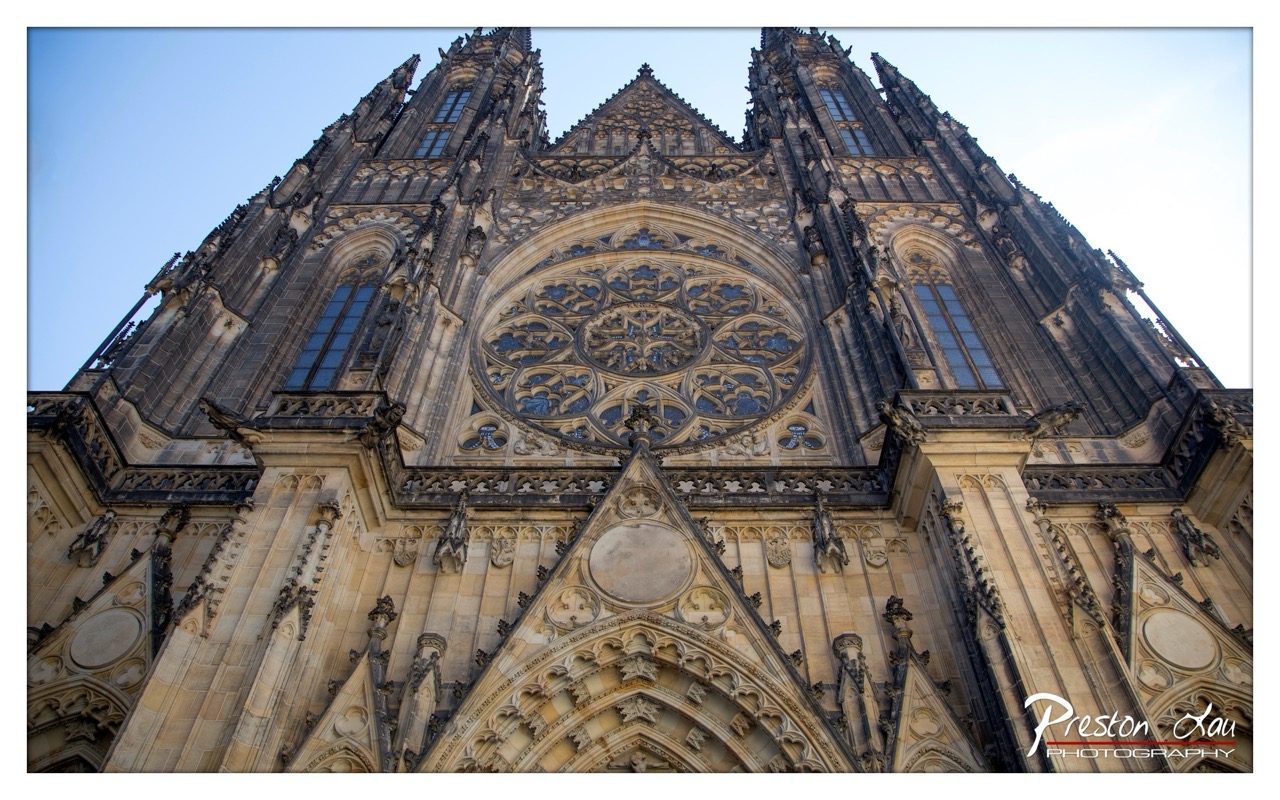

1. Overall Rating (0–10) — 8.0
This photograph captures the awe-inspiring grandeur of a Gothic cathedral with a powerful sense of verticality and intricate architectural detail. The low-angle perspective enhances the monumentality of the structure, while the clear sky provides a serene backdrop that allows the stone carvings and rose window to stand out. The image succeeds in conveying both the scale and the delicate craftsmanship of the building, though the slight overexposure in the sky tempers its overall atmospheric depth.
2. Composition (0–10) — 8.5
The low-angle framing creates a dramatic upward perspective, emphasizing the cathedral’s height and dominance. The symmetrical arrangement of the towers and rose window anchors the composition, while the slight tilt adds dynamic tension without disrupting balance.
3. Lighting (0–10) — 7.5
Natural daylight illuminates the façade evenly, highlighting the textures of the stone and the complexity of the Gothic detailing. The soft, directional light from the side enhances depth and form, though the bright sky appears slightly washed out.
4. Color & Tone (0–10) — 7.0
The warm beige and gray tones of the stone lend a timeless, historic quality to the image. The blue of the rose window provides a subtle contrast, but the overall palette is restrained, which suits the subject’s solemnity.
5. Creativity (0–10) — 8.0
The choice of angle and framing transforms a familiar architectural subject into a visually compelling statement. The photographer’s intent to evoke reverence through scale and detail is effectively realized.
6. Technical Quality (0–10) — 8.5
Sharp focus across the frame reveals fine architectural details. The image is well-exposed overall, with minimal noise and clean rendering of textures.
7. Emotional Impact (0–10) — 8.0
The photograph inspires a sense of wonder and humility, inviting the viewer to contemplate the artistry and devotion embedded in the structure. The sheer scale and intricate design evoke a quiet reverence.
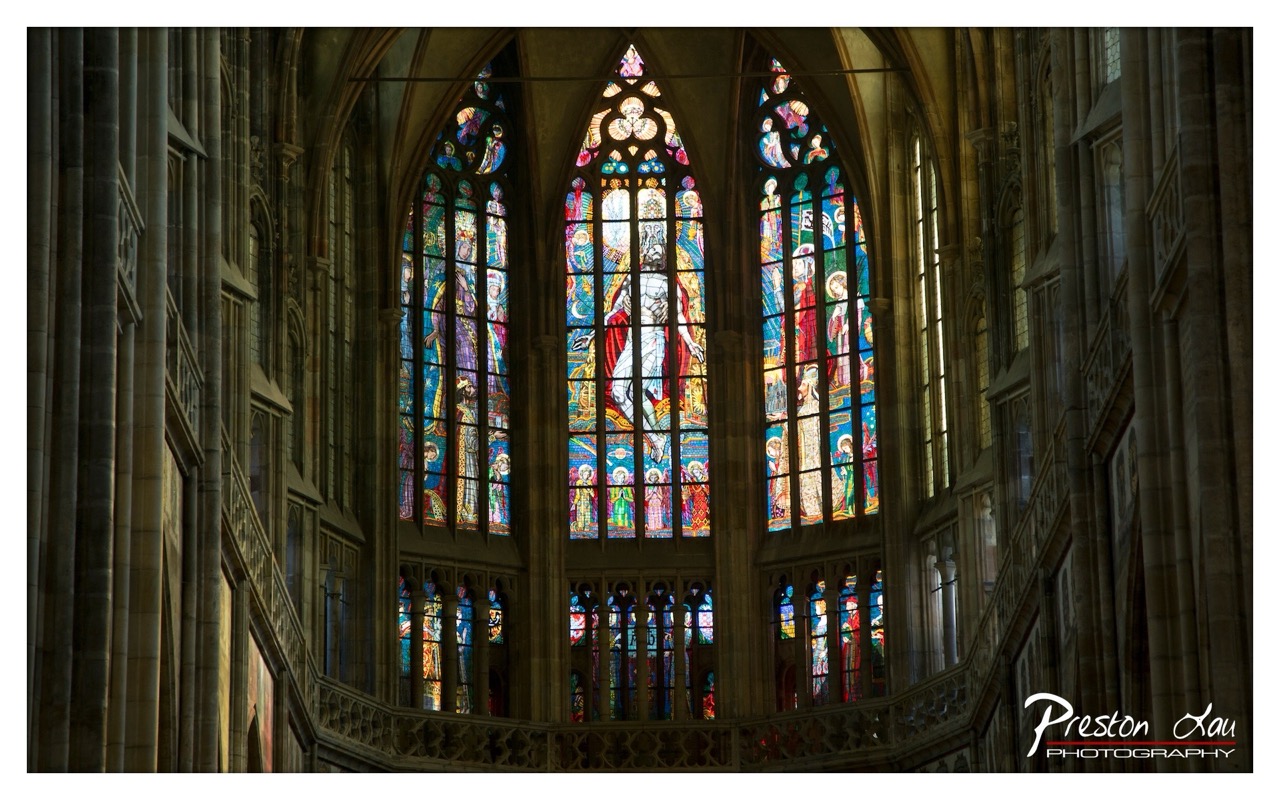

1. Overall Rating (0–10) — 8.0
This photograph captures the transcendent beauty of a Gothic cathedral interior, where light and color converge to evoke reverence and awe. The central stained glass window acts as a luminous focal point, its vibrant hues glowing against the somber stone architecture. While the image is visually compelling, its dramatic contrast risks overwhelming the viewer’s eye, slightly diminishing the sense of quiet contemplation that the space inspires.
2. Composition (0–10) — 8.0
The symmetrical framing centers the stained glass, reinforcing the cathedral’s architectural grandeur. The use of leading lines from the arches and columns draws the eye upward, creating a sense of verticality and spiritual ascent. The balcony railing adds depth and a subtle foreground layer without distracting from the main subject.
3. Lighting (0–10) — 9.0
The interplay of natural light filtering through the stained glass creates a dramatic, almost divine glow, highlighting the intricate details of the artwork. The deep shadows in the surrounding stone emphasize the luminosity of the window, enhancing the image’s atmospheric depth and sacred mood.
4. Color & Tone (0–10) — 9.0
The rich, saturated colors of the stained glass—deep blues, reds, and golds—stand out vividly against the muted, earthy tones of the stone. The contrast between light and shadow amplifies the vibrancy of the colors, creating a visually striking and emotionally resonant palette.
5. Creativity (0–10) — 8.0
The photographer captures a moment of quiet transcendence, transforming a familiar architectural scene into a spiritual experience. The choice to emphasize the contrast between light and shadow adds a layer of dramatic storytelling, elevating the image beyond mere documentation.
6. Technical Quality (0–10) — 8.0
The image is sharp and well-exposed, with fine detail visible in both the stained glass and the surrounding stonework. The focus is precise, and the dynamic range is well-managed, preserving detail in both the bright highlights and the dark shadows.
7. Emotional Impact (0–10) — 9.0
The photograph evokes a profound sense of awe and serenity, inviting the viewer to pause and reflect. The interplay of light, color, and architecture creates a deeply spiritual atmosphere, making the image resonate on both a visual and emotional level.
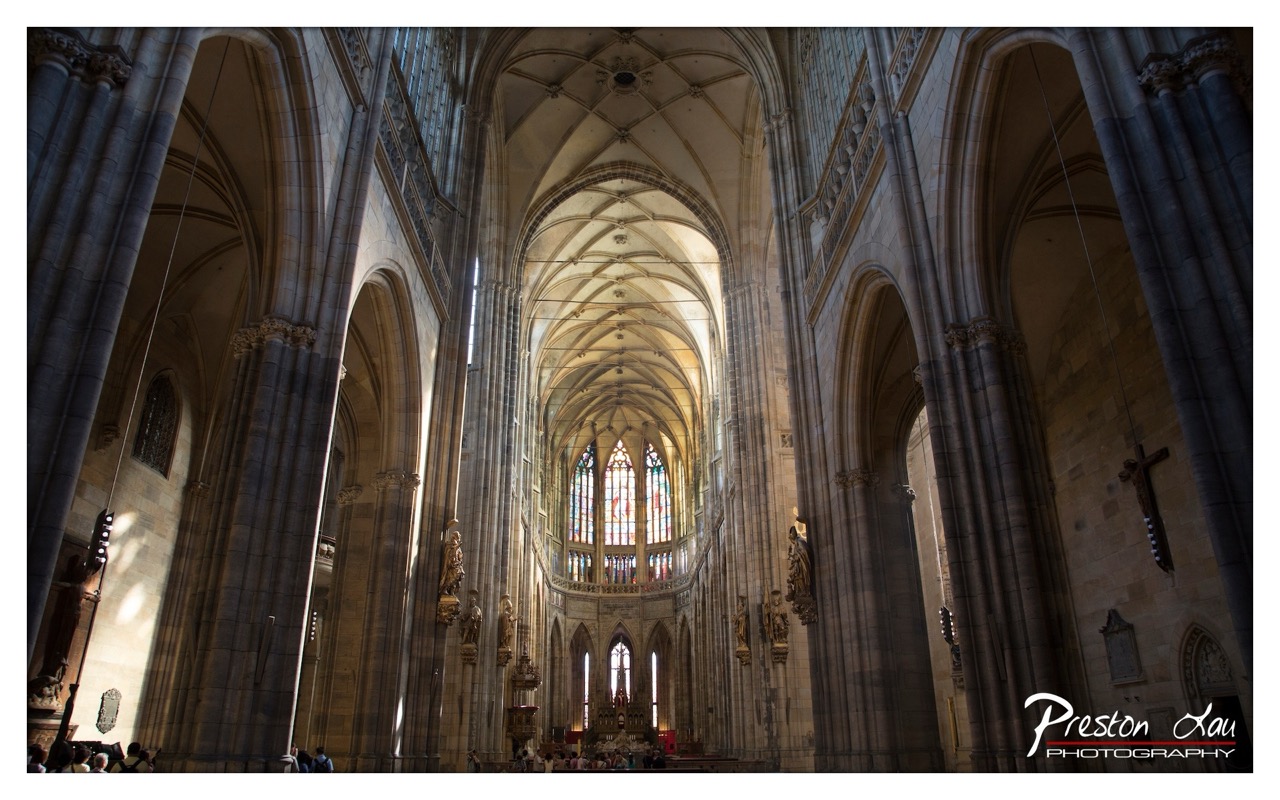

1. Overall Rating (0–10) — 8.0
This photograph captures the awe-inspiring grandeur of a Gothic cathedral, where light and architecture converge to evoke a sense of divine transcendence. The interplay of shadow and sunlight enhances the verticality of the space, drawing the eye upward toward the stained glass at the far end. While the image is rich in architectural detail and spiritual resonance, the low-light conditions introduce a slight softness that tempers its technical crispness.
2. Composition (0–10) — 8.5
The symmetrical framing and strong leading lines of the vaulted arches create a powerful sense of depth and perspective, guiding the viewer’s gaze toward the luminous apse. The placement of the altar and stained glass as a focal point is masterful, while the subtle inclusion of visitors adds scale and human context without distracting from the architectural majesty.
3. Lighting (0–10) — 8.0
The dramatic interplay of natural light filtering through the stained glass and the deep shadows cast by the massive stone columns creates a theatrical, almost sacred atmosphere. The warm glow from the windows contrasts beautifully with the cool tones of the stone, enhancing the sense of space and timelessness.
4. Color & Tone (0–10) — 7.5
The color palette is rich and balanced, with deep earthy tones of the stone offset by the vibrant, multi-hued reflections from the stained glass. The tonal range is strong, from the dark shadows to the bright highlights, contributing to the image’s dramatic depth.
5. Creativity (0–10) — 8.0
The photographer captures the cathedral not merely as a structure but as a living space imbued with history and emotion. The use of light and perspective transforms the architectural details into a narrative of faith and human aspiration, offering a fresh yet respectful interpretation of a well-documented subject.
6. Technical Quality (0–10) — 7.5
The image is sharp and detailed, particularly in the mid-ground, though the extreme contrast between light and shadow results in some loss of detail in the darkest areas. The focus is well-managed, and the camera’s ability to capture the depth of the space is impressive.
7. Emotional Impact (0–10) — 8.5
The photograph evokes a profound sense of reverence and wonder, capturing the quiet solemnity and spiritual weight of the cathedral. The viewer is invited to step into the space and feel the scale, silence, and sacredness that permeate the architecture.


1. Overall Rating (0–10) — 8.0
This photograph captures the breathtaking complexity and spiritual grandeur of a Gothic cathedral rose window, where light and color converge in a radiant symphony. The intricate tracery and vibrant stained glass create a powerful sense of awe, while the deep shadows of the stone architecture provide a dramatic contrast that enhances the window’s luminous core. Though the composition is rich in detail, a slight adjustment in perspective might better emphasize the scale and verticality of the space.
2. Composition (0–10) — 8.0
The circular symmetry of the rose window is framed effectively by the surrounding stone arches, creating a balanced and harmonious composition. The centered placement draws the eye naturally to the heart of the design, while the subtle inclusion of the lower windows adds depth and context.
3. Lighting (0–10) — 8.5
The interplay of natural light filtering through the stained glass creates a dynamic and ethereal glow, with rich, saturated colors emerging from the dark stone. The contrast between the illuminated glass and the shadowed masonry enhances the three-dimensional quality of the scene, emphasizing the window’s intricate design.
4. Color & Tone (0–10) — 9.0
The palette is vibrant and diverse, with a rich array of jewel tones—deep blues, reds, and golds—pulsing with life. The warm, luminous quality of the light enhances the emotional resonance of the colors, creating a sense of transcendence and reverence.
5. Creativity (0–10) — 8.0
The image captures a moment of architectural and spiritual beauty with a clear artistic intent—highlighting the interplay of light, color, and form. The photographer’s choice to frame the window from a low angle enhances its majesty, offering a viewer a sense of reverence and awe.
6. Technical Quality (0–10) — 8.5
The image is sharp and detailed, with excellent clarity in both the stained glass and the stone masonry. The exposure is well-balanced, preserving the brilliance of the glass while retaining texture in the darker areas. The watermark is subtle and does not detract from the composition.
7. Emotional Impact (0–10) — 9.0
The photograph evokes a profound sense of wonder and tranquility, inviting the viewer to contemplate the artistry and devotion behind the cathedral’s creation. The radiant light and intricate design stir a deep emotional response, connecting the viewer to centuries of faith and craftsmanship.
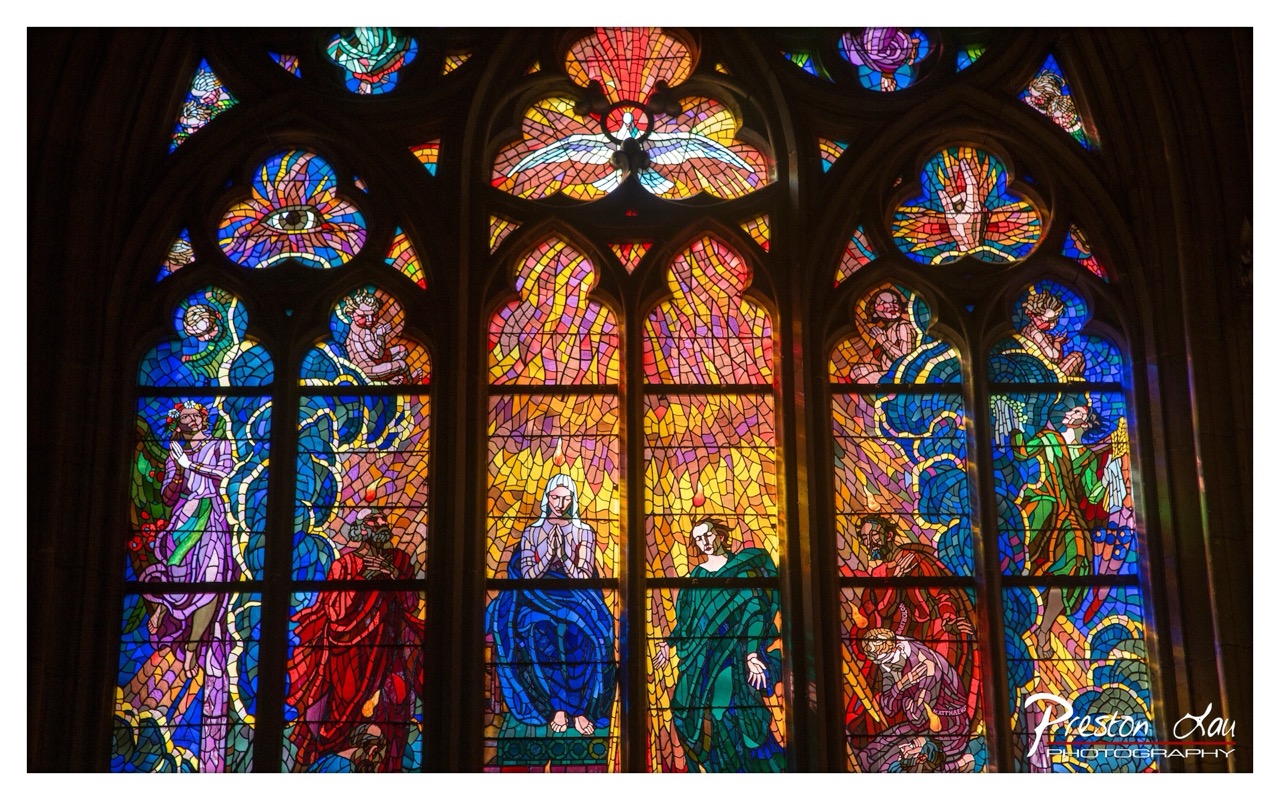

1. Overall Rating (0–10) — 8.5
This photograph captures the radiant splendor of a Gothic stained-glass window with breathtaking clarity and reverence. The interplay of light and color transforms the sacred imagery into a luminous tapestry, evoking a sense of divine presence. While the composition is rich in detail, a slightly tighter crop could further emphasize the central figures and enhance the visual focus.
2. Composition (0–10) — 8.0
The symmetrical arrangement of the stained-glass panels creates a balanced and harmonious frame. The central figures are well-positioned, drawing the eye downward, while the surrounding vignettes add depth and narrative context. The dark stone tracery frames the glass beautifully, enhancing the sense of architectural grandeur.
3. Lighting (0–10) — 9.0
The natural light streaming through the stained glass creates a dramatic and ethereal glow, with warm yellows and vibrant hues illuminating the figures. The contrast between the glowing glass and the deep shadows of the surrounding architecture enhances the depth and mood, capturing the essence of a sacred space.
4. Color & Tone (0–10) — 9.5
The palette is rich and vivid, with a dynamic range of saturated colors that shift from deep blues and purples to fiery oranges and reds. The tonal balance highlights the intricate details of the glasswork, while the overall warmth enhances the spiritual atmosphere.
5. Creativity (0–10) — 9.0
The image transcends mere documentation, transforming the stained glass into a visual hymn of light and color. The photographer’s choice to capture the scene at a moment of intense illumination demonstrates a strong artistic vision, inviting contemplation and awe.
6. Technical Quality (0–10) — 8.5
The image is sharp and detailed, with precise focus on the glasswork. The exposure is well-managed, preserving the brightness of the illuminated areas while retaining texture in the shadows. The watermark is discreet and unobtrusive.
7. Emotional Impact (0–10) — 9.0
The photograph evokes a profound sense of reverence and wonder, capturing the spiritual essence of the cathedral. The viewer is drawn into the scene, feeling the weight of tradition and the quiet power of faith embodied in the radiant glass.
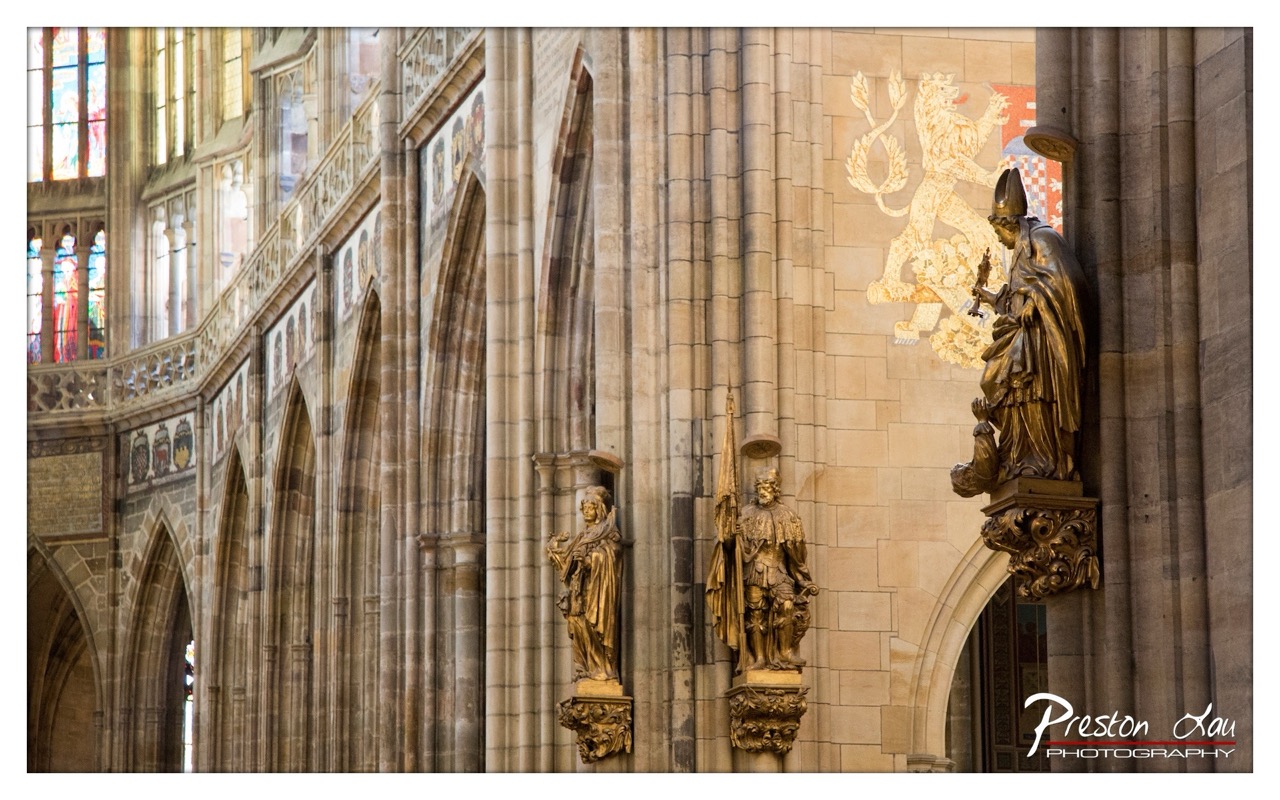

1. Overall Rating (0–10) — 7.5
This photograph captures the grandeur and intricate detail of a Gothic cathedral interior, where light, architecture, and sacred art converge in a moment of quiet reverence. The warm golden tones of the statues contrast beautifully with the cool stone of the nave, creating a sense of timeless solemnity. While the image is rich in texture and historical weight, the composition feels slightly cluttered, with too many elements competing for attention, reducing the overall visual harmony.
2. Composition (0–10) — 6.5
The frame includes multiple statues and architectural elements, leading to a visually busy scene. A tighter focus on a single statue or a more deliberate alignment of the vertical lines would improve balance and guide the viewer’s eye more effectively.
3. Lighting (0–10) — 7.0
Natural light filters through the stained glass, casting soft, colorful highlights that enhance the depth and mood of the space. The interplay between the golden statues and the ambient light creates a subtle luminosity, though some areas remain underexposed due to the cathedral’s shadowed interior.
4. Color & Tone (0–10) — 7.5
The warm, golden hues of the statues stand out against the muted beige and gray of the stone, creating a rich tonal contrast. The stained glass adds pops of vibrant color, though their effect is somewhat subdued in the overall palette. The tonal range is well-managed, giving the image a painterly quality.
5. Creativity (0–10) — 7.0
The photograph successfully captures the spiritual and historical atmosphere of the cathedral, emphasizing its architectural and artistic grandeur. The choice to include multiple statues and the crest adds narrative depth, though the execution leans more toward documentation than conceptual storytelling.
6. Technical Quality (0–10) — 8.0
Sharp focus and clear detail are evident throughout the image, particularly in the carved figures and stonework. The exposure is balanced despite the challenging lighting conditions, and the resolution captures fine textures with precision.
7. Emotional Impact (0–10) — 7.0
The image evokes a sense of awe and contemplation, inviting the viewer to reflect on the craftsmanship and devotion embedded in the space. The quiet dignity of the statues and the play of light contribute to a meditative mood, though the lack of a strong focal point slightly diminishes the emotional pull.


1. Overall Rating (0–10) — 8.0
This photograph captures the grandeur and intricate craftsmanship of a Gothic cathedral facade, where stone carvings tell a sacred narrative with timeless authority. The composition centers on a deeply detailed relief, drawing the eye into the emotional intensity of the scene, while the surrounding architecture provides a rich, textured frame. Though the image is technically strong, a slight lack of dramatic lighting tempers its full visual impact, leaving the scene grounded in clarity but not quite soaring into the sublime.
2. Composition (0–10) — 8.5
The central relief is perfectly framed within the pointed arch, creating a natural focal point that harmonizes with the surrounding Gothic geometry. The symmetry and vertical emphasis guide the viewer’s gaze upward, reinforcing the spiritual intent of the architecture. The slight off-center placement of the sculptural group adds subtle dynamism without disrupting balance.
3. Lighting (0–10) — 6.5
Soft, diffused daylight evenly illuminates the stone, preserving the depth of the carvings while avoiding harsh shadows. However, the lack of directional light—such as golden-hour warmth or dramatic contrast—limits the sense of drama, resulting in a more documentary feel than a cinematic one.
4. Color & Tone (0–10) — 7.5
The warm, honeyed tones of the sandstone lend a dignified, ancient quality to the image. The subtle variations in tone across the relief enhance the sense of depth, while the muted palette supports the solemn mood. A touch more contrast could have intensified the visual drama.
5. Creativity (0–10) — 7.0
The photograph succeeds in capturing a moment of architectural and spiritual significance, but its approach is more observational than interpretive. The choice to isolate the sculptural narrative within its architectural context is effective, yet the image leans toward documentation rather than reimagining the scene.
6. Technical Quality (0–10) — 9.0
Exceptional sharpness and clarity reveal the intricate details of the stonework, from the folds of the robes to the delicate tracery of the arches. The focus is precise, and the exposure is well-balanced, showcasing the texture and form of the stone with precision.
7. Emotional Impact (0–10) — 7.5
The image evokes a sense of reverence and contemplation, inviting the viewer to reflect on the devotion and artistry embedded in the stone. The solemnity of the figures, combined with the enduring presence of the structure, creates a quiet emotional resonance that lingers.
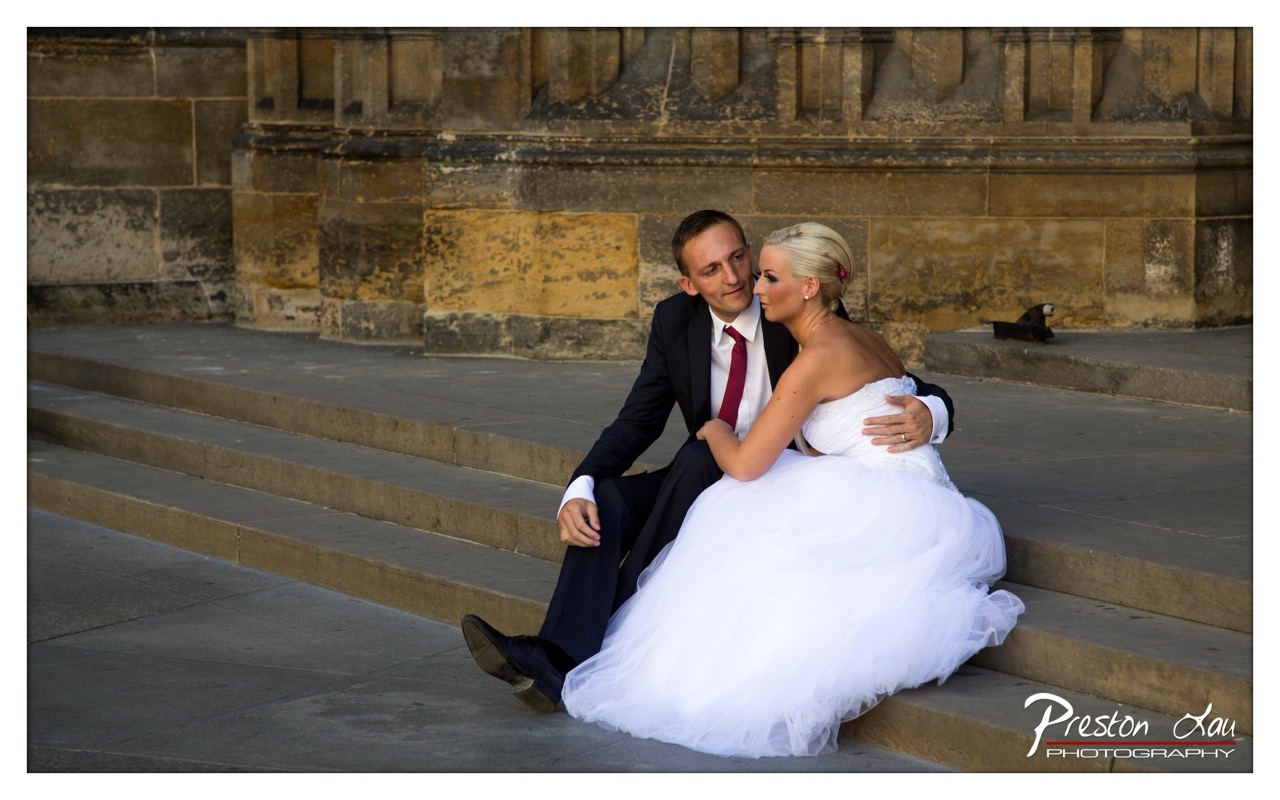

1. Overall Rating (0–10) — 7.5
This photograph captures an intimate and tender moment between a bride and groom, set against the timeless backdrop of a stone building. The warm, golden light enhances the romantic mood, while the couple’s natural pose conveys genuine affection. Though the image is visually strong and emotionally resonant, the slightly cluttered background and uneven lighting slightly detract from its overall elegance.
2. Composition (0–10) — 7.0
The couple is positioned slightly off-center, creating a dynamic yet balanced composition. The diagonal lines of the steps lead the eye toward the subjects, while the architectural background adds depth and context without overwhelming the frame.
3. Lighting (0–10) — 8.0
The soft, directional sunlight creates a warm, golden glow that highlights the couple’s faces and the texture of the bride’s dress. The interplay of light and shadow adds dimension and enhances the romantic atmosphere.
4. Color & Tone (0–10) — 7.5
The warm, earthy tones of the stone contrast beautifully with the bride’s white gown and the groom’s dark suit. The color palette is harmonious and enhances the timeless, romantic feel of the image.
5. Creativity (0–10) — 7.0
The image successfully blends classic wedding portraiture with a natural, candid feel. The choice of location and timing of the shot contribute to a sense of authenticity and storytelling.
6. Technical Quality (0–10) — 8.0
The focus is sharp on the couple, with clear details in the fabric of the dress and the groom’s suit. The exposure is well-managed, preserving detail in both highlights and shadows.
7. Emotional Impact (0–10) — 8.5
The image conveys deep intimacy and affection, drawing the viewer into a quiet, personal moment. The couple’s expressions and body language evoke warmth and tenderness, making the photograph emotionally compelling.
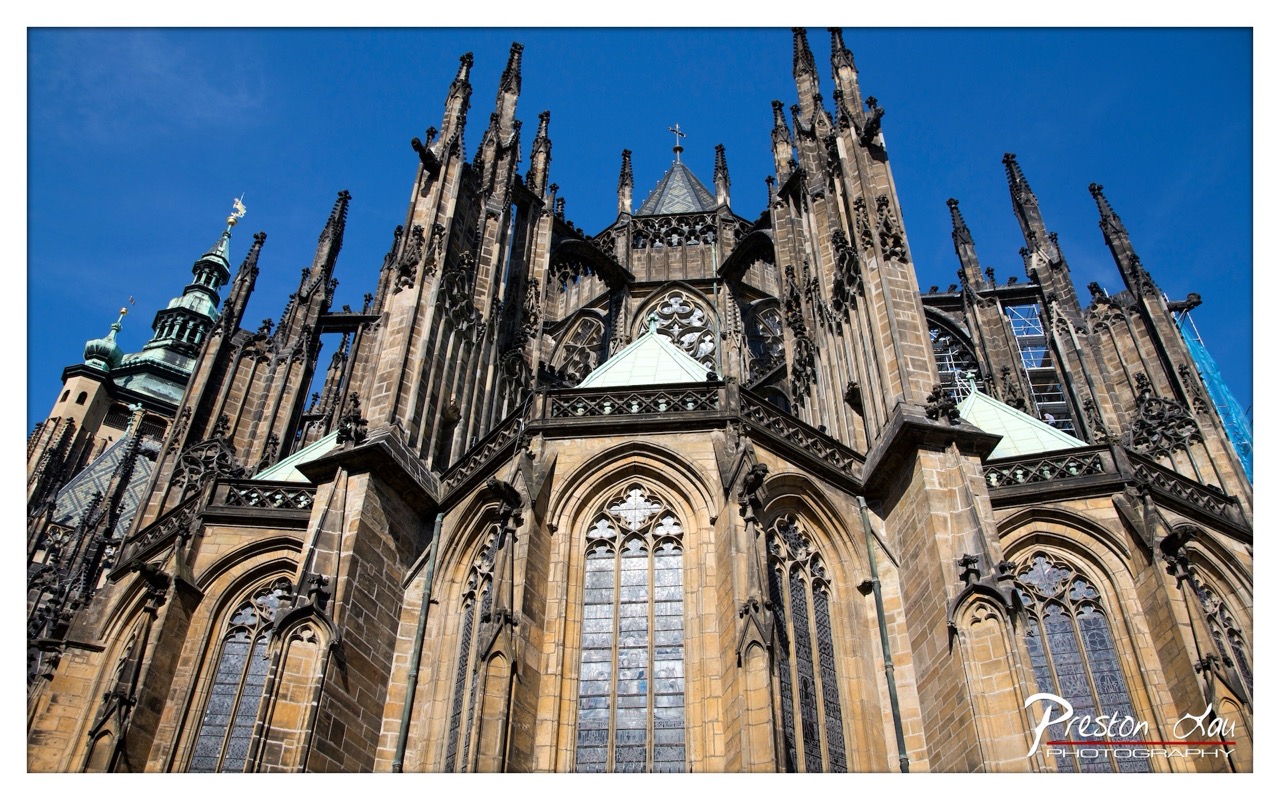

1. Overall Rating (0–10) — 8.0
This photograph captures the soaring grandeur of a Gothic cathedral with striking clarity and reverence, emphasizing its architectural complexity against a vivid blue sky. The low-angle perspective enhances the sense of awe, while the contrast between the warm stone and the cool sky creates a powerful visual harmony. A slight overexposure in the sky and a cluttered composition near the top detract from its otherwise majestic presence.
2. Composition (0–10) — 7.5
The low-angle framing effectively emphasizes the verticality and scale of the cathedral, drawing the eye upward toward the spires. However, the left side feels slightly unbalanced due to the inclusion of the green-topped tower, which disrupts the symmetry and introduces a visual distraction.
3. Lighting (0–10) — 8.0
Strong, direct sunlight highlights the texture and depth of the stonework, enhancing the intricate carvings and tracery. The clear blue sky provides a dramatic backdrop, though the intensity of the light slightly flattens the shadows on the facade.
4. Color & Tone (0–10) — 8.5
The rich, warm tones of the stone contrast beautifully with the deep blue of the sky, creating a vibrant and dynamic palette. The subtle green of the copper roofs adds a touch of tonal variety, enhancing the overall visual richness.
5. Creativity (0–10) — 8.0
The choice of perspective and timing reflects a strong artistic intent to convey the cathedral’s spiritual and architectural dominance. The inclusion of modern scaffolding on the right subtly juxtaposes history with ongoing preservation, adding narrative depth.
6. Technical Quality (0–10) — 8.5
Sharp focus and excellent detail across the frame highlight the craftsmanship of the architecture. The exposure is well-managed overall, though the sky shows signs of slight overexposure, losing some cloud detail.
7. Emotional Impact (0–10) — 8.5
The image evokes a profound sense of reverence and wonder, capturing the timeless majesty of the cathedral. The bold composition and rich colors invite contemplation, making the viewer feel both small and inspired in the face of such grandeur.
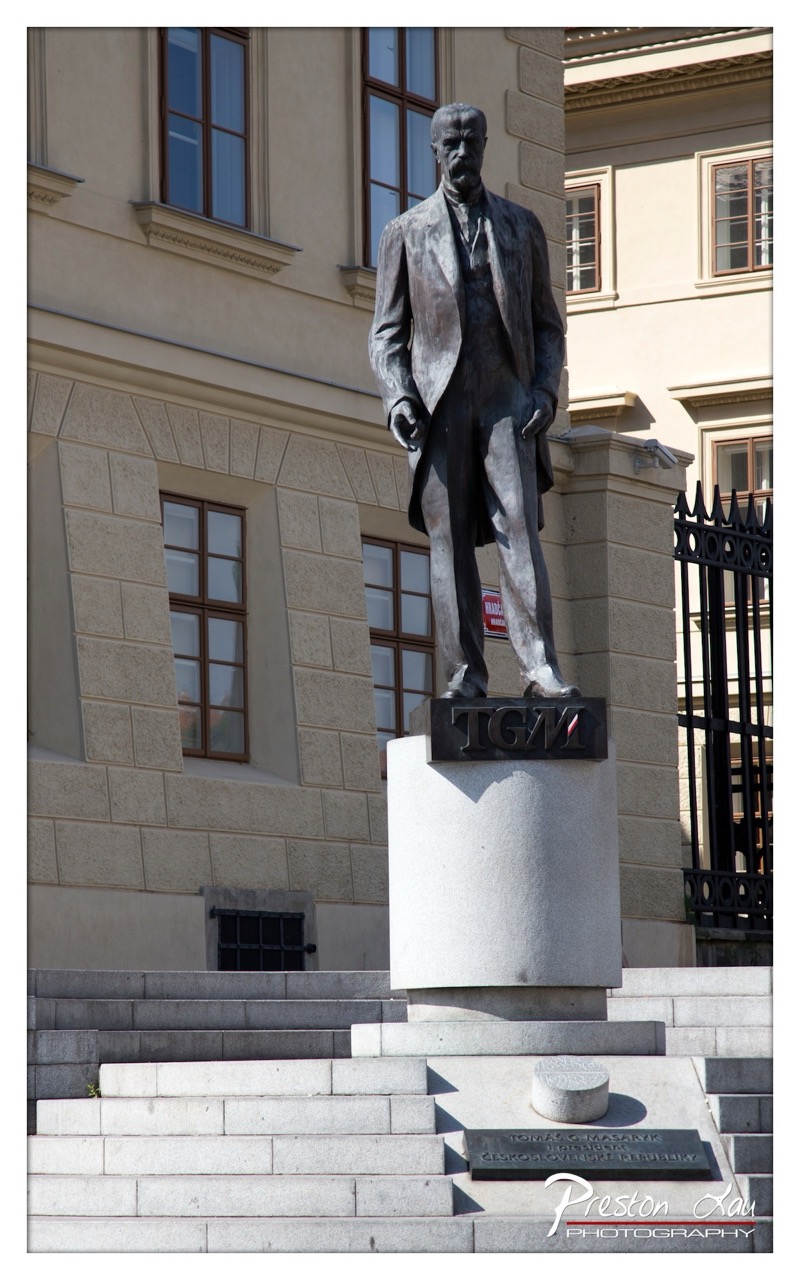

1. Overall Rating (0–10) — 7.0
This photograph captures a solemn monument with a strong sense of historical gravitas, anchored by the imposing bronze statue and classical architecture. The composition effectively frames the subject, and the clear daylight enhances the monument’s details, though the image feels slightly overexposed in highlights. A more dynamic angle or tighter crop could elevate its artistic impact, but as a documentary record, it succeeds in conveying both the subject and its setting with clarity and respect.
2. Composition (0–10) — 7.0
The statue is centered and well-framed, with the steps leading the eye upward, reinforcing its prominence. The building behind provides context and balance, though the verticality of the structure slightly overwhelms the subject.
3. Lighting (0–10) — 7.5
Natural daylight illuminates the scene evenly, highlighting the texture of the bronze and stone. The bright sun creates strong contrast and sharp shadows, enhancing depth without obscuring key details.
4. Color & Tone (0–10) — 6.5
The palette is restrained—beige stone, dark bronze, and deep shadows—with a slightly washed-out quality in the sky and highlights. The absence of vibrant color suits the monument’s tone but limits visual richness.
5. Creativity (0–10) — 6.0
The image is straightforward and documentary in intent, emphasizing clarity over artistic interpretation. While the subject is compelling, the execution leans toward conventional representation rather than innovative framing or perspective.
6. Technical Quality (0–10) — 8.0
Sharp focus and clean detail are evident throughout, particularly in the statue and inscriptions. The exposure is well-managed despite the bright outdoor conditions, and the watermark is discreet.
7. Emotional Impact (0–10) — 7.0
The photograph evokes a sense of reverence and historical weight, with the solitary figure standing as a quiet witness to time. The stillness of the scene invites contemplation, though the lack of human presence tempers its emotional immediacy.
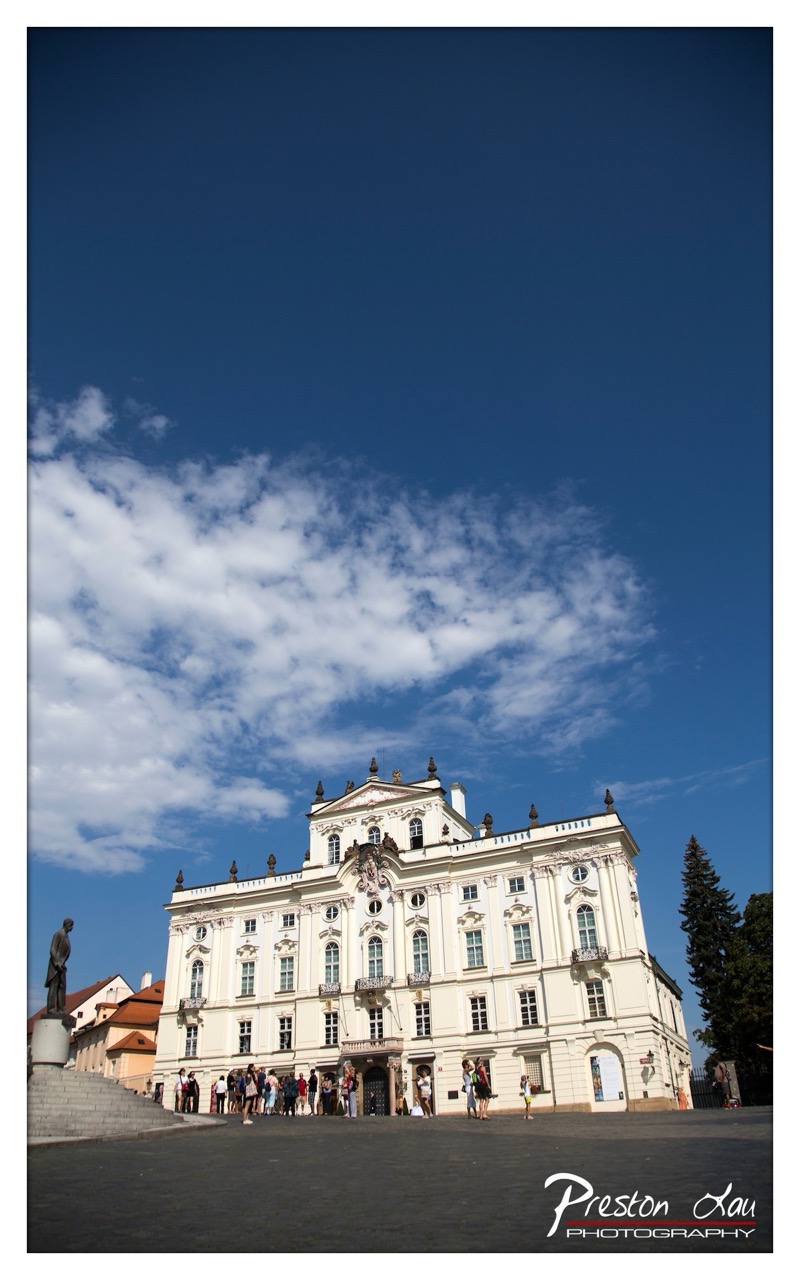

1. Overall Rating (0–10) — 7.5
This photograph captures the grandeur of a Baroque palace under a vast, dynamic sky, evoking a sense of historical majesty and open space. The low-angle perspective amplifies the building’s scale, while the contrast between the bright white façade and the deep blue sky creates a striking visual rhythm. Though the composition is strong, the scattered tourists and statue slightly distract from the architectural purity, softening the image’s overall elegance.
2. Composition (0–10) — 7.0
The low-angle shot emphasizes the building’s verticality and dominance in the frame, while the diagonal sweep of the clouds adds movement. The statue on the left and the crowd at the base create visual anchors, but their placement slightly disrupts the balance.
3. Lighting (0–10) — 8.0
Bright, natural daylight enhances the crispness of the building’s details and the vivid contrast between the white façade and the deep blue sky. The shadows are well-defined, giving the structure a three-dimensional presence.
4. Color & Tone (0–10) — 8.5
The rich, saturated blue of the sky contrasts beautifully with the warm off-white of the palace, creating a vibrant and harmonious palette. The tones are balanced and naturally rendered, enhancing the image’s visual appeal.
5. Creativity (0–10) — 7.5
The photographer’s choice to shoot from a low angle and include the expansive sky adds drama and scale. The inclusion of people grounds the scene in reality, offering a human scale to the monumental architecture.
6. Technical Quality (0–10) — 8.0
The image is sharp and well-focused, with clear details in both the building and the sky. The exposure is well-managed, capturing detail in both highlights and shadows without noticeable noise.
7. Emotional Impact (0–10) — 7.0
The photograph evokes a sense of awe and reverence for historical architecture, enhanced by the open sky and the quiet presence of visitors. It invites contemplation of time, culture, and human achievement.
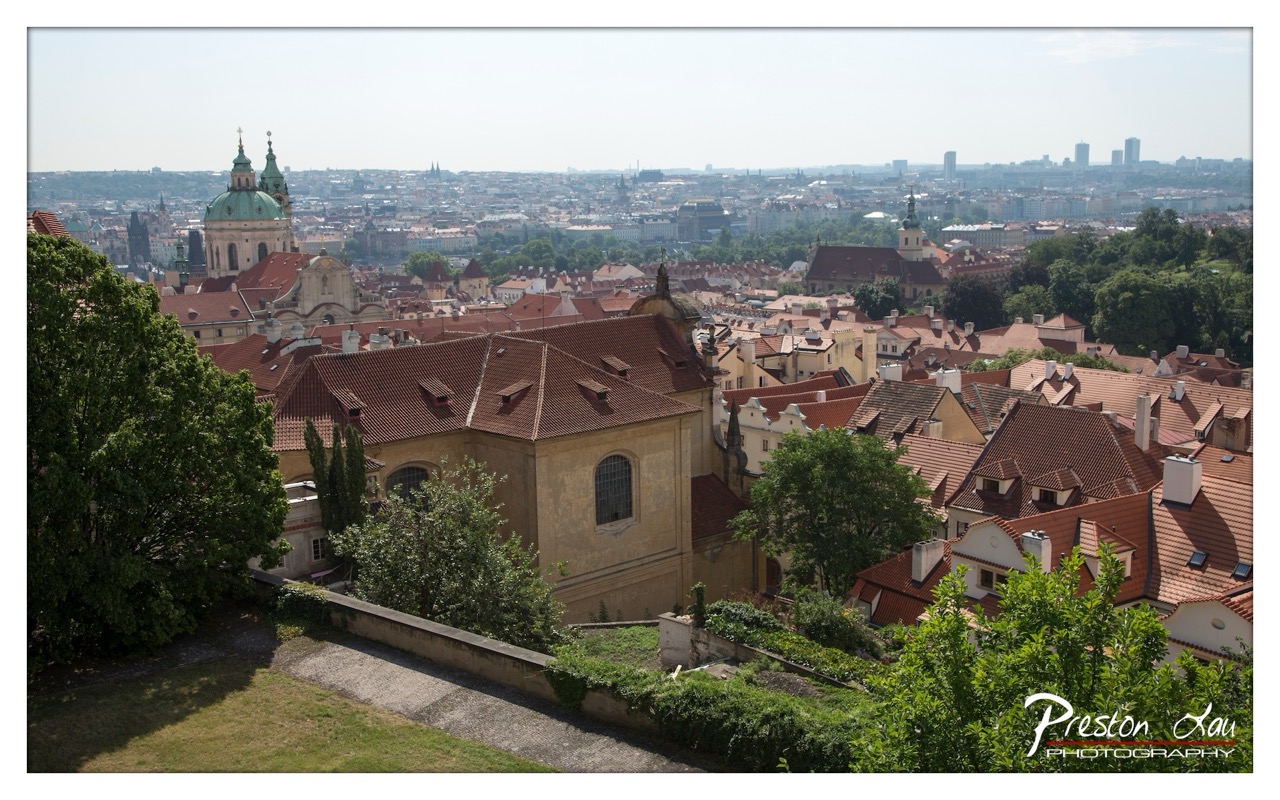

1. Overall Rating (0–10) — 7.0
This panoramic view of a historic European city unfolds with a sense of timelessness, where ancient rooftops and domed spires merge with the modern skyline in the distance. The image captures the layered beauty of urban evolution, though the slightly overexposed sky and crowded foreground detract from its visual cohesion. While it effectively conveys the city’s architectural density and historical depth, it feels more like a travel snapshot than a fully realized artistic statement.
2. Composition (0–10) — 6.5
The frame is anchored by the foreground building and trees, which provide depth and a natural vantage point, but the sheer number of elements creates visual clutter. The central dome draws the eye, but the composition lacks a clear focal path, with the eye wandering across the scene without a dominant narrative thread.
3. Lighting (0–10) — 6.0
The bright daylight flattens details on the buildings and washes out the sky, resulting in a high-contrast scene with lost tonal nuance. While the exposure is generally balanced, the harshness of the sun reduces texture and atmospheric subtlety.
4. Color & Tone (0–10) — 6.5
The warm terracotta roofs dominate the palette, creating a cohesive and inviting color harmony. However, the overall tone leans slightly toward a flat, washed-out appearance due to the bright lighting, limiting the richness of the colors.
5. Creativity (0–10) — 7.0
The perspective offers a compelling juxtaposition of old and new, capturing a moment of urban continuity. The image is thoughtful in its framing and storytelling, though it relies more on the subject’s inherent beauty than on innovative photographic technique.
6. Technical Quality (0–10) — 7.5
The image is sharp and detailed, particularly in the midground structures, and the focus is consistent across the scene. The watermark is cleanly integrated, and the exposure, while imperfect, remains technically sound.
7. Emotional Impact (0–10) — 6.5
The photograph evokes a sense of wonder and quiet contemplation, inviting the viewer to imagine life within the city’s historic walls. While the emotional resonance is strong, the lack of a singular emotional focus keeps the experience somewhat detached.
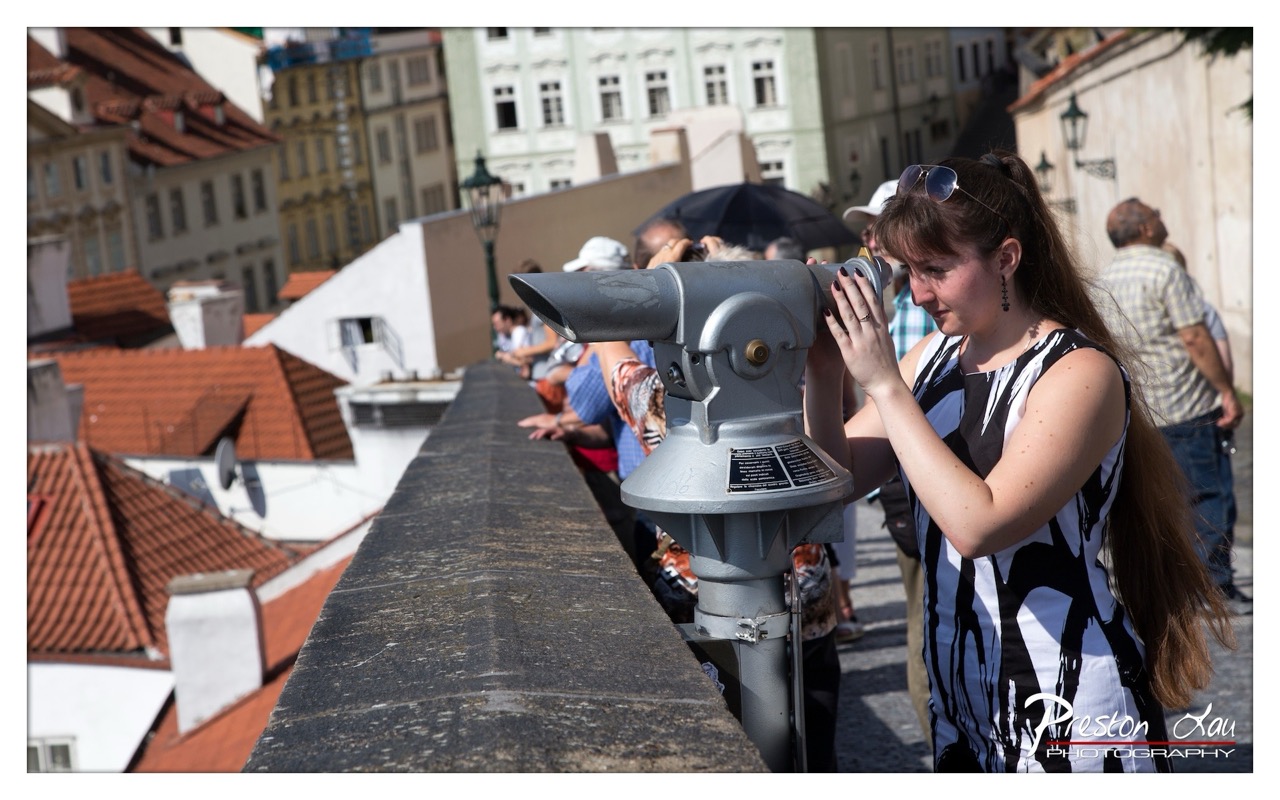

1. Overall Rating (0–10) — 7.0
This photograph captures a candid moment of a woman using a coin-operated telescope on a historic city overlook, evoking a sense of travel, curiosity, and quiet exploration. The natural sunlight and layered background of old European architecture lend the scene authenticity and narrative depth. While the composition is strong, the shallow depth of field slightly undermines the full context of the bustling environment, leaving some visual tension between focus and clarity.
2. Composition (0–10) — 7.5
The woman is positioned off-center, creating a dynamic diagonal with the stone railing that leads the eye into the frame. The background buildings add depth and context, though the slightly cluttered background risks distracting from the primary subject.
3. Lighting (0–10) — 8.0
Bright, natural sunlight enhances the scene’s clarity and warmth, casting soft shadows that define form and texture. The high contrast between light and shadow adds dimension, particularly on the woman’s face and the telescope.
4. Color & Tone (0–10) — 7.0
The warm tones of the red-tiled roofs contrast beautifully with the cool grays of the stone and the woman’s black-and-white dress. The color palette feels authentic to a sunny European day, though the slight overexposure in the background reduces subtle tonal gradations.
5. Creativity (0–10) — 7.5
The image successfully captures a slice of life with a strong sense of place and time. The use of a public telescope as a focal point adds narrative intrigue, suggesting a story of discovery and connection to the city’s history.
6. Technical Quality (0–10) — 8.0
Sharp focus on the woman and the telescope ensures clarity, while the shallow depth of field effectively isolates the subject. The image is well-exposed, with clean detail and minimal noise.
7. Emotional Impact (0–10) — 7.0
The photograph conveys a quiet, introspective moment of engagement—someone pausing to observe the world from a new perspective. The viewer is invited to imagine what lies beyond the telescope’s lens, creating a subtle emotional resonance with curiosity and wonder.


1. Overall Rating (0–10) — 7.0
This photograph captures a lively street performance with a sense of authenticity and movement, set against the backdrop of an ornate gate and historic architecture. The musicians are engaged in their craft, and the passerby’s interaction adds a narrative layer, grounding the scene in everyday life. While the image is rich in detail and context, the composition feels slightly crowded, and the lighting, though clear, lacks dramatic flair, preventing it from fully transcending a simple snapshot.
2. Composition (0–10) — 6.5
The subjects are well-placed within the frame, with the musicians forming a natural focal point. However, the wide-angle perspective and the inclusion of the two pedestrians on the left create a sense of visual clutter, slightly diluting the central narrative. A tighter crop or more deliberate framing would improve balance and focus.
3. Lighting (0–10) — 6.0
The scene is evenly lit by natural daylight, allowing clear visibility of the subjects and textures in the stone and metalwork. The light is flat and diffuse, lacking strong direction or contrast, which diminishes the sense of depth and mood.
4. Color & Tone (0–10) — 6.5
The palette is balanced, with the warm tones of the wooden instruments and stone complementing the bright colors of the pedestrians’ clothing. The reds and pinks pop against the neutral background, drawing attention, though the overall color temperature leans slightly cool, giving the image a slightly detached feel.
5. Creativity (0–10) — 7.0
The photograph successfully captures a candid moment of street culture, blending music, architecture, and human interaction. The juxtaposition of the ornate setting with the informal performance adds narrative depth, and the inclusion of the audience enhances the sense of spontaneity and authenticity.
6. Technical Quality (0–10) — 7.5
The image is sharp and well-focused, with clean details visible in the instruments, clothing, and architectural elements. The exposure is balanced, and the resolution is high, allowing for fine textures to be appreciated. The watermark is subtle and unobtrusive.
7. Emotional Impact (0–10) — 6.5
The image evokes a sense of urban vitality and cultural expression, inviting the viewer to imagine the sound and rhythm of the music. While the emotional resonance is present, it remains restrained, as the viewer is more observer than participant in the moment.
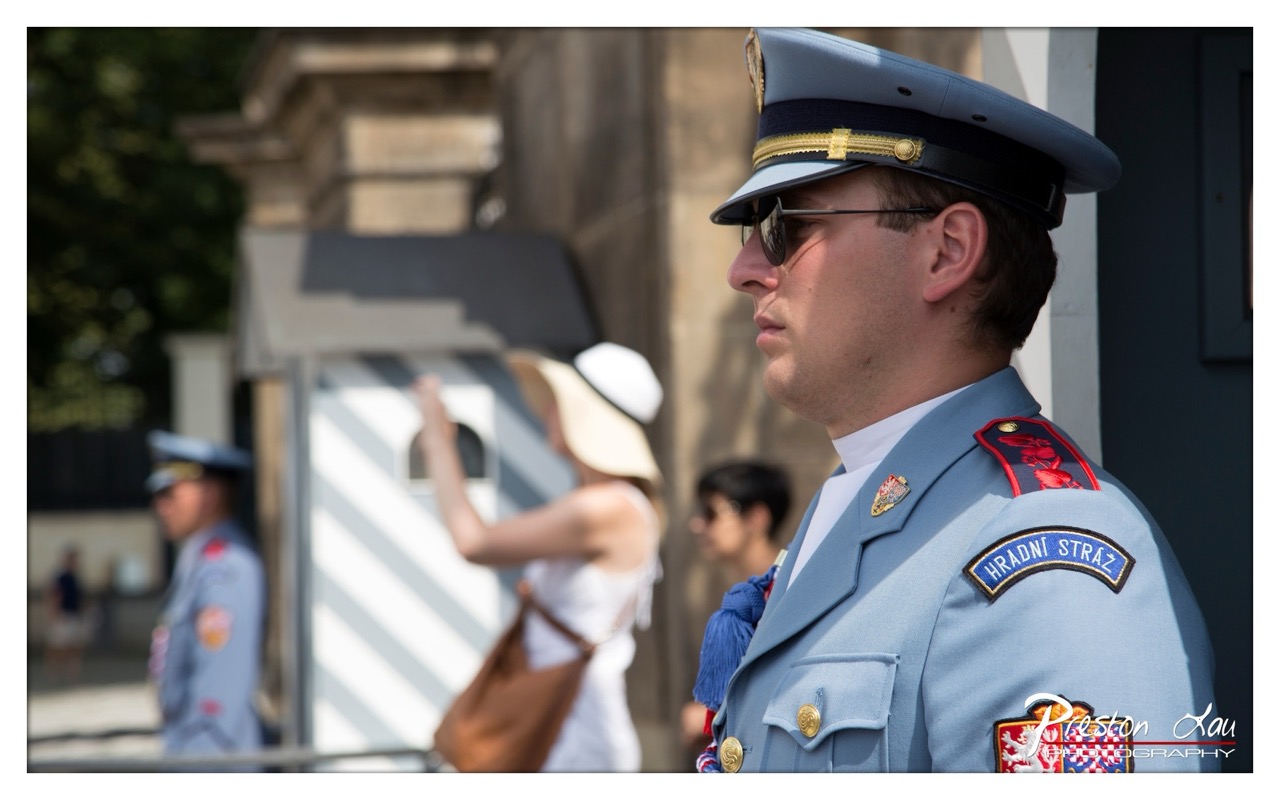

1. Overall Rating (0–10) — 7.5
This photograph captures the solemn dignity of a ceremonial guard in profile, his gaze fixed forward with disciplined poise. The shallow depth of field isolates him from the bustling background, emphasizing his role as a symbol of tradition and order. While the composition is strong and the subject compelling, the slightly overexposed highlights and muted color palette keep it from achieving full visual resonance.
2. Composition (0–10) — 8.0
The subject is placed off-center, following the rule of thirds, which creates a dynamic and balanced frame. The use of shallow depth of field effectively separates the guard from the background, drawing the viewer’s eye directly to his profile and uniform details.
3. Lighting (0–10) — 7.0
Natural daylight illuminates the scene from the side, creating soft shadows that accentuate the guard’s facial structure and uniform texture. However, the bright sunlight causes slight overexposure in the background, reducing detail in the white stripes and the woman’s hat.
4. Color & Tone (0–10) — 7.0
The cool, light blue of the uniform harmonizes with the soft tones of the background, creating a cohesive palette. The red and gold insignia provide a subtle pop of color, but the overall tone is slightly desaturated, giving the image a subdued, almost documentary feel.
5. Creativity (0–10) — 8.0
The photographer captures a moment of quiet authority amidst public life, juxtaposing ceremonial formality with casual passersby. The choice to focus on the guard’s profile, rather than a full frontal view, adds a layer of introspection and narrative depth.
6. Technical Quality (0–10) — 8.5
The image is sharp on the subject, with excellent focus and clarity on the uniform details, insignia, and facial features. The lens choice and aperture were well-suited for isolating the subject and managing depth of field.
7. Emotional Impact (0–10) — 8.0
There is a strong sense of reverence and stillness conveyed through the guard’s composed expression and posture. The contrast between his rigid formality and the blurred, transient figures behind him evokes a contemplative mood, inviting the viewer to reflect on duty, tradition, and the passage of time.
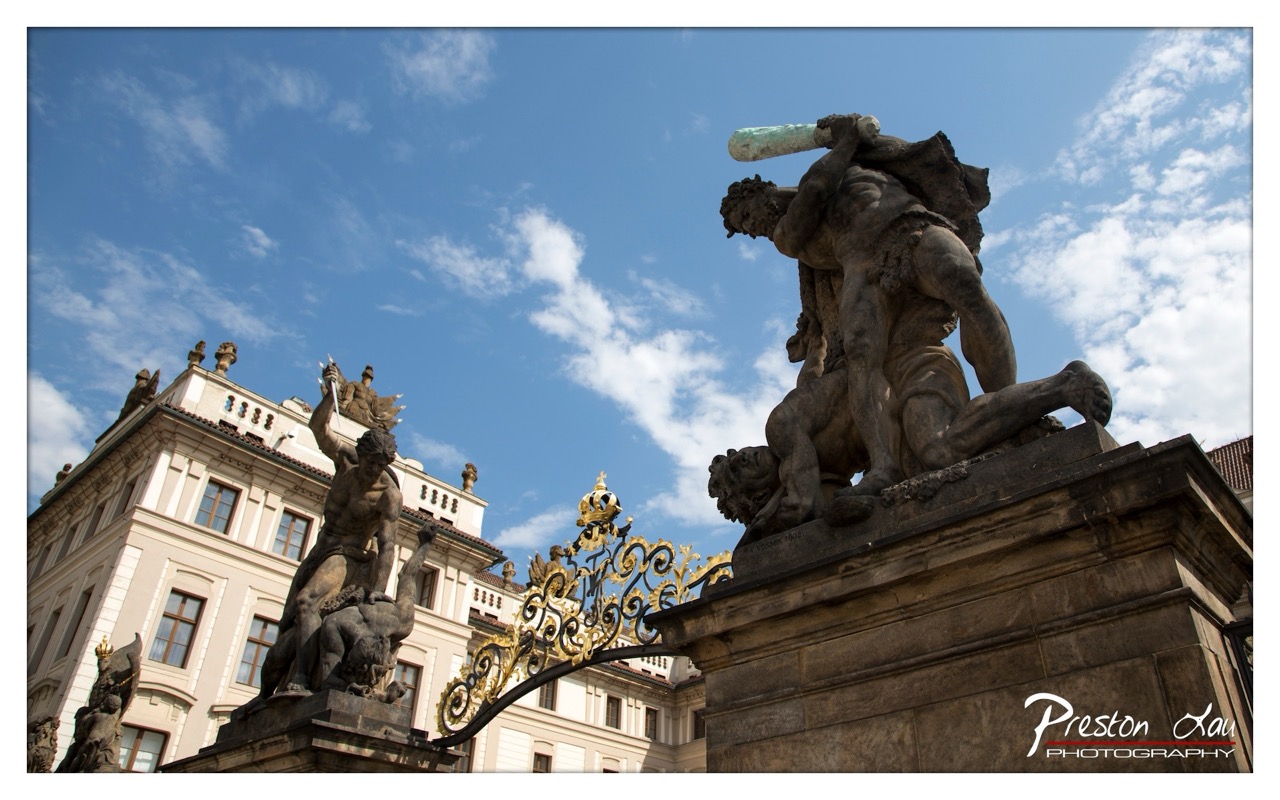

1. Overall Rating (0–10) — 8.0
This photograph captures the grandeur of classical sculpture against a vibrant blue sky, evoking a sense of timelessness and artistic mastery. The low-angle perspective enhances the monumentality of the statues, while the ornate golden gate adds a touch of regal contrast. Though the framing slightly favors the right, the composition still succeeds in conveying the drama and historical weight of the scene.
2. Composition (0–10) — 7.5
The diagonal placement of the statues and the sweeping curve of the gate create dynamic movement. However, the left side feels slightly underdeveloped, with the building’s facade partially obscured, creating an imbalance in visual weight.
3. Lighting (0–10) — 8.5
Bright, natural daylight highlights the textures of the stone and the gleam of the gold accents. The clear sky provides strong contrast, enhancing the depth and three-dimensionality of the sculptural forms.
4. Color & Tone (0–10) — 8.0
The deep blue of the sky complements the earthy tones of the stone and the rich gold of the gate, creating a harmonious palette. The high contrast between light and shadow adds drama without overwhelming the scene.
5. Creativity (0–10) — 8.5
The choice to frame the shot from a low angle and include both the statues and the architectural backdrop tells a story of cultural legacy. The inclusion of the photographer’s watermark adds a subtle personal signature without detracting from the image.
6. Technical Quality (0–10) — 9.0
The image is sharp and well-focused, with fine detail visible in the sculptures and ornamental elements. The exposure is balanced, and there is minimal noise, indicating strong technical execution.
7. Emotional Impact (0–10) — 7.5
The photograph inspires awe and reverence, inviting the viewer to reflect on history and artistry. The sense of scale and permanence evokes a quiet reverence, though the lack of human presence keeps the emotional connection somewhat distant.
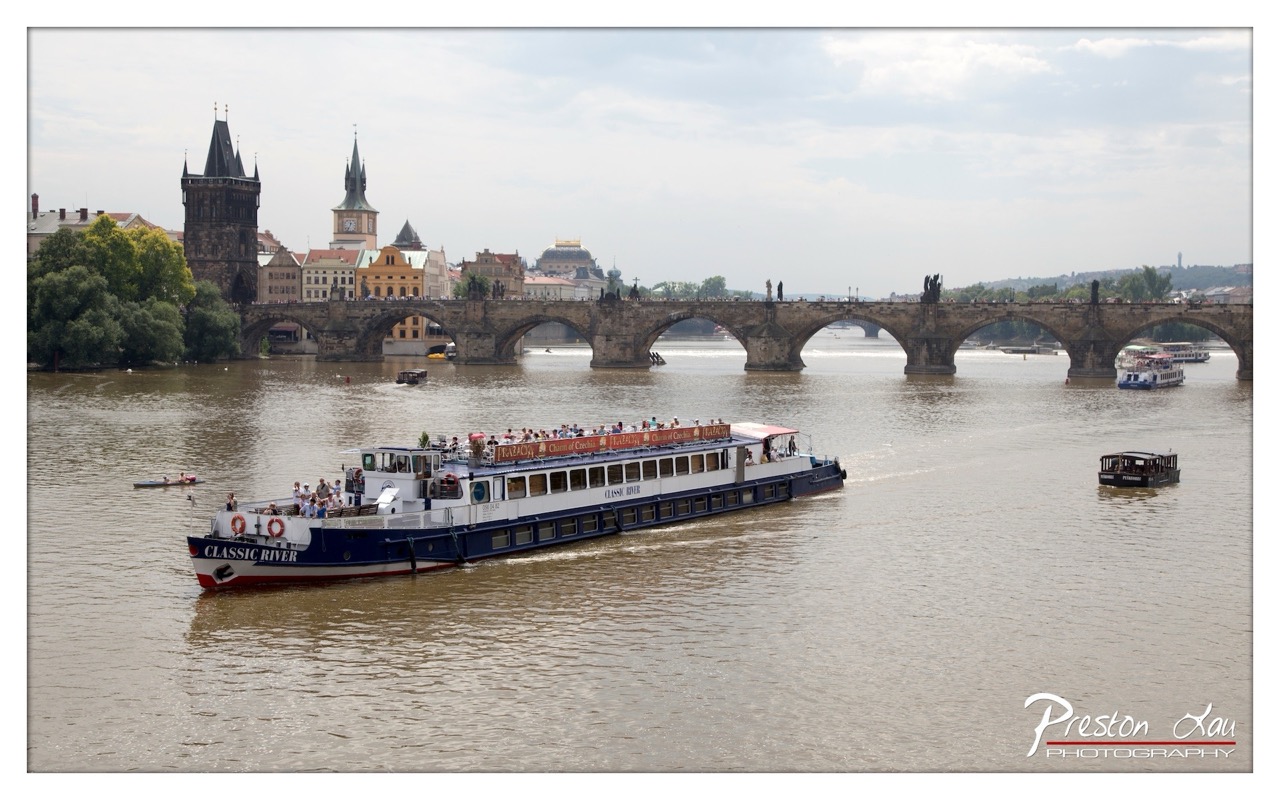

1. Overall Rating (0–10) — 7.0
This photograph captures the timeless elegance of Prague’s Vltava River, where historic architecture and modern tourism converge in a harmonious blend. The presence of the Charles Bridge and the river cruise ship “Classic River” evoke a sense of movement and continuity, while the overcast sky lends a soft, contemplative mood. While the image is visually rich and well-composed, the lack of dramatic light or color intensity keeps it from feeling truly striking, settling instead into the realm of a polished travel document.
2. Composition (0–10) — 7.5
The wide framing effectively captures the scale of the Charles Bridge and the river, with the tour boat anchoring the foreground and guiding the eye toward the architectural backdrop. The bridge’s arches create natural leading lines, and the balanced placement of the boat enhances depth and perspective.
3. Lighting (0–10) — 6.0
The diffused, overcast light softens shadows and ensures even exposure across the scene, which is ideal for architectural clarity. However, the lack of direct sunlight or golden-hour warmth tempers the image’s emotional resonance, giving it a neutral, documentary feel.
4. Color & Tone (0–10) — 6.5
The palette is dominated by muted earth tones—browns, grays, and soft yellows—reflecting the cloudy sky and the river’s sediment. While cohesive, the colors lack vibrancy, resulting in a slightly subdued atmosphere that, while accurate, limits visual dynamism.
5. Creativity (0–10) — 6.0
The image is more observational than expressive, capturing a familiar scene with technical competence. The choice to include the tour boat adds a subtle narrative of tourism and daily life, but the overall approach remains conventional rather than inventive.
6. Technical Quality (0–10) — 8.0
The image is sharp and well-focused, with clean detail visible in both the boat and the distant architecture. The exposure is balanced, and the watermark is discreet, indicating a professional handling of the photograph’s technical aspects.
7. Emotional Impact (0–10) — 6.5
The photograph evokes a quiet sense of place—familiar yet slightly wistful, as if capturing a moment in a city that has seen countless such scenes. It invites reflection on history and movement, but doesn’t elicit a strong emotional response on its own.
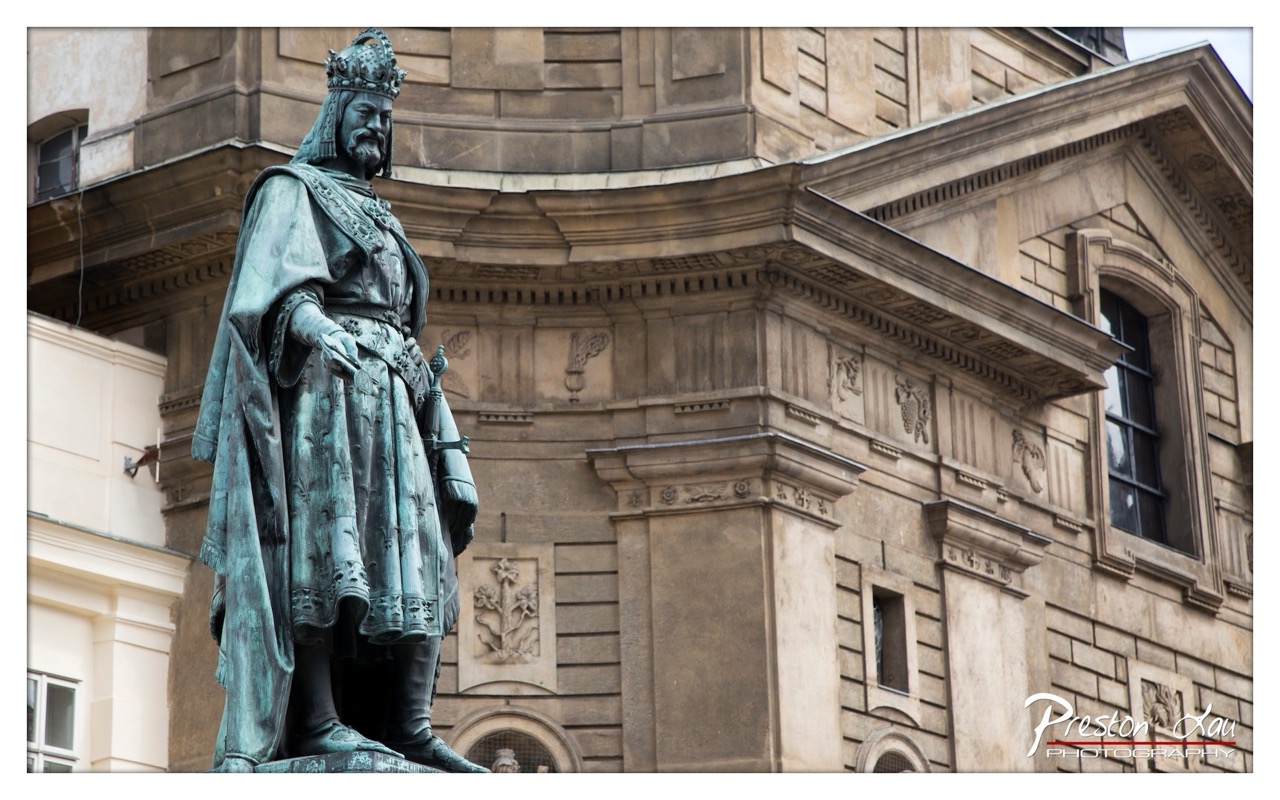

1. Overall Rating (0–10) — 7.5
This photograph captures the solemn grandeur of a historical bronze statue, its verdigris patina contrasting richly with the warm stone of the classical building behind it. The composition balances the figure’s imposing presence with architectural detail, evoking a sense of timelessness and civic pride. While the image is visually compelling, the slightly overexposed sky and muted tones limit its atmospheric depth, leaving room for greater emotional resonance.
2. Composition (0–10) — 8.0
The statue is positioned slightly off-center, creating a dynamic balance with the building’s corner. The strong vertical lines of the architecture guide the eye upward, enhancing the monument’s stature and authority.
3. Lighting (0–10) — 6.5
Natural daylight illuminates the scene evenly, though the sky is slightly blown out, losing detail in the upper portion. The soft, diffused light highlights the texture of the bronze and stone without creating harsh shadows.
4. Color & Tone (0–10) — 7.0
The cool green of the patinated bronze contrasts effectively with the warm beige and tan tones of the building. The color palette is harmonious and historically evocative, though the overall tone leans slightly flat due to limited vibrancy.
5. Creativity (0–10) — 7.5
The photographer captures a classic subject with a thoughtful, grounded approach, emphasizing historical weight and architectural context. The framing suggests a narrative of legacy and permanence, elevating the image beyond mere documentation.
6. Technical Quality (0–10) — 8.0
Sharp focus across the statue and building ensures clarity in both foreground and background. The image is well-exposed overall, with clean detail and minimal noise.
7. Emotional Impact (0–10) — 7.0
The statue’s dignified posture and the timeless architecture evoke a quiet reverence, inviting contemplation of history and leadership. While the mood is respectful and measured, it remains somewhat detached due to the lack of dramatic lighting or narrative tension.


1. Overall Rating (0–10) — 7.5
This photograph captures the grandeur and intricate detail of a Baroque stone sculpture under a dramatic sky, where religious iconography rises with a sense of reverence and timelessness. The low-angle perspective enhances the monumentality of the figures, while the interplay of light and shadow across the weathered stone adds depth and texture. Though the composition is rich in detail, the slight overexposure in the sky and the watermark in the corner slightly detract from the image’s elegance.
2. Composition (0–10) — 8.0
The low-angle shot emphasizes the verticality and scale of the sculpture, drawing the eye upward through the arrangement of figures. The central Virgin and Child dominate the frame, while the surrounding angels and symbolic elements create a balanced, layered composition that guides the viewer’s gaze across the narrative.
3. Lighting (0–10) — 7.0
Natural daylight illuminates the scene with a soft, diffused quality, highlighting the texture and depth of the sculptural details. The contrast between the shadowed recesses and the sunlit surfaces enhances the three-dimensionality of the stone, though the sky appears slightly overexposed, softening its detail.
4. Color & Tone (0–10) — 7.5
The palette is dominated by the muted grays and earth tones of the aged stone, which contrast beautifully with the vibrant blue sky and scattered white clouds. The cool tones lend a solemn, almost ethereal atmosphere, while the subtle warmth in the highlights adds visual interest.
5. Creativity (0–10) — 8.0
The photographer captures a moment of historical and spiritual grandeur with a strong sense of narrative. The choice to frame the sculpture against the dynamic sky introduces a poetic tension between the permanence of stone and the fleeting nature of the clouds, suggesting themes of faith and time.
6. Technical Quality (0–10) — 8.0
The image is sharp and detailed, particularly in the mid-tones of the sculpture. The focus is consistent across the main subjects, and the exposure is well-managed despite the challenging lighting conditions. The watermark, while present, does not significantly impair clarity.
7. Emotional Impact (0–10) — 8.0
The photograph evokes a sense of awe and contemplation, inviting the viewer to reflect on the craftsmanship and devotion behind the monument. The scale and solemnity of the figures, combined with the open sky, create a meditative mood that resonates emotionally.
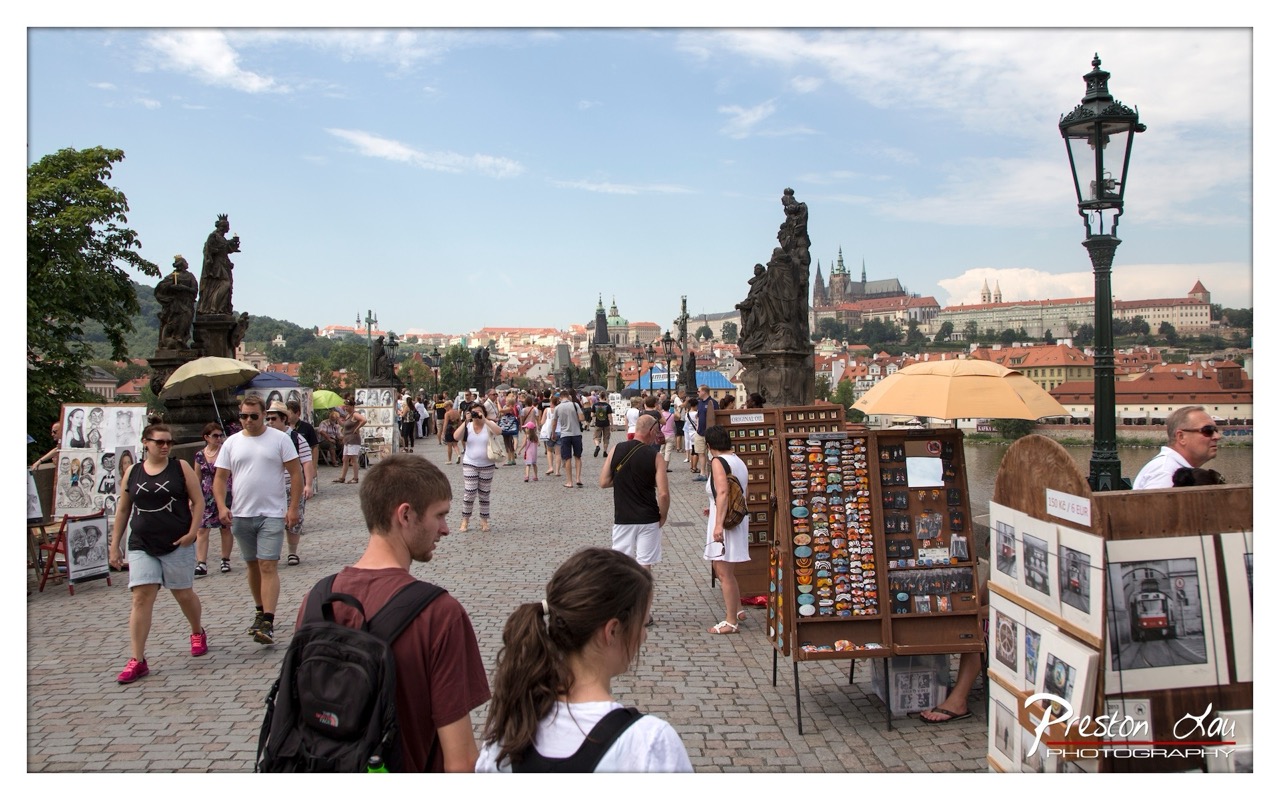

1. Overall Rating (0–10) — 7.0
This photograph captures the lively energy of a historic European bridge bustling with tourists, blending everyday life with architectural grandeur. The composition draws the eye from the foreground vendors to the distant castle, creating a sense of depth and narrative. While the scene is vibrant and full of character, the overexposed sky and cluttered foreground slightly diminish the image’s visual harmony.
2. Composition (0–10) — 7.0
The framing effectively uses leading lines from the cobblestone path and statues to guide the viewer toward the Prague Castle in the distance. The placement of vendors and pedestrians creates a natural sense of movement, though the right side feels slightly crowded, reducing the visual balance.
3. Lighting (0–10) — 6.5
The bright daylight provides even illumination across the scene, but the sky is overexposed, washing out subtle cloud details. The light enhances the textures of the stone and the colors of the souvenirs, though shadows remain soft and lack depth.
4. Color & Tone (0–10) — 7.0
The palette is rich and warm, with the terracotta rooftops and golden sunlight lending a Mediterranean glow. The saturated colors of the souvenir displays contrast nicely with the muted tones of the stone and sky, adding visual interest.
5. Creativity (0–10) — 6.5
The image succeeds in capturing a slice of authentic urban life, merging cultural history with modern tourism. While the concept is strong, the execution leans toward documentation rather than artistic reinterpretation.
6. Technical Quality (0–10) — 7.5
The photograph is sharp and clear, with well-defined details in both the foreground and background. The exposure is generally balanced, though the sky's overexposure is a noticeable flaw.
7. Emotional Impact (0–10) — 6.5
The image evokes a sense of wanderlust and curiosity, inviting the viewer to imagine themselves walking along the bridge. The human presence and cultural context create a relatable, nostalgic atmosphere, though the sheer density of people slightly dilutes the emotional intimacy.
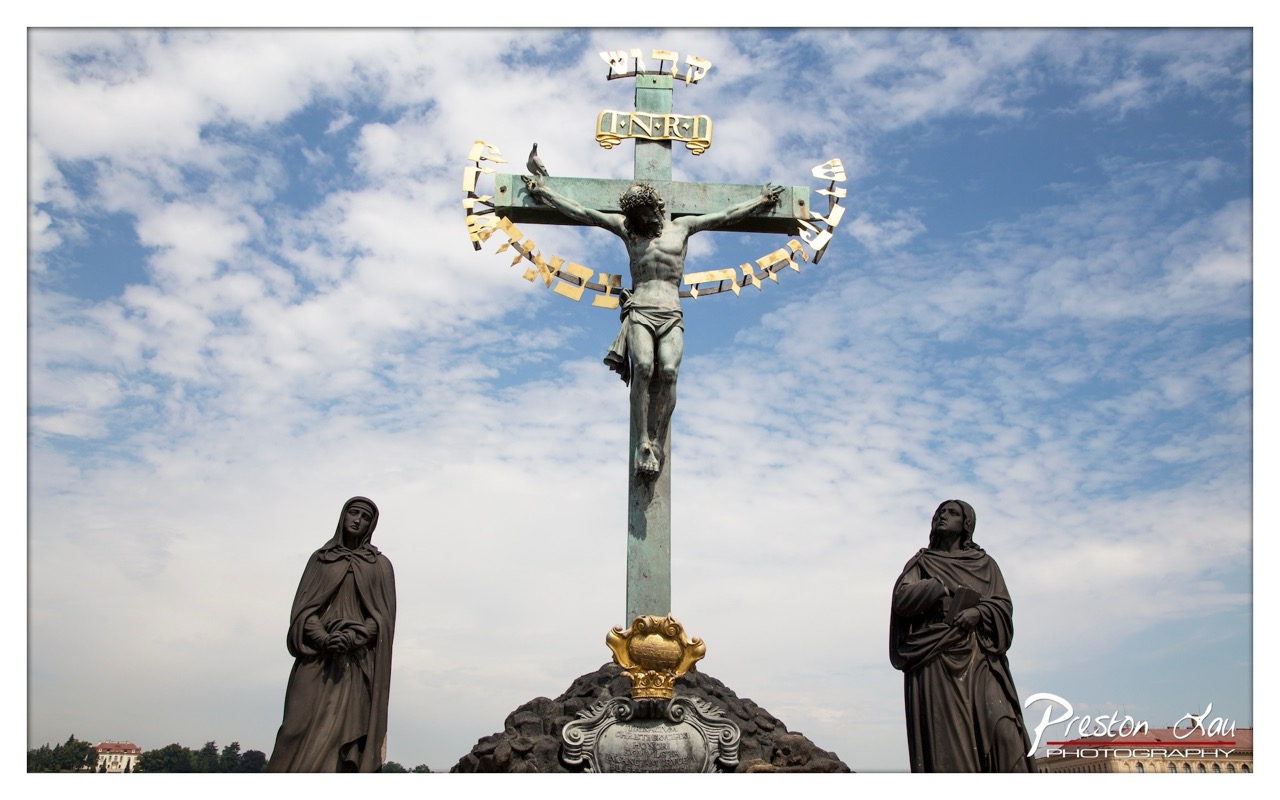

1. Overall Rating (0–10) — 7.5
This photograph captures a powerful religious monument with a sense of solemn grandeur, where the crucifixion sculpture stands as a focal point against a dynamic sky. The composition draws the eye upward, emphasizing the spiritual weight of the scene, while the weathered textures of the bronze figures add a layer of historical authenticity. While the image is visually compelling, the overcast lighting and slightly muted tones temper its emotional resonance, keeping it from achieving a truly transcendent quality.
2. Composition (0–10) — 8.0
The low-angle perspective emphasizes the monument’s verticality and dominance, with the two flanking figures creating symmetry and balance. The crucifix is centered and anchored by the base, while the expansive sky provides a dramatic backdrop, enhancing the monument’s presence.
3. Lighting (0–10) — 6.5
Diffused daylight softens shadows and evenly illuminates the scene, though the overcast conditions reduce contrast and depth. The light is even but lacks the warmth or directional drama that could heighten the mood.
4. Color & Tone (0–10) — 7.0
The muted greens of the bronze cross contrast effectively with the pale blue and white of the sky, while the gold accents on the cross and base provide subtle visual pops. The overall tone is restrained, lending a somber and contemplative atmosphere.
5. Creativity (0–10) — 7.5
The inclusion of the Hebrew inscriptions on the cross adds a unique layer of interfaith symbolism, suggesting a deeper narrative beyond the traditional Christian iconography. This choice elevates the image from a simple documentary shot to a thoughtful commentary on shared heritage.
6. Technical Quality (0–10) — 8.0
The image is sharp and detailed, with clean focus across the entire frame. The depth of field is well-managed, capturing both the foreground sculpture and the distant sky with clarity.
7. Emotional Impact (0–10) — 7.0
The scene evokes a quiet reverence, inviting reflection on sacrifice and faith. The solemn expressions of the figures and the vast sky contribute to a contemplative mood, though the lack of strong lighting or dramatic contrast limits its ability to move the viewer deeply.
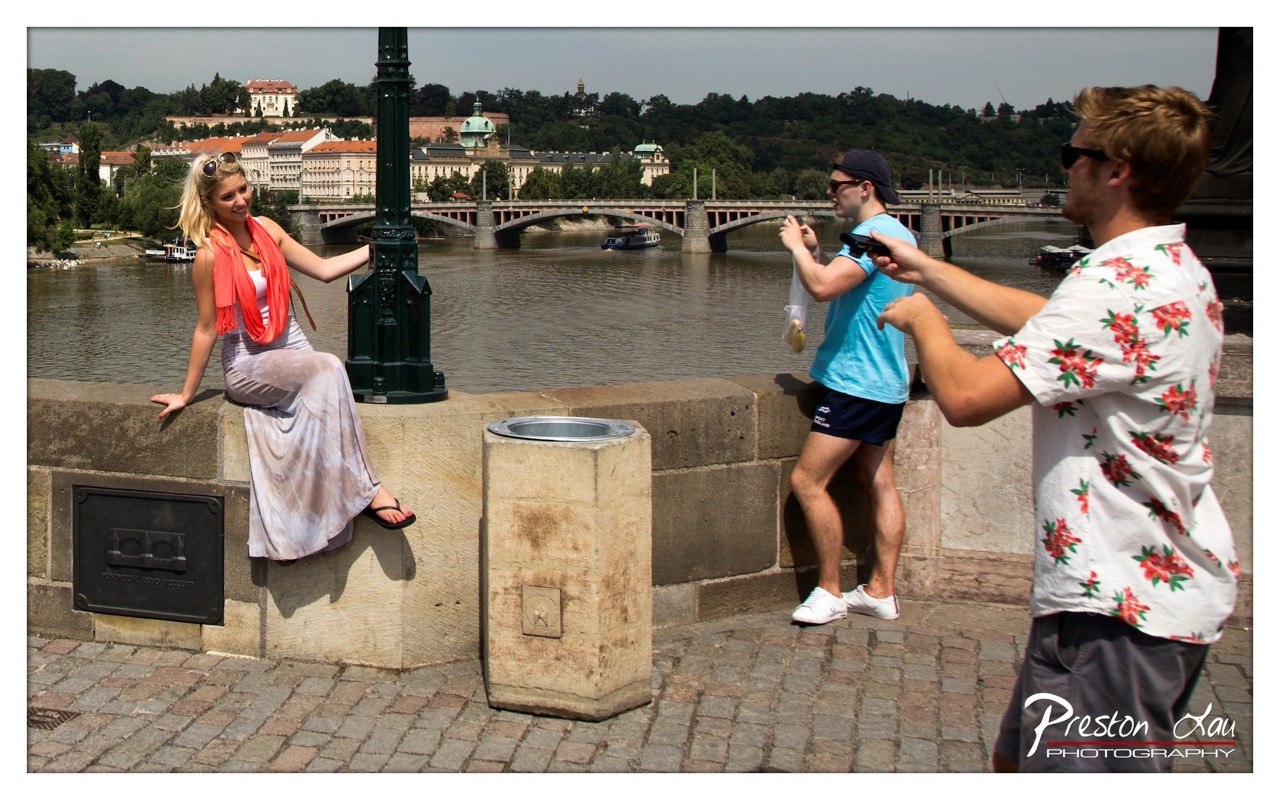

1. Overall Rating (0–10) — 7.0
This photograph captures a candid moment of travel and connection, with a tourist couple engaging in the ritual of capturing memories against a historic European backdrop. The scene is vibrant and authentic, where the energy of the present—sunlight, laughter, and casual dress—contrasts beautifully with the timeless architecture of the river and bridge. While the composition feels slightly cluttered, the natural interaction and rich context elevate the image beyond a simple snapshot into a story of place and experience.
2. Composition (0–10) — 6.0
The framing includes too much extraneous detail, particularly in the foreground and background, which distracts from the central subjects. The woman on the left is well-placed, but the man in the foreground partially cuts off the frame, creating visual tension.
3. Lighting (0–10) — 7.5
Natural daylight illuminates the scene evenly, with soft shadows suggesting a slightly overcast sky. The light enhances textures in the stone and water, while the bright colors of the subjects’ clothing pop against the muted urban tones.
4. Color & Tone (0–10) — 7.0
The palette balances warm tones from the woman’s scarf and floral shirt with the cool grays and greens of the river and architecture. The slight desaturation in the sky lends a subtle vintage feel, though the colors could be more vivid to heighten the sense of summer.
5. Creativity (0–10) — 7.5
The image succeeds in capturing a genuine, unposed moment, blending travel, culture, and human connection. The juxtaposition of modern tourists against a historic setting adds narrative depth and a sense of timelessness.
6. Technical Quality (0–10) — 8.0
Sharp focus across the frame, good exposure, and clean detail in both the subjects and background. The watermark is unobtrusive and professionally placed.
7. Emotional Impact (0–10) — 7.0
There’s a warmth and joy in the interaction between the two men and the woman’s relaxed pose, evoking nostalgia and the shared pleasure of travel. The viewer is drawn into the moment, feeling both the excitement and the quiet intimacy of a day well spent.
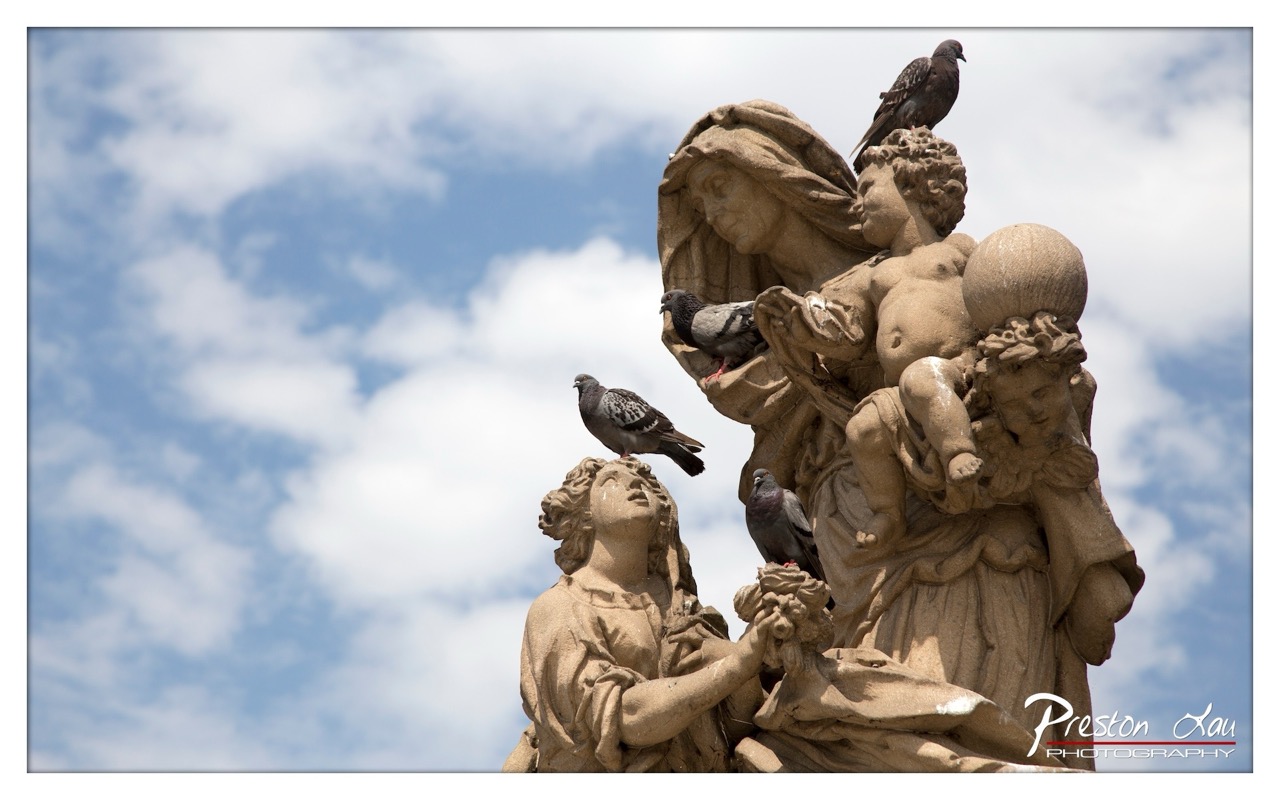

1. Overall Rating (0–10) — 7.5
This photograph captures a striking juxtaposition between timeless art and urban life, where pigeons perch atop a classical stone sculpture like modern-day guardians. The low-angle perspective emphasizes the monumentality of the figures, while the soft blue sky and scattered clouds provide a serene backdrop that enhances the scene’s contemplative mood. Though the composition is visually compelling, the presence of the birds—while thematically rich—adds a touch of decay that slightly undermines the sculpture’s original dignity.
2. Composition (0–10) — 8.0
The low-angle framing creates a sense of grandeur, drawing the viewer’s eye upward along the sculptural forms. The asymmetrical placement of the figures and birds creates visual interest, with the negative space of the sky balancing the density of the sculpture.
3. Lighting (0–10) — 7.0
Natural daylight illuminates the scene evenly, highlighting the texture and depth of the stone while casting soft shadows that enhance the three-dimensional quality. The light is bright but not harsh, contributing to a calm and open atmosphere.
4. Color & Tone (0–10) — 7.5
The palette is harmonious, with warm beige tones of the stone contrasting gently against the cool blues and whites of the sky. The subtle gray and iridescent tones of the pigeons add natural variation without disrupting the overall tonal balance.
5. Creativity (0–10) — 8.0
The image masterfully blends historical art with contemporary urban life, creating a narrative that speaks to the persistence of nature and time over human constructs. The choice to include the pigeons as active participants in the scene elevates it from a mere documentation to a symbolic commentary.
6. Technical Quality (0–10) — 8.5
Sharp focus throughout the sculpture reveals intricate details, and the depth of field is well-managed. The image is clean, with no noticeable noise or distortion, and the watermark is unobtrusive.
7. Emotional Impact (0–10) — 7.0
There is a quiet melancholy in the image, evoking reflection on the passage of time and the way life reclaims what was once sacred. The viewer is invited to contemplate the contrast between permanence and impermanence, creating a lingering sense of wonder and poignancy.
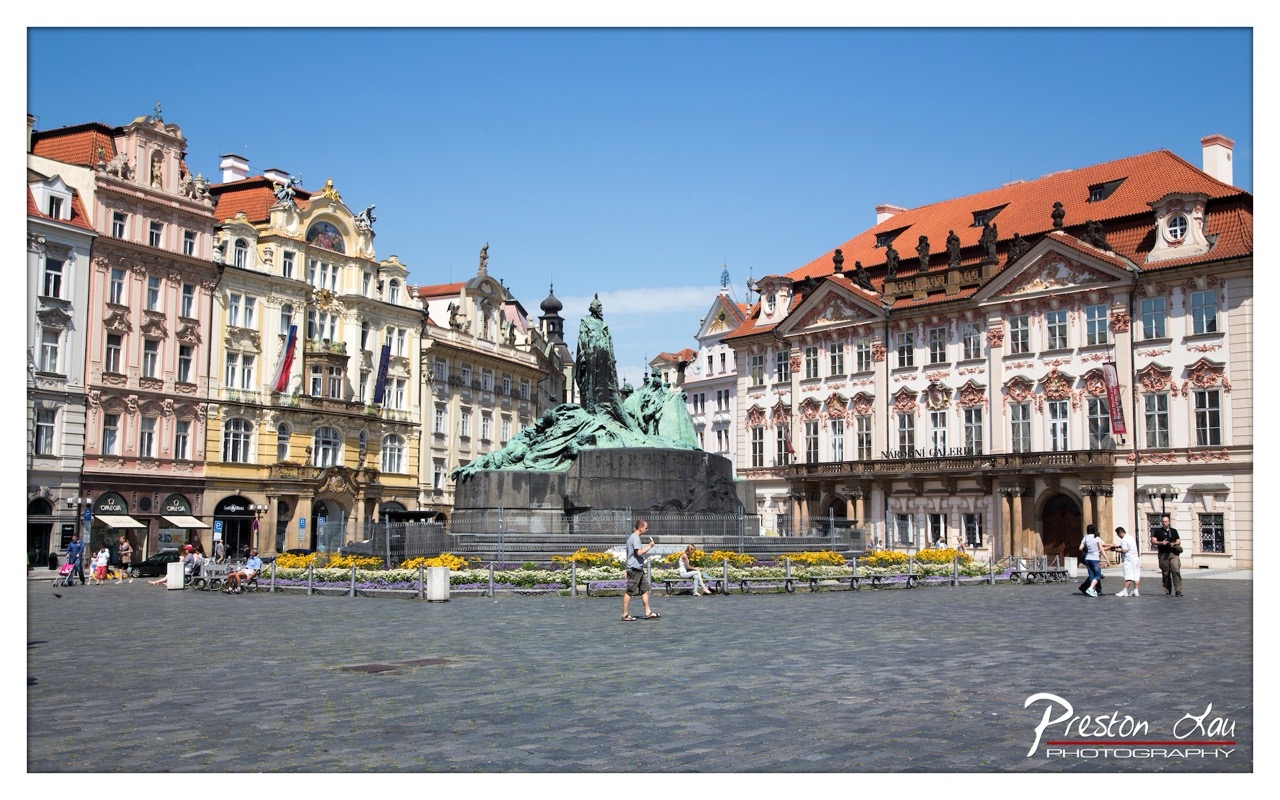

1. Overall Rating (0–10) — 7.5
This photograph captures the vibrant energy of a European city square under a brilliant blue sky, where history and daily life intersect with striking clarity. The rich architectural details and the central monument anchor the scene, while the casual movement of people adds a sense of liveliness. While the image is visually engaging and well-composed, the slightly flat lighting and overexposed sky slightly diminish its emotional depth.
2. Composition (0–10) — 8.0
The wide-angle perspective balances the frame with the monument centered and flanked by ornate buildings, creating a harmonious visual rhythm. The cobblestone foreground leads the eye toward the subject, while the placement of people adds scale and dynamism without clutter.
3. Lighting (0–10) — 6.5
Bright, direct sunlight enhances the vividness of the buildings and flowers, but the sky is overexposed, losing detail in the clouds. The harsh shadows beneath the eaves add depth but also flatten some textures on the façades.
4. Color & Tone (0–10) — 7.0
The warm terracotta roofs and pastel building facades create a rich, inviting palette, complemented by the bright yellow flowers. The contrast between the cool blue sky and the warm architecture adds visual interest, though the white balance leans slightly cool.
5. Creativity (0–10) — 7.0
The image captures a classic travel photograph with a strong sense of place, relying on the inherent beauty of the architecture and atmosphere. While not highly experimental, it effectively conveys the charm and historical weight of the location.
6. Technical Quality (0–10) — 8.0
Sharp focus across the frame, accurate exposure in the midtones, and clean detail in the architectural textures demonstrate strong technical execution. The watermark is unobtrusive and professionally placed.
7. Emotional Impact (0–10) — 7.5
The scene evokes a sense of peace and timelessness, inviting the viewer to imagine strolling through the square on a sunny afternoon. The quiet presence of people enhances the feeling of a living, breathing place rather than a static historical relic.
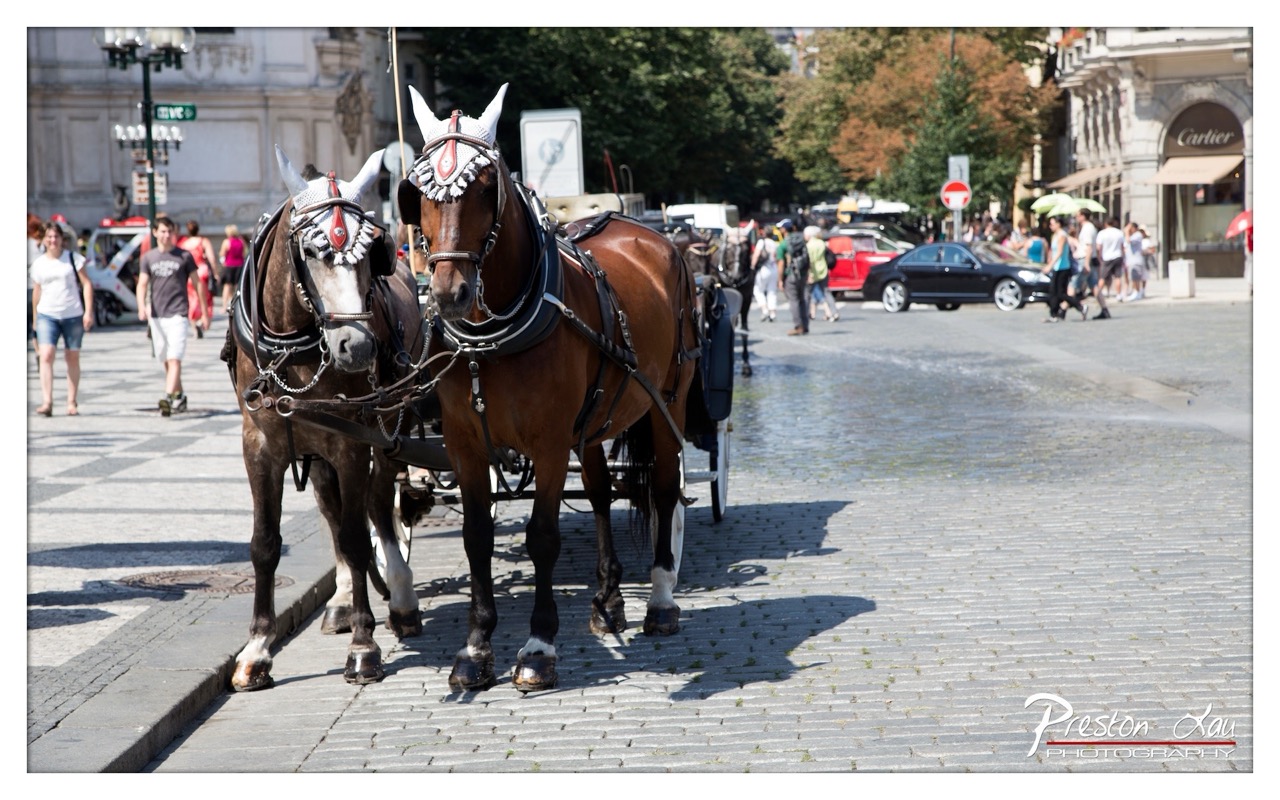

1. Overall Rating (0–10) — 7.0
This photograph captures a striking juxtaposition of tradition and modernity in an urban European setting, where the ornate horses and carriage stand as living relics against a backdrop of traffic and pedestrians. The composition draws the eye to the horses’ rich brown tones and intricate harnesses, while the cobblestone street and classical architecture lend a timeless quality. Though the image is strong in mood and subject, the busy background slightly detracts from the focal clarity, and the lighting, while clear, lacks the warmth that would elevate the scene into something more evocative.
2. Composition (0–10) — 7.5
The horses are centered and dominate the frame, creating a strong focal point. The leading lines of the cobblestone street and sidewalk guide the eye toward the carriage and into the background, though the inclusion of pedestrians and vehicles introduces visual noise that disrupts the balance.
3. Lighting (0–10) — 7.0
Bright, direct sunlight enhances the textures of the horses’ coats and the cobblestones, creating strong shadows that add depth. The lighting is clear and well-exposed, though the harshness slightly flattens the tonal range in the background.
4. Color & Tone (0–10) — 7.5
The warm browns of the horses contrast beautifully with the cool gray of the pavement and the muted tones of the surrounding buildings. The color palette is cohesive and natural, with a slight emphasis on earth tones that reinforce the historical atmosphere.
5. Creativity (0–10) — 7.0
The image successfully captures a moment of cultural continuity, blending historical elements with contemporary life. The choice to include the modern city in the background adds narrative depth, though the execution remains more documentary than conceptual.
6. Technical Quality (0–10) — 8.0
Sharp focus on the horses, clean detail throughout, and proper exposure contribute to a technically sound image. The watermark is subtle and does not distract from the composition.
7. Emotional Impact (0–10) — 6.5
The photograph evokes a sense of nostalgia and quiet dignity, particularly in the stillness of the horses amidst the bustle. While it captures a compelling moment, the emotional resonance is tempered by the overwhelming presence of the surrounding urban environment.
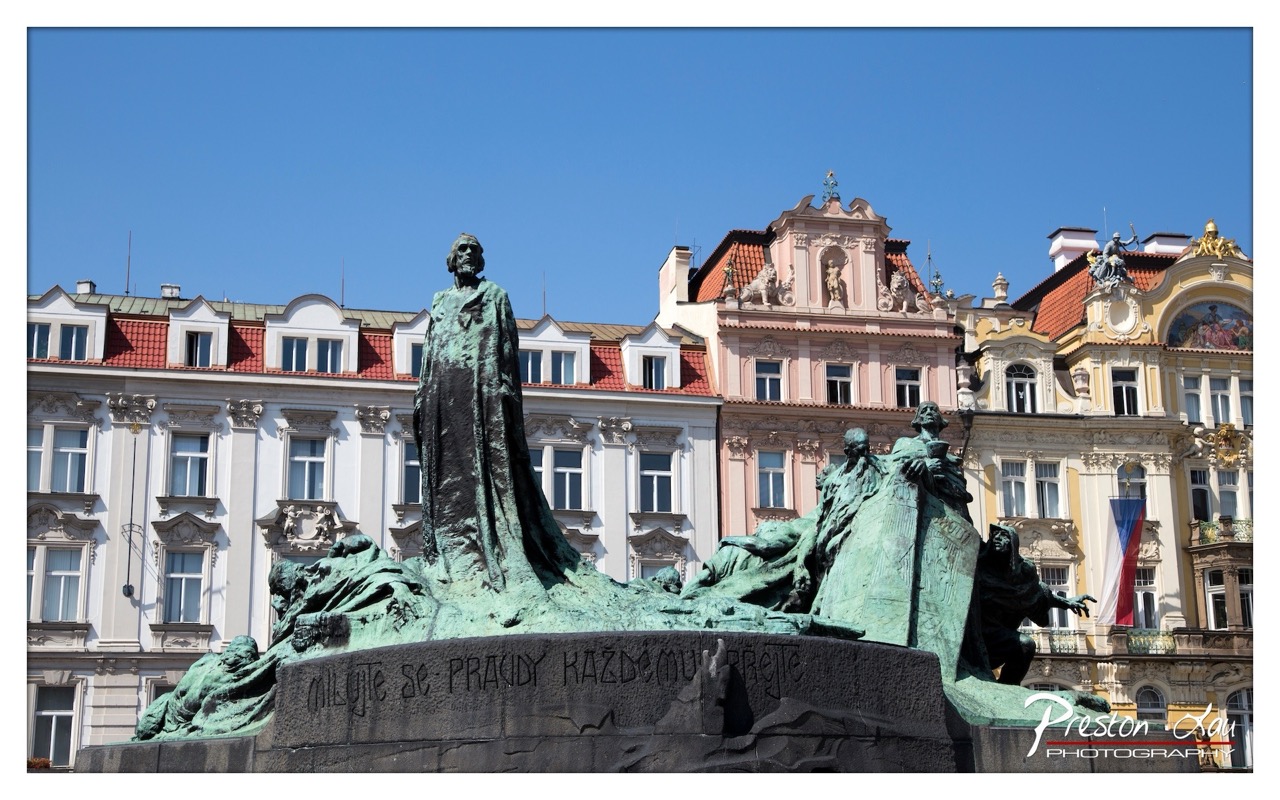

1. Overall Rating (0–10) — 7.0
This photograph captures the grandeur of a historic monument set against a vibrant European cityscape, where architectural richness and sculptural drama converge under a flawless sky. The composition balances the imposing bronze figures with the ornate buildings behind, creating a sense of time and place that feels both monumental and intimate. While the image is strong in atmosphere and context, the slightly flat lighting and lack of dynamic contrast keep it from feeling fully immersive.
2. Composition (0–10) — 7.5
The central placement of the main statue creates a strong focal point, while the surrounding figures and buildings provide depth and narrative context. The diagonal sweep of the sculptural group leads the eye across the frame, and the use of negative space above the monument enhances its stature.
3. Lighting (0–10) — 7.0
The bright, direct sunlight illuminates the scene evenly, highlighting the textures of the patinated bronze and the intricate facades. However, the harsh overhead light flattens some of the architectural details and casts minimal shadows, reducing the sense of three-dimensionality.
4. Color & Tone (0–10) — 7.5
The rich teal of the verdigris bronze contrasts beautifully with the warm terracotta roofs and pastel-colored buildings, all set against a deep, saturated blue sky. The color palette is vibrant and harmonious, lending the image a lively yet historically grounded tone.
5. Creativity (0–10) — 7.0
The photograph effectively captures the interplay between art and architecture, presenting a well-known monument as part of a living urban narrative. The inclusion of the Czech flag adds a subtle layer of cultural identity, grounding the image in its specific location.
6. Technical Quality (0–10) — 8.0
The image is sharp and clear, with excellent detail in the sculpture and building textures. The exposure is well-balanced, and the camera’s resolution captures fine elements without noise or distortion.
7. Emotional Impact (0–10) — 6.5
The image evokes a sense of reverence and historical continuity, inviting contemplation of the past. While visually striking, it maintains a certain distance—more a document of place than an emotional provocation.
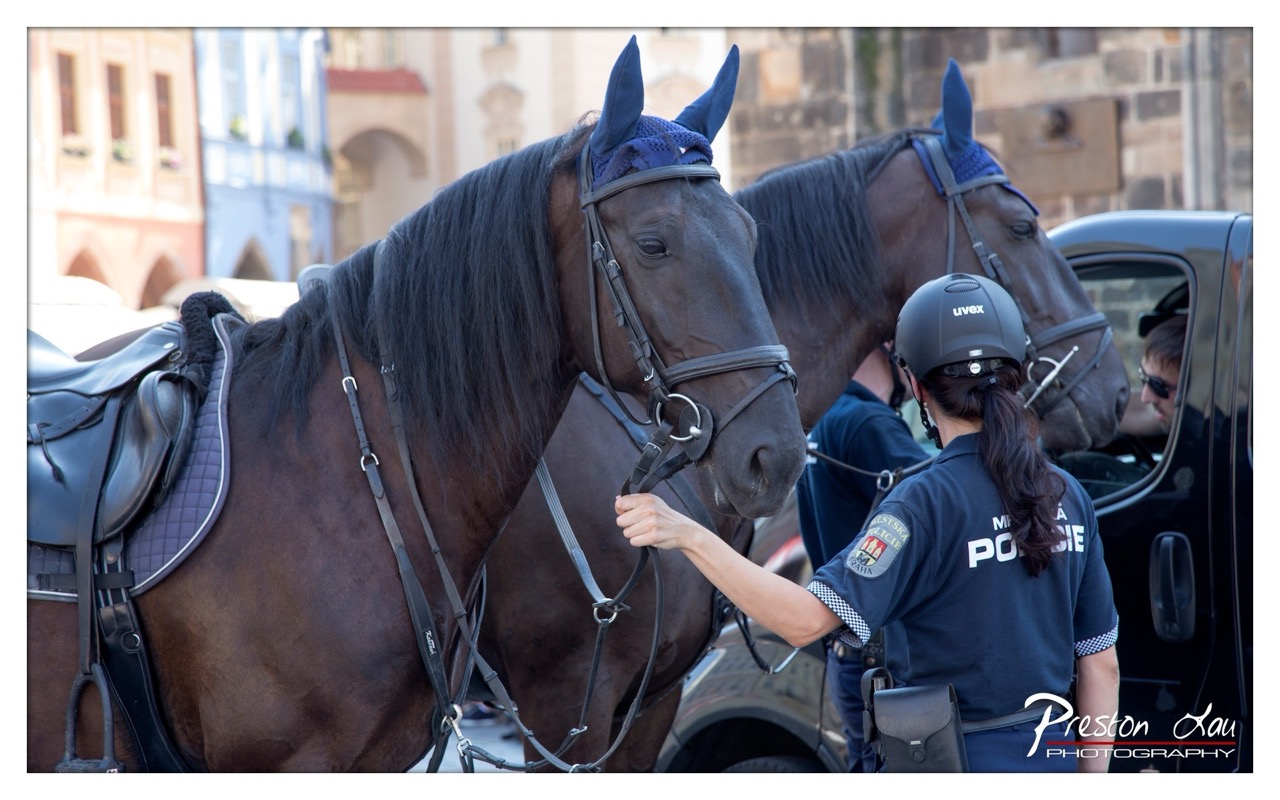

1. Overall Rating (0–10) — 7.0
This photograph captures a striking juxtaposition of tradition and modernity, with the elegant presence of mounted police horses set against the backdrop of a bustling urban environment. The composition draws the viewer into a moment of quiet interaction between officer and horse, emphasizing both discipline and care. While the image is strong in narrative and subject matter, the busy background slightly distracts from the central focus, preventing it from achieving full visual cohesion.
2. Composition (0–10) — 7.0
The framing centers on the horse and officer, creating a natural focal point, though the overlapping horse in the background introduces a slight visual clutter. The diagonal line of the reins and the officer’s arm guide the eye effectively, enhancing depth and engagement.
3. Lighting (0–10) — 7.5
Natural daylight illuminates the scene evenly, highlighting the rich texture of the horse’s coat and the details of the tack. The soft, diffused light enhances the calm mood without creating harsh shadows.
4. Color & Tone (0–10) — 7.0
The deep browns of the horses contrast beautifully with the navy blue uniform and the muted tones of the stone buildings. The color palette is cohesive, with a balanced warmth that supports the image’s dignified tone.
5. Creativity (0–10) — 7.5
The concept of mounted police in a historic urban setting offers a compelling narrative, blending cultural heritage with contemporary law enforcement. The photograph captures this intersection with authenticity and visual interest.
6. Technical Quality (0–10) — 8.0
Sharp focus on the foreground horse and officer, with appropriate depth of field, ensures clarity and detail. The image is well-exposed, with clean resolution and minimal noise.
7. Emotional Impact (0–10) — 7.0
The image evokes a sense of calm authority and respect, conveying the bond between the officer and the horse. The viewer is invited to reflect on the role of tradition in modern society, creating a subtle but meaningful emotional resonance.
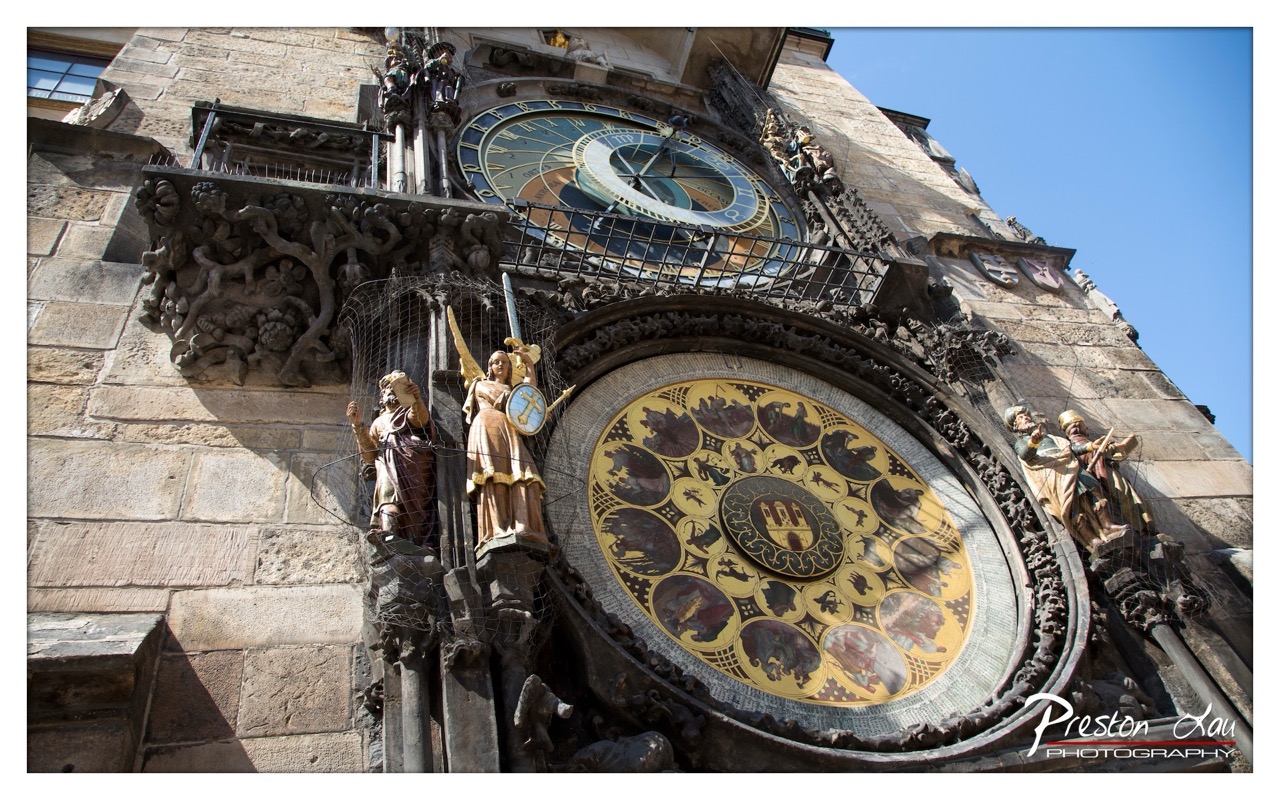

1. Overall Rating (0–10) — 8.0
This photograph captures the ornate grandeur of the Prague Astronomical Clock with striking clarity and reverence for its historical detail. The low-angle perspective emphasizes the monumentality of the structure, while the vibrant golden hues of the zodiac dial contrast beautifully against the aged stone and deep blue sky. Though the composition is rich in texture and narrative, a slightly more balanced framing could enhance the visual harmony and reduce the visual weight of the lower left corner.
2. Composition (0–10) — 7.5
The low-angle shot creates a dramatic sense of scale, drawing the viewer’s eye upward toward the clock’s intricate mechanisms. The placement of the zodiac dial as the dominant focal point is effective, though the asymmetry caused by the heavy stonework on the left slightly disrupts the balance.
3. Lighting (0–10) — 8.5
Bright, direct sunlight enhances the textures of the stonework and the gilded details of the clock, casting sharp shadows that add depth and dimension. The clear blue sky provides a clean backdrop, allowing the architectural elements to stand out vividly.
4. Color & Tone (0–10) — 8.0
The warm golden tones of the zodiac dial contrast beautifully with the cool grays of the stone and the deep blue of the sky. The color palette is rich and well-balanced, with natural saturation that enhances the historical character of the scene.
5. Creativity (0–10) — 8.0
The choice of angle and focus on the clock’s complex mechanisms conveys both reverence and fascination. The image tells a story of time, craftsmanship, and endurance, elevating a historic landmark into a moment of visual poetry.
6. Technical Quality (0–10) — 8.5
Sharp focus across the clock’s intricate details, excellent clarity, and precise exposure control demonstrate strong technical execution. The resolution and detail allow for close examination of the craftsmanship.
7. Emotional Impact (0–10) — 7.5
The image evokes a sense of awe and wonder, inviting the viewer to contemplate centuries of artistry and science. The juxtaposition of ancient design against a modern sky creates a timeless resonance, though the emotional pull is slightly tempered by the absence of human presence.
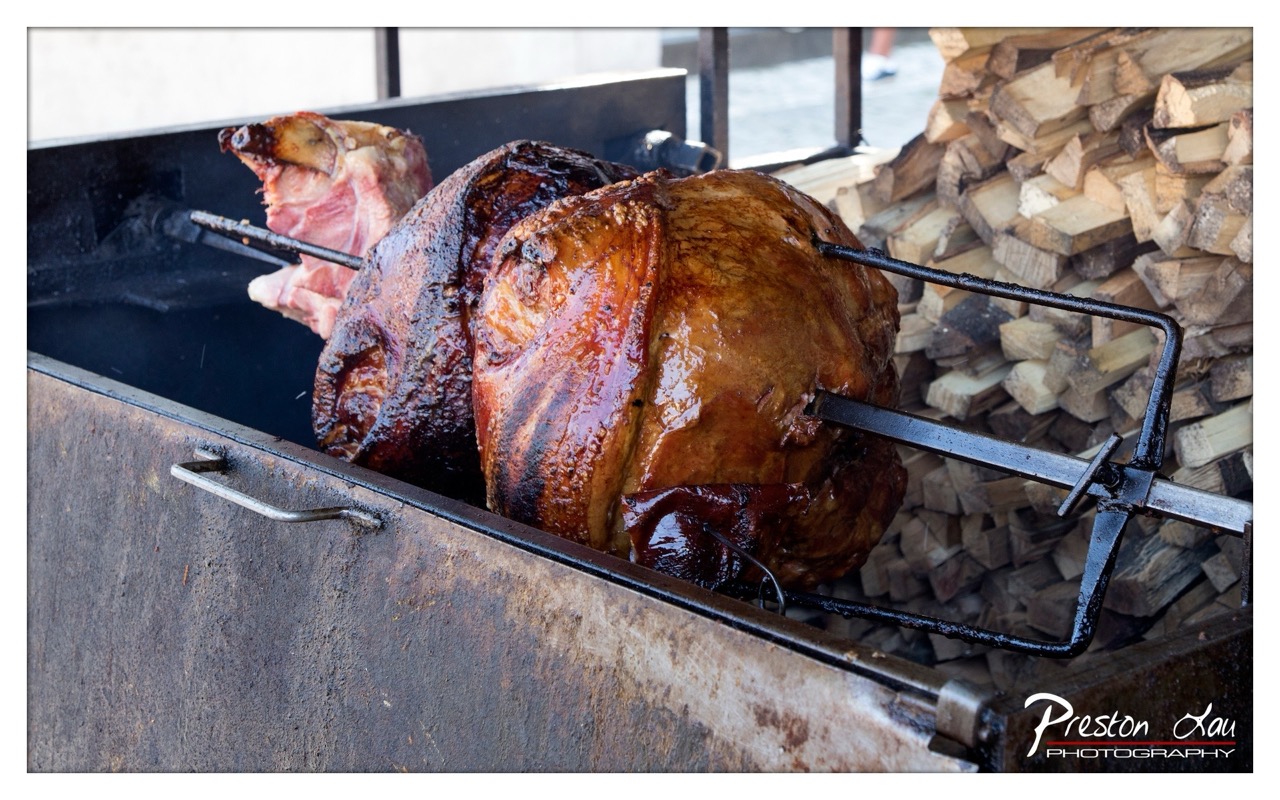

1. Overall Rating (0–10) — 7.0
This photograph captures the rustic allure of slow-roasted meat on a spit, evoking the sensory richness of street-side cooking. The glistening, caramelized surface of the meat and the surrounding stack of firewood create a compelling narrative of tradition and flavor. While the composition is strong and the subject immediately engaging, the slightly cluttered background and flat lighting prevent the image from achieving a more polished, cinematic quality.
2. Composition (0–10) — 7.0
The meat is well-centered and fills the frame effectively, with the metal spit leading the eye diagonally through the image. The stack of firewood in the background adds depth and context, though its busy texture slightly competes with the main subject.
3. Lighting (0–10) — 6.0
The lighting is natural and even, highlighting the sheen on the meat’s surface, but it lacks directional warmth or dramatic contrast. The flatness of the light diminishes the sense of heat and intensity one might expect from a roasting scene.
4. Color & Tone (0–10) — 7.0
The warm browns and deep char tones of the meat are rich and appetizing, complemented by the neutral grays and tans of the firewood and metal. The color palette feels authentic and grounded, though it could benefit from slightly greater saturation to enhance visual impact.
5. Creativity (0–10) — 7.0
The image successfully captures a cultural culinary practice with a documentary feel, emphasizing authenticity over stylization. The inclusion of the firewood and the rustic setup adds narrative depth and originality.
6. Technical Quality (0–10) — 8.0
The focus is sharp on the meat, with fine detail visible in the crust and surface texture. The exposure is well-balanced, and the image is free of noticeable noise or distortion.
7. Emotional Impact (0–10) — 7.5
The photograph stirs a visceral response—warmth, hunger, and nostalgia—through its depiction of a time-honored cooking method. The viewer is invited to imagine the scent and taste, creating a strong emotional connection to the moment.
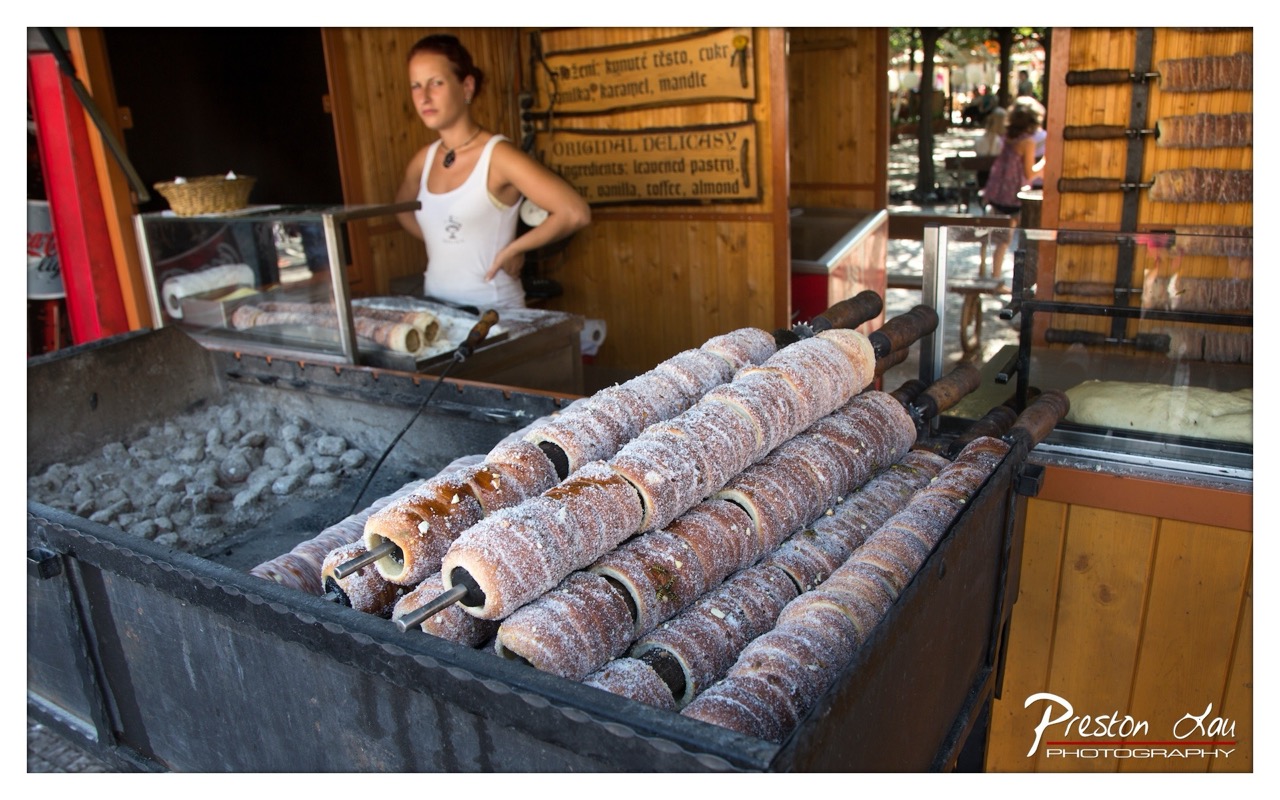

1. Overall Rating (0–10) — 7.0
This photograph captures the lively essence of a traditional street food stall, where the artisanal process of making trdelník is both documented and celebrated. The foreground’s golden, sugar-dusted pastries glisten with warmth and texture, drawing the eye immediately, while the vendor’s calm presence in the background adds narrative depth. Though the image leans slightly toward documentary realism, its authenticity and rich sensory appeal make it engaging and inviting.
2. Composition (0–10) — 6.5
The diagonal arrangement of the trdelník on their spits creates a strong visual line leading into the frame, while the vendor’s placement on the left balances the composition. However, the cluttered background and slightly off-center framing introduce mild distraction, preventing a more cohesive visual flow.
3. Lighting (0–10) — 7.0
Natural daylight illuminates the scene with a soft, even quality, highlighting the sugary texture of the pastries without harsh shadows. The contrast between the warm, glowing pastries and the cooler tones of the charcoal pit enhances depth and visual interest.
4. Color & Tone (0–10) — 7.0
The warm golden browns of the pastries and wood paneling create a rich, earthy palette, complemented by the crisp white sugar and the vendor’s neutral tank top. The overall tone feels balanced and appetizing, with a slight coolness in the background that helps the subject stand out.
5. Creativity (0–10) — 7.5
The image successfully blends cultural authenticity with a compelling visual narrative, capturing a moment of traditional craftsmanship. The choice to emphasize the finished product while including the vendor in the background adds a human element, making the scene feel alive and purposeful.
6. Technical Quality (0–10) — 8.0
Sharp focus on the foreground pastries, clear detail in the sugar crystals and wood grain, and clean handling of the depth of field contribute to a technically strong image. The exposure is well-managed, with no blown highlights or lost shadows.
7. Emotional Impact (0–10) — 7.5
The photograph evokes a sense of warmth, nostalgia, and delight—inviting the viewer to imagine the scent of caramelized dough and the sound of the rotating spits. The combination of food, tradition, and human presence creates a deeply relatable and emotionally resonant experience.
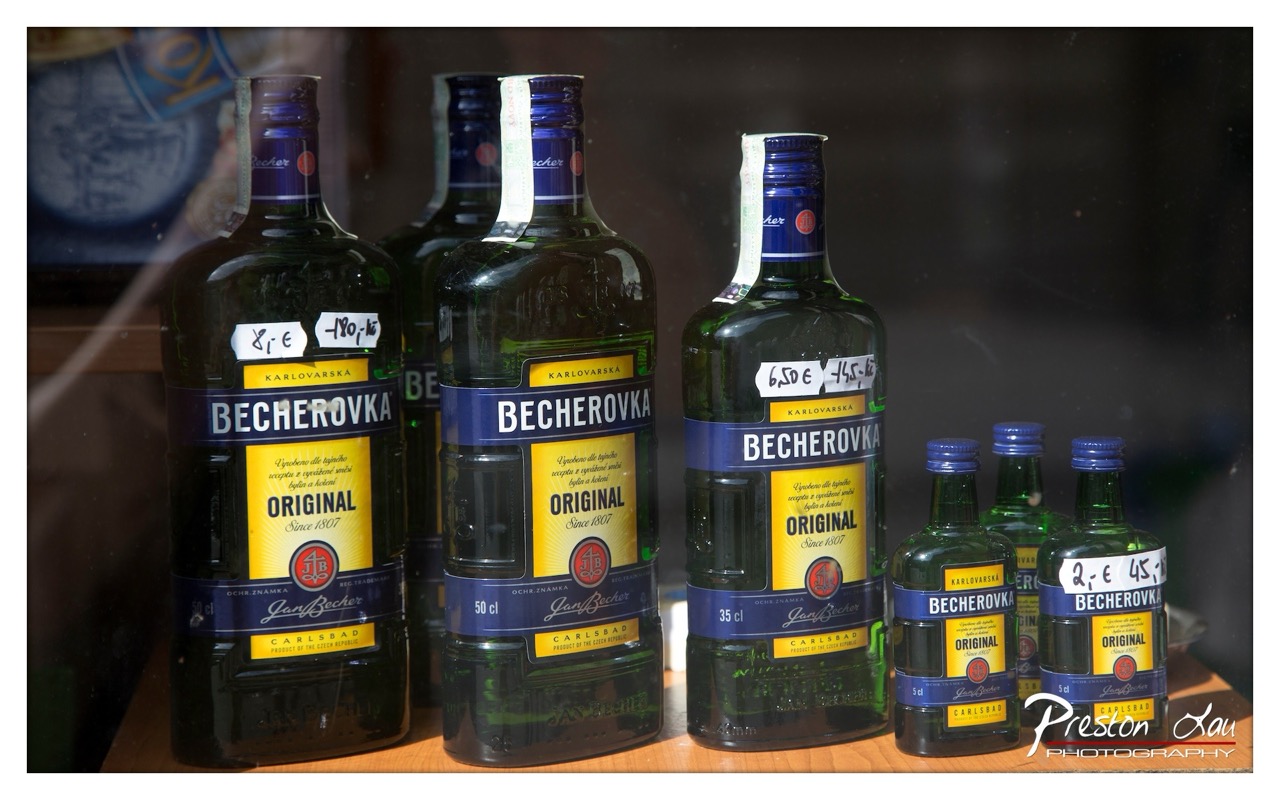

1. Overall Rating (0–10) — 6.0
This photograph presents a straightforward still life of Becherovka bottles, capturing the product’s branding with clarity and purpose. The arrangement feels functional, emphasizing the commercial context of the scene, yet it lacks a compelling narrative or aesthetic tension. While the image effectively documents the product and its pricing, the composition remains somewhat static and unemotional, offering little beyond a straightforward commercial record.
2. Composition (0–10) — 6.0
The bottles are arranged in a diagonal line, creating a sense of depth, but the framing feels slightly off-center and cluttered. The presence of multiple bottles of varying sizes creates visual interest, but the arrangement lacks intentional balance, with the largest bottle on the left drawing disproportionate attention.
3. Lighting (0–10) — 5.5
The lighting is flat and functional, likely from an overhead source, which casts minimal shadows and emphasizes the labels. While the illumination is sufficient to identify the products, it lacks directionality or mood, resulting in a neutral, almost clinical quality.
4. Color & Tone (0–10) — 6.0
The dominant green of the glass and the bold yellow and blue of the labels create a strong brand identity, but the overall tone is muted by the dark background and the presence of glare. The color palette is coherent but lacks vibrancy, giving the image a slightly dated appearance.
5. Creativity (0–10) — 5.0
The image functions as a clear product photograph but does not transcend into creative or conceptual territory. The inclusion of price tags and the casual arrangement suggest a candid, documentary approach rather than an artistic interpretation.
6. Technical Quality (0–10) — 7.5
The focus is sharp on the central bottles, and the details on the labels are legible. The image is free of major technical flaws, though minor reflections and a slightly overexposed background suggest a lack of refined lighting control.
7. Emotional Impact (0–10) — 5.0
The photograph feels detached and utilitarian, evoking a sense of commerce rather than emotion. There is no strong emotional resonance, as the image prioritizes information over atmosphere or storytelling.


1. Overall Rating (0–10) — 7.5
This photograph captures the ornate elegance of a European cityscape, where architectural detail and natural framing converge to create a sense of timeless beauty. The soft focus of the foreground leaves and the rich textures of the facades lend a painterly quality to the scene, though the composition’s depth feels slightly constrained by the tight framing. The image succeeds in evoking a quiet, contemplative mood, balancing urban grandeur with organic softness.
2. Composition (0–10) — 7.0
The framing is enhanced by the natural silhouette of tree leaves in the foreground, which adds depth and a sense of intimacy. However, the central building’s vertical lines are slightly interrupted by the off-center placement of the “Carlbad Plaza” sign, creating a subtle imbalance.
3. Lighting (0–10) — 7.5
The diffused daylight evenly illuminates the buildings, softening their intricate details without harsh shadows. The overcast light enhances the pastel tones and lends a calm, atmospheric quality to the scene.
4. Color & Tone (0–10) — 8.0
The palette of cream, rose, and soft green is harmonious and evocative of late 19th-century European architecture. The muted contrast allows the delicate ornamentation to stand out without overwhelming the viewer.
5. Creativity (0–10) — 7.5
The use of foliage as a natural frame is a strong compositional choice, offering a layered perspective that invites the viewer into the scene. The inclusion of the lone figure on the balcony adds a narrative element, suggesting quiet observation.
6. Technical Quality (0–10) — 8.0
Sharp focus on the central building, with a shallow depth of field that gently blurs the foreground, demonstrates strong technical control. The image is clean, with no visible noise or distortion.
7. Emotional Impact (0–10) — 7.0
The photograph evokes a sense of nostalgia and quiet elegance, capturing a fleeting moment in a historic setting. The softness of the light and the stillness of the scene create a contemplative, almost melancholic mood that lingers with the viewer.
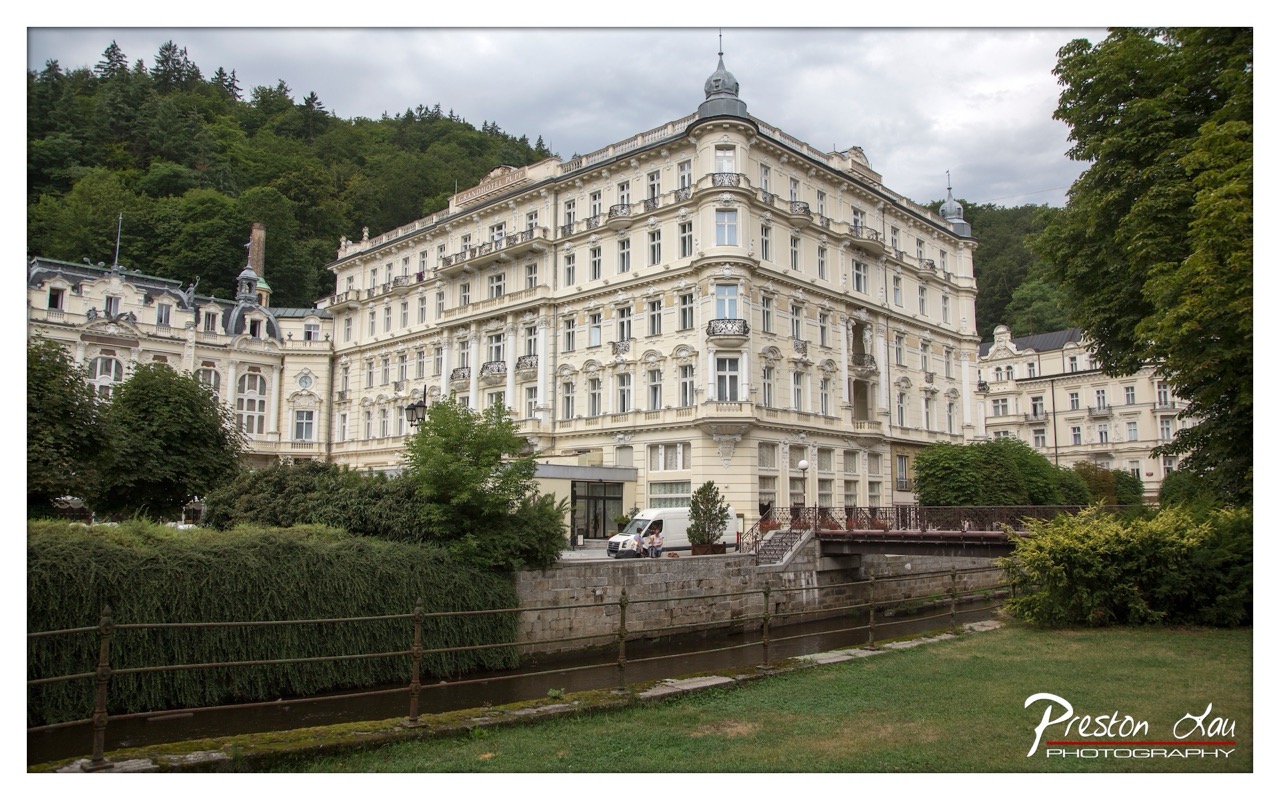

1. Overall Rating (0–10) — 7.0
This photograph captures the grandeur of a historic European hotel nestled against a forested hill, blending architectural elegance with natural serenity. The composition balances the ornate building with lush greenery and a tranquil waterway, creating a harmonious sense of place. While the overcast sky tempers the image’s vibrancy, the overall mood is contemplative and timeless, inviting the viewer into a quiet moment of architectural and natural beauty.
2. Composition (0–10) — 7.5
The building is well-framed, with the diagonal flow of the waterway and railings guiding the eye toward the structure’s corner. The inclusion of the white van and figures adds subtle human scale, though the framing feels slightly wide, diluting the focus on the building’s architectural details.
3. Lighting (0–10) — 6.0
The soft, diffused light from the overcast sky creates even illumination, minimizing harsh shadows and highlighting the building’s ornate facade. However, the lack of sunlight or directional light results in a somewhat muted atmosphere, reducing the sense of drama or depth.
4. Color & Tone (0–10) — 6.5
The palette is dominated by soft whites, greens, and grays, creating a cohesive but subdued tone. The natural colors are well-rendered, though the lack of contrast or warm accents tempers the image’s visual impact.
5. Creativity (0–10) — 7.0
The image successfully captures the interplay between historic architecture and its natural surroundings, offering a thoughtful perspective on urban and rural elements coexisting. The low-angle framing adds a sense of grandeur, elevating the subject beyond mere documentation.
6. Technical Quality (0–10) — 8.0
The image is sharp and detailed, with clear focus on the building and foreground elements. The exposure is well-balanced, and the resolution is high, allowing for fine texture in the stone, foliage, and water.
7. Emotional Impact (0–10) — 7.0
The photograph evokes a sense of calm and nostalgia, suggesting a place where time moves slowly and history lingers. The quiet presence of the building and the stillness of the water create a meditative mood, resonating with viewers who appreciate architectural and natural harmony.
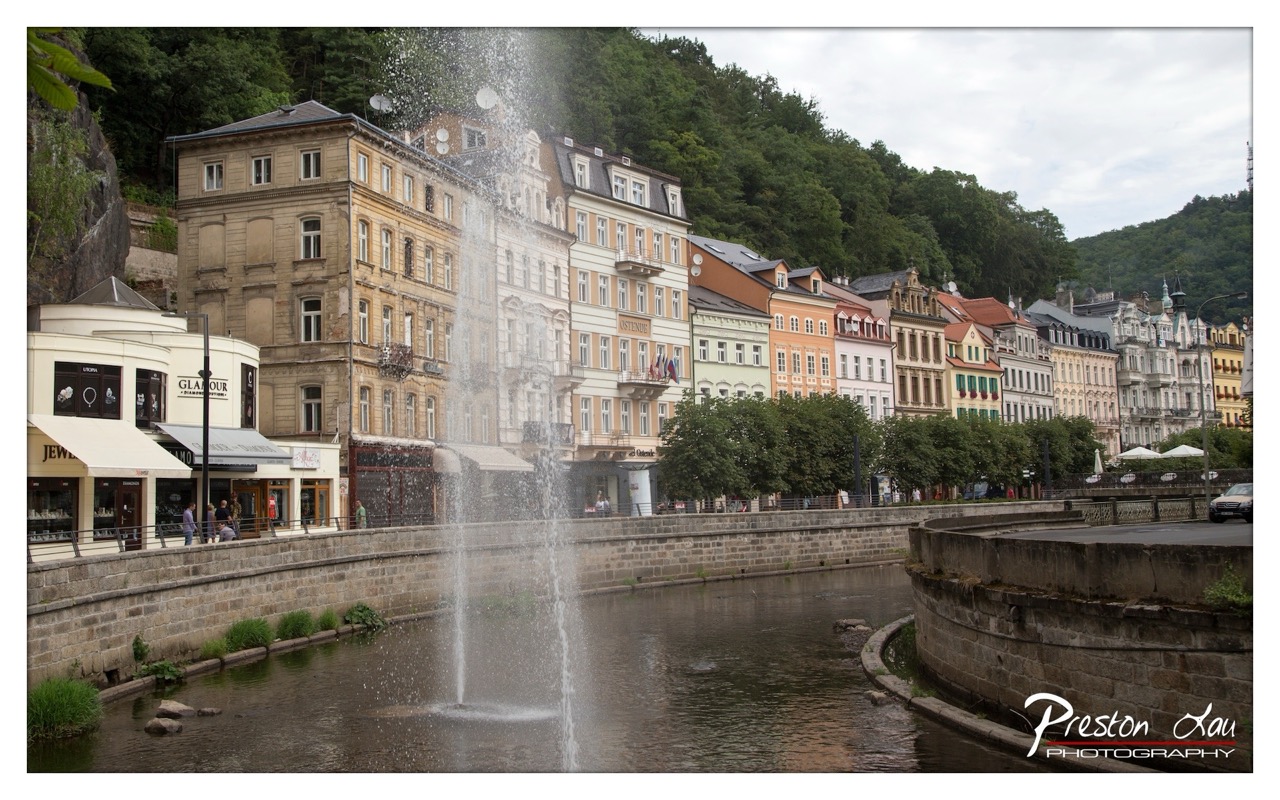

1. Overall Rating (0–10) — 7.0
This photograph captures the serene charm of a European riverside town, where historic architecture meets natural beauty in a harmonious blend. The fountain serves as a dynamic focal point, drawing the eye through the composition and adding a sense of movement to the otherwise still scene. While the overcast sky tempers the vibrancy of the colors, the image successfully conveys a quiet, contemplative mood, with the stone buildings and lush hillside providing a timeless backdrop.
2. Composition (0–10) — 7.0
The diagonal line of the riverbank and the vertical jet of the fountain create a balanced and engaging composition. The placement of the fountain slightly off-center adds visual interest, while the row of buildings guides the viewer’s gaze across the frame. The inclusion of the foreground wall and the natural curve of the river enhances depth and perspective.
3. Lighting (0–10) — 6.0
The soft, diffused light from the overcast sky creates even illumination across the scene, minimizing harsh shadows and allowing for clear detail in the buildings and water. However, the lack of direct sunlight results in a somewhat muted atmosphere, reducing the potential for dramatic contrast or rich tonal variation.
4. Color & Tone (0–10) — 6.5
The palette is composed of earthy tones—beiges, browns, and soft greens—that reflect the natural and architectural elements of the scene. The subdued coloration aligns with the overcast lighting, creating a cohesive but somewhat restrained aesthetic. A touch more saturation could enhance the visual appeal without compromising authenticity.
5. Creativity (0–10) — 7.0
The image demonstrates a thoughtful approach to capturing a picturesque urban landscape, using the fountain as a narrative device to unify the composition. The blend of natural and built environments reflects a deeper appreciation for place and history, elevating the photograph beyond a simple snapshot.
6. Technical Quality (0–10) — 8.0
The photograph is sharp and well-focused, with clear detail visible in the textures of the stone walls, building facades, and water. The exposure is balanced, and the image appears free from noticeable noise or distortion, showcasing strong technical execution.
7. Emotional Impact (0–10) — 6.5
The scene evokes a sense of calm and nostalgia, inviting the viewer to imagine life in a quiet riverside town. While the mood is pleasant and reflective, the lack of strong emotional contrast or human drama keeps the connection to the image from being deeply personal or stirring.
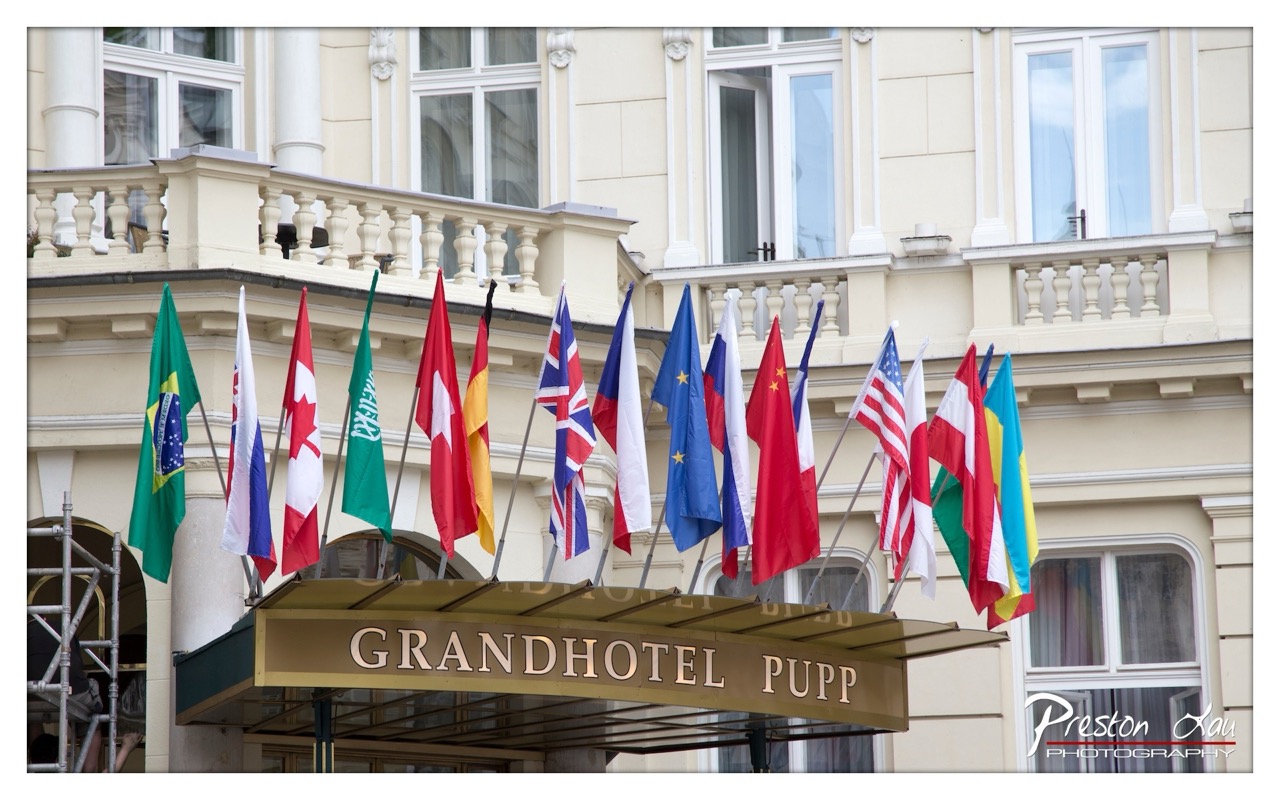

1. Overall Rating (0–10) — 7.0
This photograph captures the cosmopolitan elegance of the Grandhotel Pupp, with a vibrant array of international flags suggesting a hub of global travel and diplomacy. The composition balances architectural grandeur with cultural inclusivity, and the clean lines of the façade provide a dignified backdrop. While the image is strong in its documentation of place and identity, the slightly overcast lighting and busy flag arrangement temper its visual cohesion, keeping it from achieving a more refined artistic presence.
2. Composition (0–10) — 7.0
The flags create a dynamic diagonal sweep across the frame, drawing the eye from left to right, while the hotel sign anchors the lower center, offering a stable focal point. The inclusion of the scaffolding on the left edge introduces a subtle tension, suggesting ongoing maintenance, which slightly disrupts the otherwise harmonious symmetry.
3. Lighting (0–10) — 6.0
The lighting is soft and diffused, likely due to overcast conditions, which minimizes harsh shadows and allows the colors of the flags to appear evenly rendered. However, the lack of strong directional light reduces depth and drama, giving the scene a slightly flat, documentary feel.
4. Color & Tone (0–10) — 7.5
The palette is rich with the varied hues of national flags, creating a lively contrast against the pale cream of the hotel’s façade. The golden tones of the sign add warmth, while the cool, neutral background helps the colors pop. The overall tonal balance is effective, though the saturation could be slightly more pronounced to enhance visual impact.
5. Creativity (0–10) — 7.0
The photographer captures a moment of global convergence in a visually engaging way, using the flags as a metaphor for international connection. The choice to include both the architectural elegance and the signs of everyday operation (like scaffolding) adds layers of narrative, suggesting continuity and renewal.
6. Technical Quality (0–10) — 8.0
The image is sharp and well-focused, with fine detail visible in the lettering of the sign and the textures of the building. The exposure is balanced, with no significant areas of over- or underexposure, and the camera’s resolution captures the scene with clarity.
7. Emotional Impact (0–10) — 6.5
The photograph evokes a sense of cosmopolitanism and quiet dignity, inviting viewers to imagine the stories of travelers passing through. While it conveys a strong sense of place, the lack of human presence or dynamic action keeps the emotional resonance from reaching deeper levels of connection.
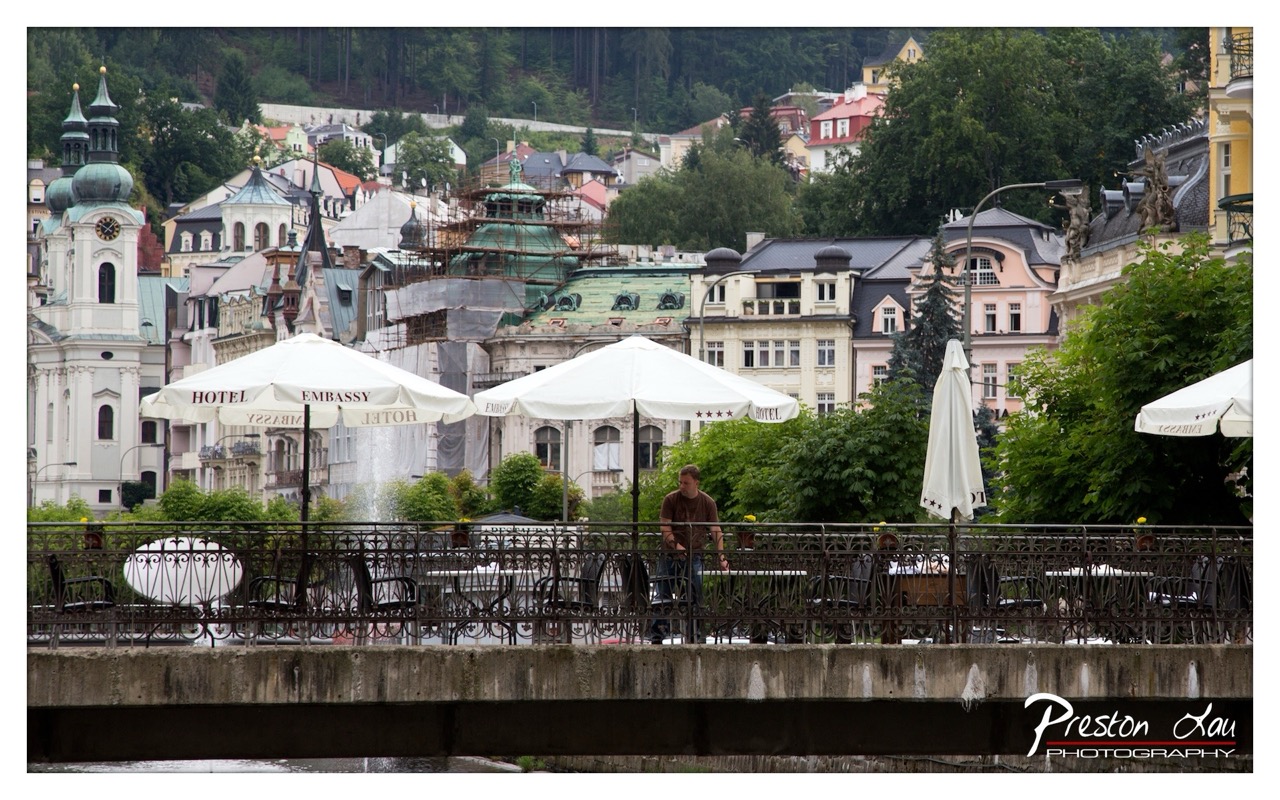

1. Overall Rating (0–10) — 6.8
This photograph captures a layered urban landscape where history and modernity converge, with a café terrace in the foreground framing a picturesque European cityscape. The composition draws the eye through the bridge and umbrellas toward the densely packed architecture and verdant hillside, creating a sense of depth and place. While the image is rich in detail and atmosphere, the muted lighting and slightly cluttered arrangement prevent it from achieving a more cohesive and emotionally resonant impact.
2. Composition (0–10) — 7.0
The layered arrangement of foreground, midground, and background creates strong depth, with the bridge railing and umbrellas guiding the eye into the scene. However, the inclusion of multiple umbrellas and a casually placed figure slightly disrupts visual harmony.
3. Lighting (0–10) — 5.5
Diffused, overcast light softens details and flattens shadows, lending a subdued mood but reducing contrast and atmospheric drama.
4. Color & Tone (0–10) — 6.0
A cool, desaturated palette dominates, with muted greens, grays, and pastel building tones that reflect the cloudy sky. While consistent, the lack of vibrancy slightly dampens the scene’s visual energy.
5. Creativity (0–10) — 7.0
The framing effectively juxtaposes everyday life with historical architecture, suggesting a narrative of continuity and leisure. The use of the bridge and umbrellas as framing devices adds a subtle layer of storytelling.
6. Technical Quality (0–10) — 7.5
The image is sharp and clear, with fine detail visible in the architecture and railings. The focus is consistent across the frame, and the watermark is unobtrusive.
7. Emotional Impact (0–10) — 6.0
The photograph evokes a quiet, contemplative mood—perhaps a moment of pause in a bustling town. However, the emotional resonance is restrained by the lack of dynamic lighting and the slightly impersonal quality of the scene.
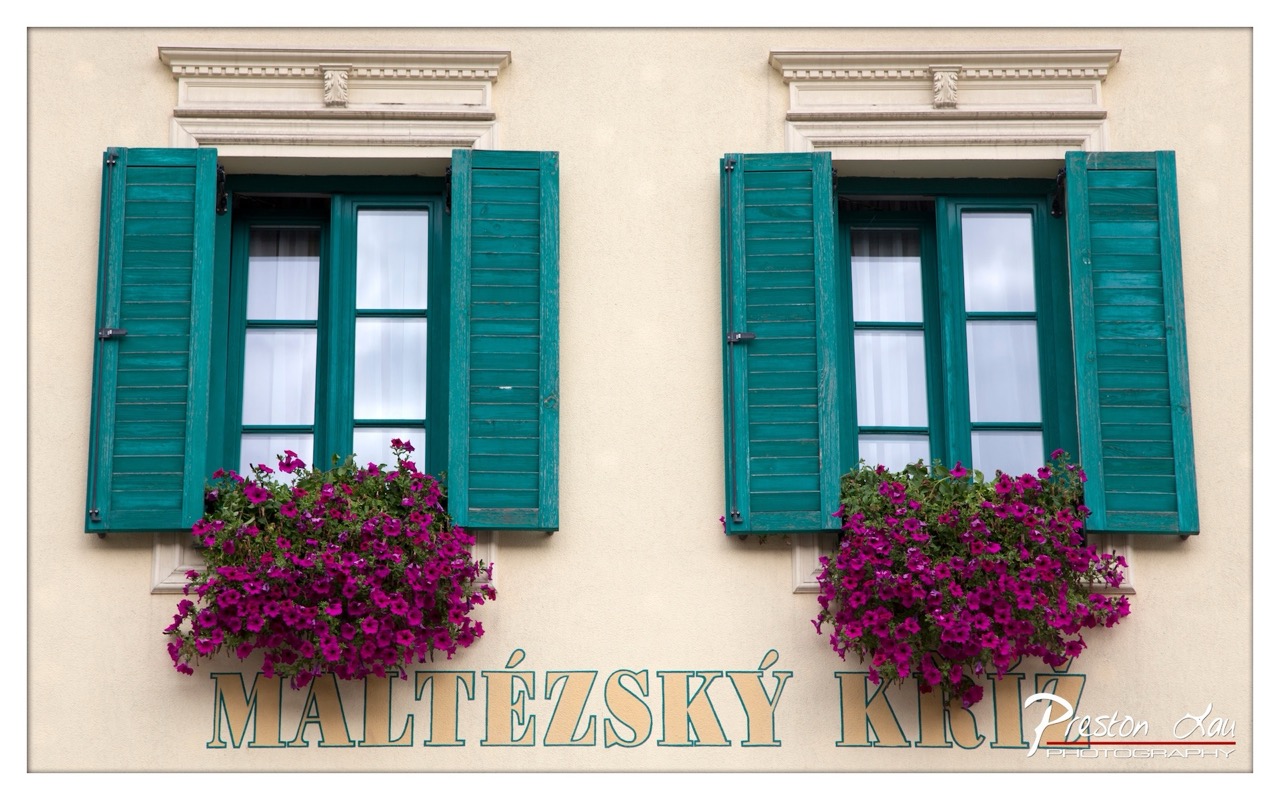

1. Overall Rating (0–10) — 7.5
This photograph captures a charming and harmonious street scene, where the vibrant teal shutters and magenta flowers create a striking visual contrast against the soft beige wall. The symmetry and repetition lend a sense of order and elegance, while the bold lettering grounds the image in a specific place, evoking a quiet European charm. While the composition is strong and the colors are vivid, the image feels slightly over-processed, with saturation that borders on artificial, slightly diminishing its natural appeal.
2. Composition (0–10) — 8.0
The symmetrical framing of the two windows creates a balanced and visually pleasing structure. The placement of the flower boxes adds rhythm and draws the eye across the frame, while the centered text provides a subtle grounding element. The composition is well-considered, emphasizing harmony and repetition.
3. Lighting (0–10) — 7.0
The lighting is even and soft, suggesting an overcast day, which prevents harsh shadows and allows the colors to appear rich and consistent. The diffuse light enhances the texture of the wall and the detail in the shutters, though it lacks the dynamic range that directional sunlight might have provided.
4. Color & Tone (0–10) — 8.0
The contrast between the deep teal shutters and the vibrant magenta flowers is bold and engaging, creating a visually striking palette. The warm beige wall acts as a neutral backdrop, allowing the colors to pop. The overall tone is bright and cheerful, though the saturation appears slightly heightened, lending a stylized quality.
5. Creativity (0–10) — 7.0
The image is conceptually simple but executed with a clear aesthetic vision. The juxtaposition of color, symmetry, and architectural detail demonstrates a thoughtful approach to capturing everyday beauty. While not groundbreaking, it reflects a strong sense of place and visual storytelling.
6. Technical Quality (0–10) — 8.0
The image is sharp and well-focused, with clear detail in the shutters, flowers, and text. The exposure is balanced, and the depth of field is adequate to keep all key elements in focus. The post-processing is clean, though the color enhancement is noticeable.
7. Emotional Impact (0–10) — 7.5
The photograph evokes a sense of warmth, nostalgia, and quiet delight, inviting the viewer to imagine a peaceful European town. The combination of color, symmetry, and floral detail creates a welcoming and almost romantic atmosphere, though the slight artificiality of the colors tempers the emotional resonance.
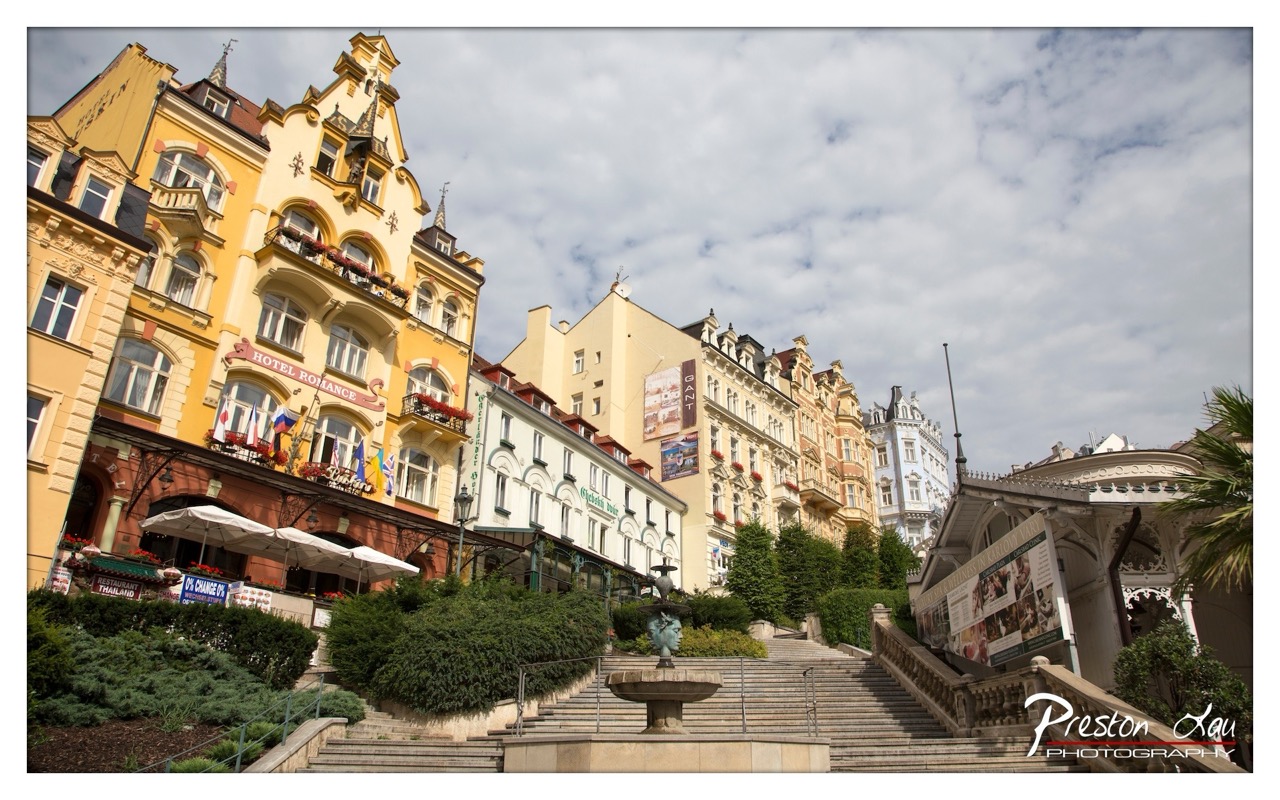

1. Overall Rating (0–10) — 7.0
This photograph captures the vibrant charm of a European town square, where historic architecture and lively street life converge in a harmonious, almost storybook-like scene. The warm pastel hues of the buildings contrast beautifully with the soft, overcast sky, lending the image a nostalgic and inviting quality. While the composition is strong and the subject rich in detail, the slightly cluttered foreground and overexposed sky detract from the overall visual balance, preventing the image from reaching its full aesthetic potential.
2. Composition (0–10) — 7.0
The diagonal sweep of the stairs and the upward angle create a dynamic sense of movement, drawing the eye through the frame. The placement of the fountain adds a central focal point, though the presence of the outdoor café and signage on the left introduces visual noise.
3. Lighting (0–10) — 6.5
The soft, diffused light from the overcast sky provides even illumination across the scene, minimizing harsh shadows and preserving detail in both highlights and shadows. However, the sky appears slightly overexposed, losing texture and nuance in the clouds.
4. Color & Tone (0–10) — 7.5
The warm yellows and creams of the buildings are complemented by the rich greens of the shrubbery and the earthy tones of the stone steps, creating a cohesive and pleasing palette. The color temperature leans slightly warm, enhancing the inviting atmosphere of the scene.
5. Creativity (0–10) — 7.0
The low-angle perspective and the inclusion of everyday elements—like the café umbrellas and international flags—add a layer of authenticity and narrative depth. The image successfully balances documentation with artistic intent, offering a glimpse into the life of the place.
6. Technical Quality (0–10) — 8.0
The image is sharp and well-focused, with fine detail visible in the architectural ornamentation and signage. The depth of field is adequate, keeping both foreground and background elements clear.
7. Emotional Impact (0–10) — 7.5
The photograph evokes a sense of peaceful nostalgia and cultural richness, inviting the viewer to imagine strolling through the narrow streets and sipping coffee at a quaint café. The combination of historic beauty and everyday life creates a quiet emotional resonance.
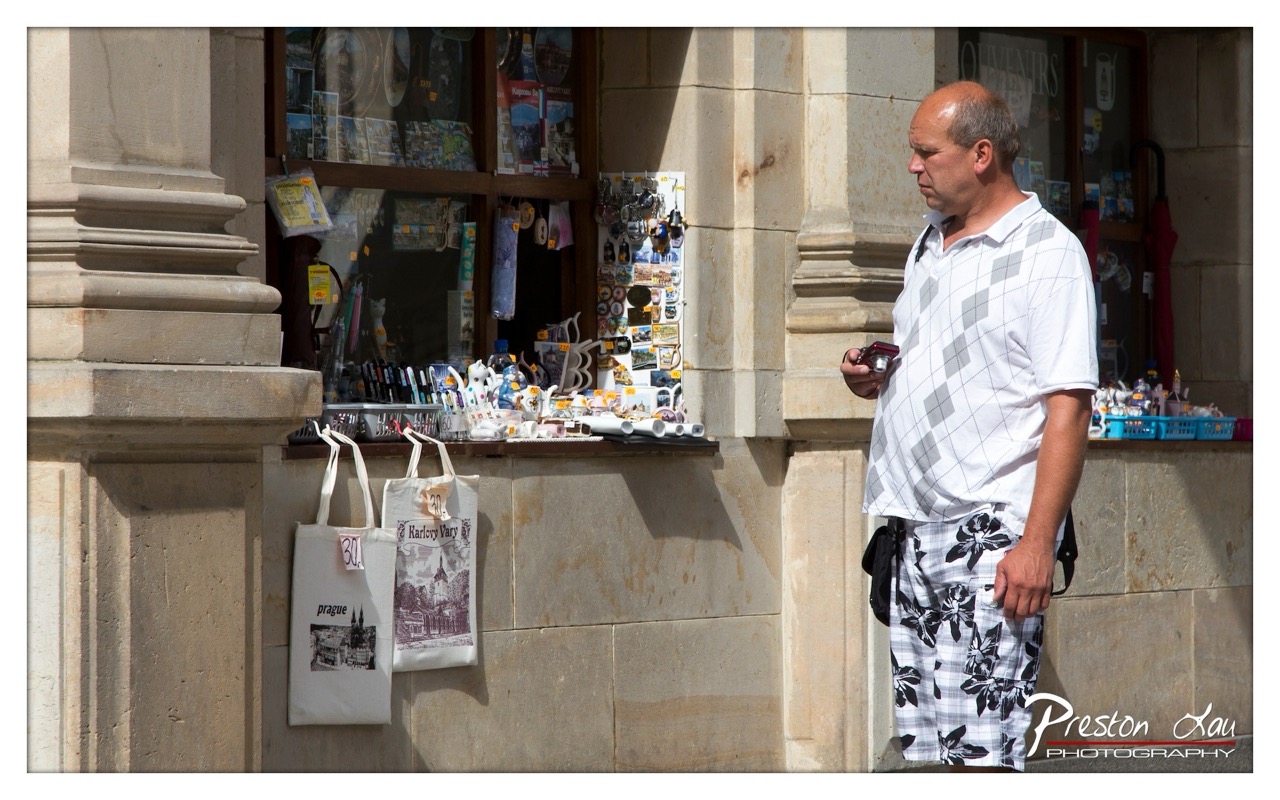

1. Overall Rating (0–10) — 6.8
This photograph captures a candid moment of a tourist browsing souvenirs in a sunlit European city, evoking the quiet rhythm of travel and place. The warm sunlight and textured stone architecture lend a sense of authenticity, while the man’s contemplative expression adds a human touch. While the image is well-composed and rich in context, it lacks a stronger emotional or visual hook, remaining more observational than transformative.
2. Composition (0–10) — 7.0
The subject is placed off-center, creating a balanced asymmetry that guides the eye across the frame. The stone column on the left provides a strong vertical anchor, while the display of souvenirs adds depth and narrative. The man’s gaze leads the viewer toward the window, enhancing the sense of discovery.
3. Lighting (0–10) — 7.5
Bright, direct sunlight casts sharp shadows and highlights the textures of the stone and merchandise, creating a vivid, daytime realism. The contrast between light and shadow adds dimension, though the harshness slightly flattens the subject’s features.
4. Color & Tone (0–10) — 6.5
The warm, neutral tones of the stone and the man’s white and black clothing create a cohesive palette. The muted blues and yellows of the souvenirs add subtle pops of color, but the overall tone remains restrained, limiting visual drama.
5. Creativity (0–10) — 6.0
The image tells a simple, relatable story of tourism and memory—capturing a moment without overt artistic manipulation. While effective in its documentation, it doesn’t push beyond the familiar, offering little surprise or conceptual depth.
6. Technical Quality (0–10) — 8.0
The focus is sharp, particularly on the man and the souvenirs, and the exposure is well-balanced. The image is clean, with minimal noise, and the photographer’s signature adds a professional touch.
7. Emotional Impact (0–10) — 6.0
The photograph conveys a sense of quiet contemplation and everyday life, but the emotional resonance is modest. The viewer is invited to observe, but not deeply moved, as the moment feels fleeting rather than profound.
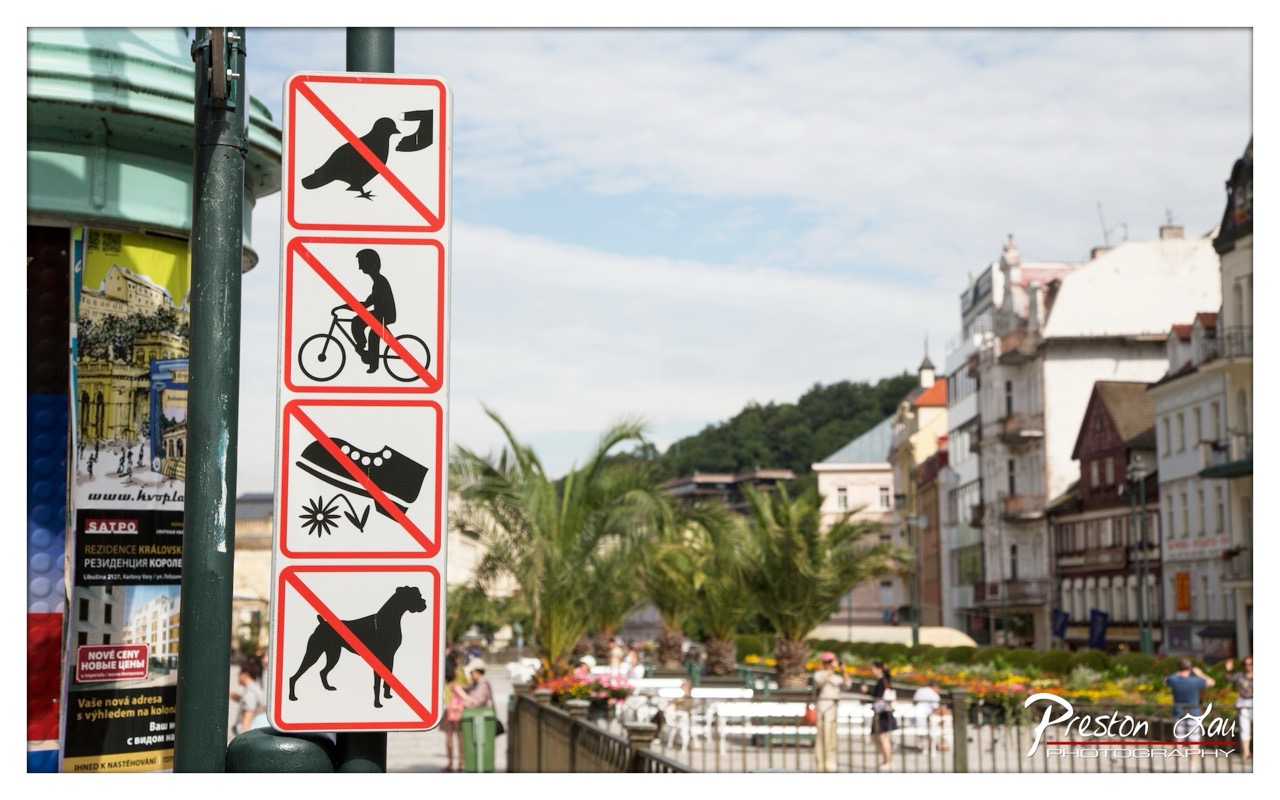

1. Overall Rating (0–10) — 7.0
This photograph captures a quiet urban moment with a subtle tension between order and spontaneity. The layered composition—featuring a prominent no-entry sign juxtaposed against a sunlit, bustling street—creates a narrative of regulation within a lively public space. While the shallow depth of field softens the background, it effectively draws attention to the symbolic signage, grounding the image in a specific cultural context. The scene feels authentic and unposed, though the lack of a strong focal point slightly diminishes its visual cohesion.
2. Composition (0–10) — 7.5
The vertical sign dominates the left side, creating a strong visual anchor, while the blurred background offers context without distraction. The diagonal line of the railing and palm trees guides the eye toward the center, balancing the frame. However, the sign’s position on the extreme left creates a slight imbalance, and the scattered elements in the background risk visual clutter.
3. Lighting (0–10) — 7.0
Natural daylight illuminates the scene evenly, with soft, diffused light that enhances the colors without harsh shadows. The overcast sky contributes to a gentle, even exposure, allowing details in both the sign and background to remain visible. The light complements the calm, everyday mood of the image.
4. Color & Tone (0–10) — 6.5
The palette is dominated by neutral whites and grays in the buildings, punctuated by the vibrant green of the palms and the bright red of the sign’s borders. While the colors are generally harmonious, the overall tone is somewhat muted, with a lack of saturation that prevents the image from feeling dynamic. The contrast between the sign’s bold red and the soft background is effective but not striking.
5. Creativity (0–10) — 7.0
The photograph demonstrates creative intent through the juxtaposition of restrictive signage against a relaxed, public environment. The choice to focus on the sign while blurring the background suggests a commentary on urban life and control. The inclusion of palm trees in a seemingly temperate European setting adds a layer of curiosity, inviting interpretation.
6. Technical Quality (0–10) — 8.0
The image is sharp on the sign, with clear detail in the symbols and text. The shallow depth of field is well-executed, creating a pleasing bokeh effect in the background. Focus is precise, and the exposure is balanced. The watermark is subtle and does not interfere with the image.
7. Emotional Impact (0–10) — 6.0
The image evokes a sense of mild curiosity and quiet observation. The viewer is invited to consider the rules and freedoms of public space, but the emotional resonance is restrained by the lack of a strong human element or narrative climax. It feels more like a snapshot than an emotionally charged moment.
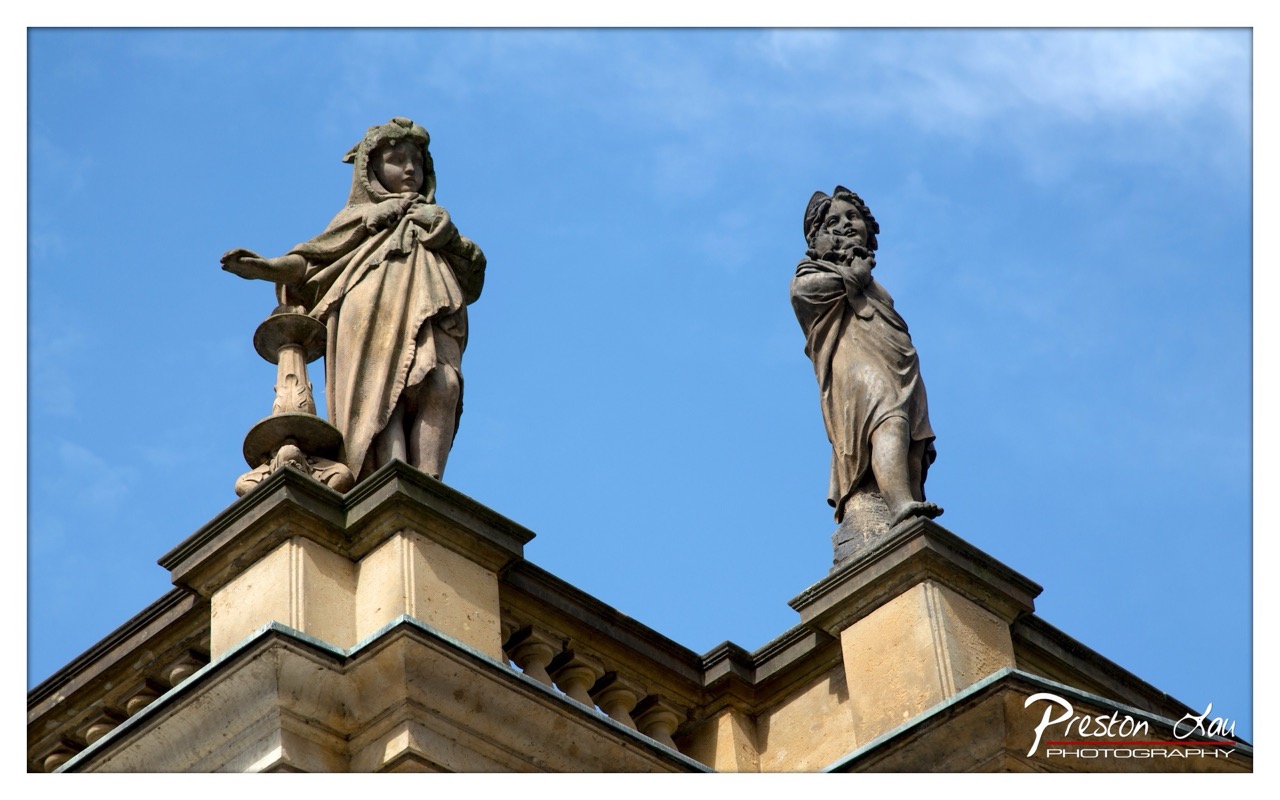

1. Overall Rating (0–10) — 7.5
This photograph captures the timeless elegance of two weathered stone statues perched atop a historic building, set against a vast, clear blue sky. The low-angle perspective imbues the figures with a sense of grandeur and permanence, while the crisp contrast between the aged stone and the vibrant sky enhances the image’s visual appeal. While the composition is strong and the subject inherently compelling, the slightly overexposed sky and minimal atmospheric depth prevent it from achieving a more transcendent quality.
2. Composition (0–10) — 8.0
The statues are positioned asymmetrically, creating a dynamic balance that draws the eye across the frame. The low angle emphasizes their verticality and dominance over the structure below, while the clean lines of the architecture provide a grounded counterpoint to the fluidity of the figures.
3. Lighting (0–10) — 7.0
Natural daylight illuminates the statues with even, soft light, highlighting their textures and contours. The bright sky, however, slightly flattens the tonal range and creates a slight overexposure at the top of the frame.
4. Color & Tone (0–10) — 8.0
The rich, saturated blue of the sky provides a striking contrast to the muted earth tones of the stone, creating a harmonious and visually arresting palette. The tonal range is well balanced, with the warm stone tones standing out clearly against the cool background.
5. Creativity (0–10) — 7.5
The choice to frame the statues from below and against the sky elevates them from mere architectural details to symbolic figures, suggesting themes of legacy and timelessness. The image is both observational and interpretive, inviting the viewer to contemplate the narrative behind the stonework.
6. Technical Quality (0–10) — 8.0
The image is sharp and well-focused, with fine detail visible in the statues’ drapery and features. The exposure is generally accurate, though the sky’s brightness suggests a slight overexposure in the highlights.
7. Emotional Impact (0–10) — 7.0
The photograph evokes a sense of awe and reverence, capturing the enduring presence of art and history. The quiet dignity of the statues against the open sky inspires reflection on the passage of time and the permanence of cultural memory.
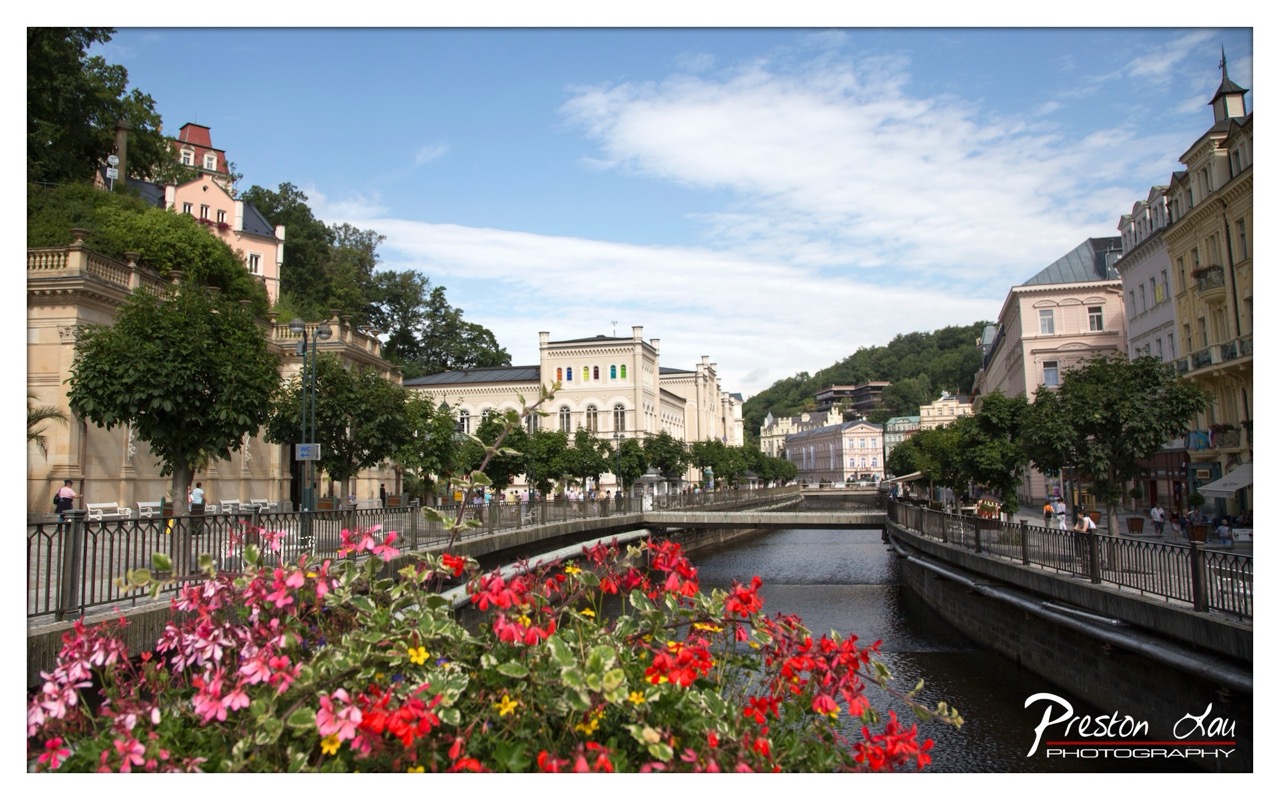

1. Overall Rating (0–10) — 7.5
This photograph captures the serene charm of a European riverside town, where vibrant flowers in the foreground frame a picturesque view of historic architecture and a calm waterway. The composition draws the eye naturally through the scene, with the colorful blooms adding a touch of life and warmth. While the image is visually rich and inviting, the slightly overexposed sky and uniform lighting prevent it from achieving a more dramatic or cinematic quality.
2. Composition (0–10) — 8.0
The foreground flowers create a natural leading edge, guiding the viewer’s gaze toward the central canal and the architectural focal point in the distance. The balanced framing and symmetrical placement of buildings on either side of the water enhance the sense of harmony and depth.
3. Lighting (0–10) — 6.5
The scene is illuminated by bright, even daylight, which clearly reveals architectural details and textures. However, the sky is slightly washed out, losing some of the subtle cloud detail, and the overall lighting lacks dynamic contrast, giving the image a somewhat flat appearance.
4. Color & Tone (0–10) — 8.0
The palette is rich and inviting, with the vivid reds and pinks of the flowers providing a striking contrast against the soft pastel tones of the buildings and the blue of the sky. The color saturation enhances the scene’s liveliness without appearing unnatural.
5. Creativity (0–10) — 7.0
The photographer uses the foreground flowers as a creative framing device, transforming a standard cityscape into a more intimate and inviting scene. The inclusion of the colorful windows on the central building adds a playful, whimsical touch that elevates the image beyond mere documentation.
6. Technical Quality (0–10) — 8.0
The image is sharp and well-focused, with clear detail visible in both the foreground and background. The exposure is generally well-managed, though the sky shows signs of slight overexposure. The watermark is clean and unobtrusive.
7. Emotional Impact (0–10) — 7.5
The photograph evokes a sense of peace and leisure, inviting the viewer to imagine strolling along the riverbank on a warm, sunny day. The combination of natural beauty and urban charm creates a mood of quiet contentment and nostalgia.
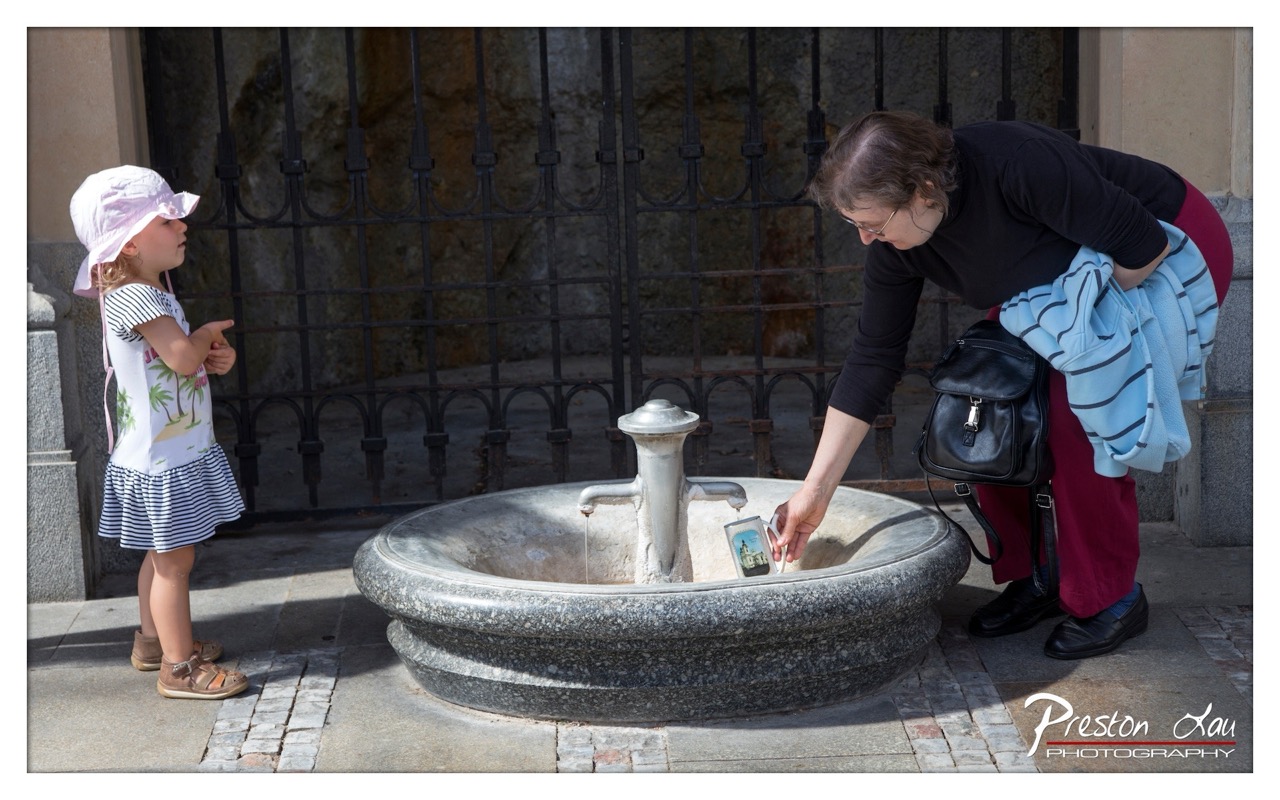

1. Overall Rating (0–10) — 7.0
This photograph captures a tender, candid moment between a child and an adult at a public fountain, evoking a sense of curiosity and intergenerational connection. The natural lighting and genuine interaction lend warmth and authenticity to the scene, while the stone fountain and wrought-iron gate provide a timeless, architectural backdrop. Though the composition is slightly cluttered by the surrounding elements, the emotional resonance of the moment elevates the image beyond a simple snapshot.
2. Composition (0–10) — 6.5
The subjects are well-placed, with the child on the left and the adult on the right creating a balanced visual flow. However, the framing feels slightly wide, with the stone pavement and gate taking up more space than necessary, which dilutes the focus on the interaction.
3. Lighting (0–10) — 7.5
Bright, natural daylight enhances the clarity and texture of the scene, casting soft shadows that add depth. The light highlights the subjects’ expressions and the fountain’s surface, creating a lively and inviting atmosphere.
4. Color & Tone (0–10) — 6.5
The palette is natural and restrained, with the muted tones of the stone and iron complementing the soft pastels of the child’s dress and hat. While the colors are harmonious, they lack vibrancy, giving the image a slightly subdued quality.
5. Creativity (0–10) — 7.0
The image captures a spontaneous, narrative-driven moment with a strong sense of place and time. The juxtaposition of the modern phone with the old-world fountain adds a subtle layer of commentary on memory and technology, enhancing the photograph’s storytelling potential.
6. Technical Quality (0–10) — 8.0
The image is sharp and well-focused, with clear details in both the foreground and background. The exposure is balanced, and the depth of field effectively draws attention to the subjects while maintaining context.
7. Emotional Impact (0–10) — 7.5
The viewer is drawn into a quiet, intimate exchange—curiosity, guidance, and shared discovery—all conveyed through body language and gaze. The emotional warmth of the interaction resonates deeply, creating a sense of connection that lingers beyond the frame.
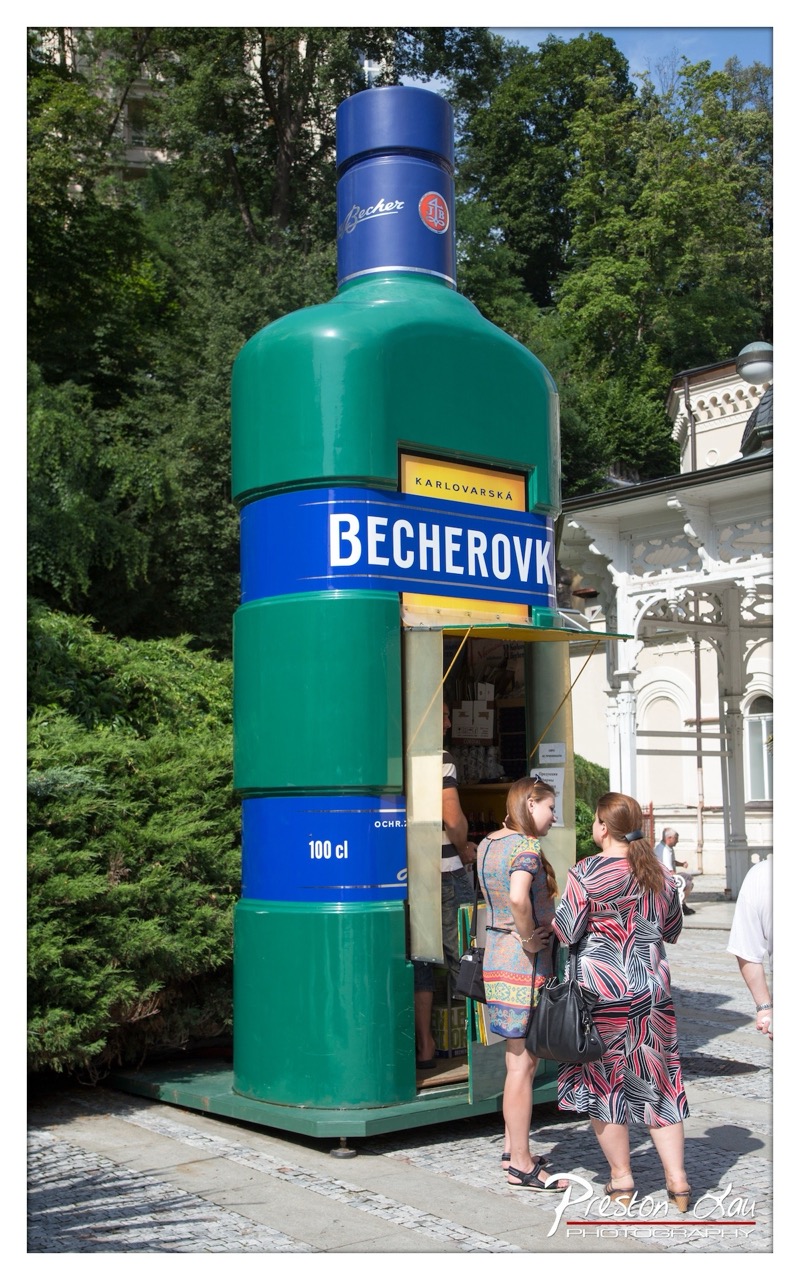

1. Overall Rating (0–10) — 7.0
This photograph captures a whimsical and culturally rich scene, where a life-sized Becherovka bottle functions as a bustling kiosk, blending advertising with public engagement. The vibrant green and blue of the bottle stand out against the lush trees and ornate white architecture, creating a visually engaging juxtaposition of modern branding and historic charm. While the image is strong in concept and color, the slightly cluttered foreground and casual framing reduce its overall compositional polish.
2. Composition (0–10) — 6.5
The towering bottle dominates the frame, creating a strong vertical axis that draws the eye upward, while the two women in the foreground add narrative interest and human scale. However, the composition feels slightly unbalanced due to the off-center placement of the kiosk and the presence of a partially cropped figure on the right, which disrupts visual flow.
3. Lighting (0–10) — 7.5
Natural daylight illuminates the scene evenly, enhancing the vividness of the bottle’s colors and casting soft shadows that add depth. The bright, clear sky contributes to a cheerful and lively mood, while the interplay of light and shadow on the cobblestone and foliage adds texture and dimension.
4. Color & Tone (0–10) — 8.0
The bold green and blue of the Becherovka bottle create a striking contrast against the verdant trees and the white architectural details, resulting in a vibrant and harmonious palette. The warm tones of the women’s dresses complement the scene without clashing, and the overall color balance feels natural and inviting.
5. Creativity (0–10) — 8.5
The concept of transforming a bottle into a functional kiosk is highly original and memorable, turning a commercial object into a public attraction. The photograph captures not just a product, but a cultural moment—showcasing how branding can become part of a city’s public life in a playful and engaging way.
6. Technical Quality (0–10) — 8.0
The image is sharp and well-focused, with clear details in the bottle’s branding, the textures of the cobblestones, and the fabric of the women’s clothing. The exposure is well-handled, with no blown-out highlights or crushed shadows, and the depth of field is appropriate for a street scene.
7. Emotional Impact (0–10) — 7.0
The photograph evokes a sense of curiosity and delight, inviting the viewer to imagine stepping into the kiosk and tasting a sample of the famous Czech herbal liqueur. The presence of people adds a layer of warmth and everyday life, making the scene feel accessible and inviting, though the emotional resonance is somewhat tempered by the commercial nature of the subject.
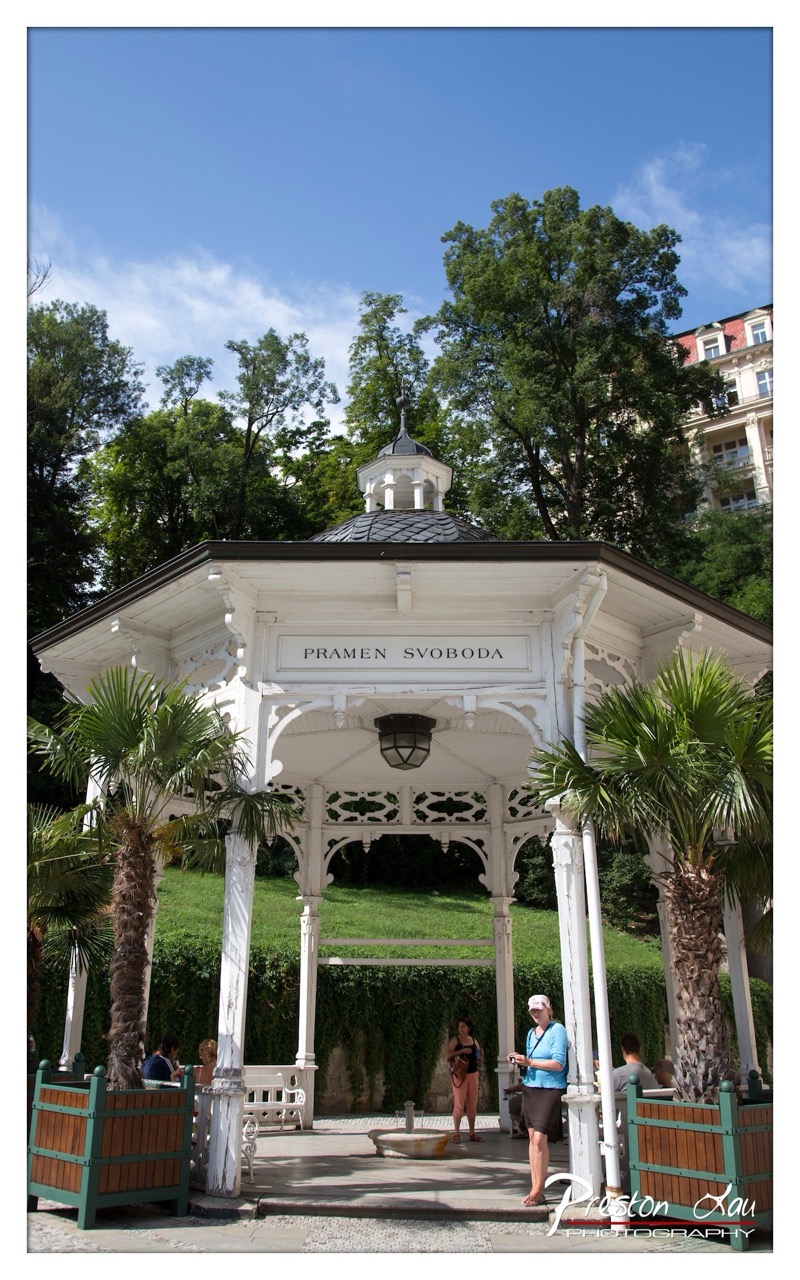

1. Overall Rating (0–10) — 7.0
This photograph captures a serene and elegant garden pavilion under a vibrant blue sky, evoking a sense of leisure and European charm. The white gazebo, framed by lush greenery and palm trees, stands as a focal point of refined architecture, while the presence of visitors adds a subtle human element. Though the composition is strong, the image is slightly hindered by a cluttered background and a watermark that detracts from its visual harmony.
2. Composition (0–10) — 7.0
The gazebo is well-centered, drawing the eye upward with its ornate structure, while the surrounding foliage and palm trees frame the scene naturally. The low-angle perspective enhances the pavilion’s grandeur, though the building partially obscured by trees on the right slightly disrupts the balance.
3. Lighting (0–10) — 8.0
Bright, natural daylight illuminates the scene, creating crisp highlights on the white architecture and casting soft shadows that add depth. The clear blue sky provides a vivid backdrop, enhancing the image’s clarity and reinforcing a cheerful, sunny atmosphere.
4. Color & Tone (0–10) — 7.5
The palette is harmonious, with the white of the gazebo contrasting beautifully against the deep greens of the trees and the vibrant blue sky. The tones are well-saturated, though the slight coolness of the white structure slightly mutes the warmth of the scene.
5. Creativity (0–10) — 7.0
The photograph captures a classic, picturesque moment with a sense of place and atmosphere. While the subject is familiar, the low-angle framing and inclusion of people lend a narrative quality, suggesting a quiet day in a public garden.
6. Technical Quality (0–10) — 8.0
The image is sharp and detailed, with clean focus across the main elements. The exposure is well-balanced, preserving detail in both the highlights and shadows, though the watermark in the lower right corner slightly reduces the overall aesthetic cleanliness.
7. Emotional Impact (0–10) — 7.5
The image conveys a sense of peace and leisure, inviting the viewer to imagine strolling through a tranquil garden on a warm day. The combination of architectural beauty and natural surroundings evokes nostalgia and calm, though the presence of modern visitors tempers the timeless quality.
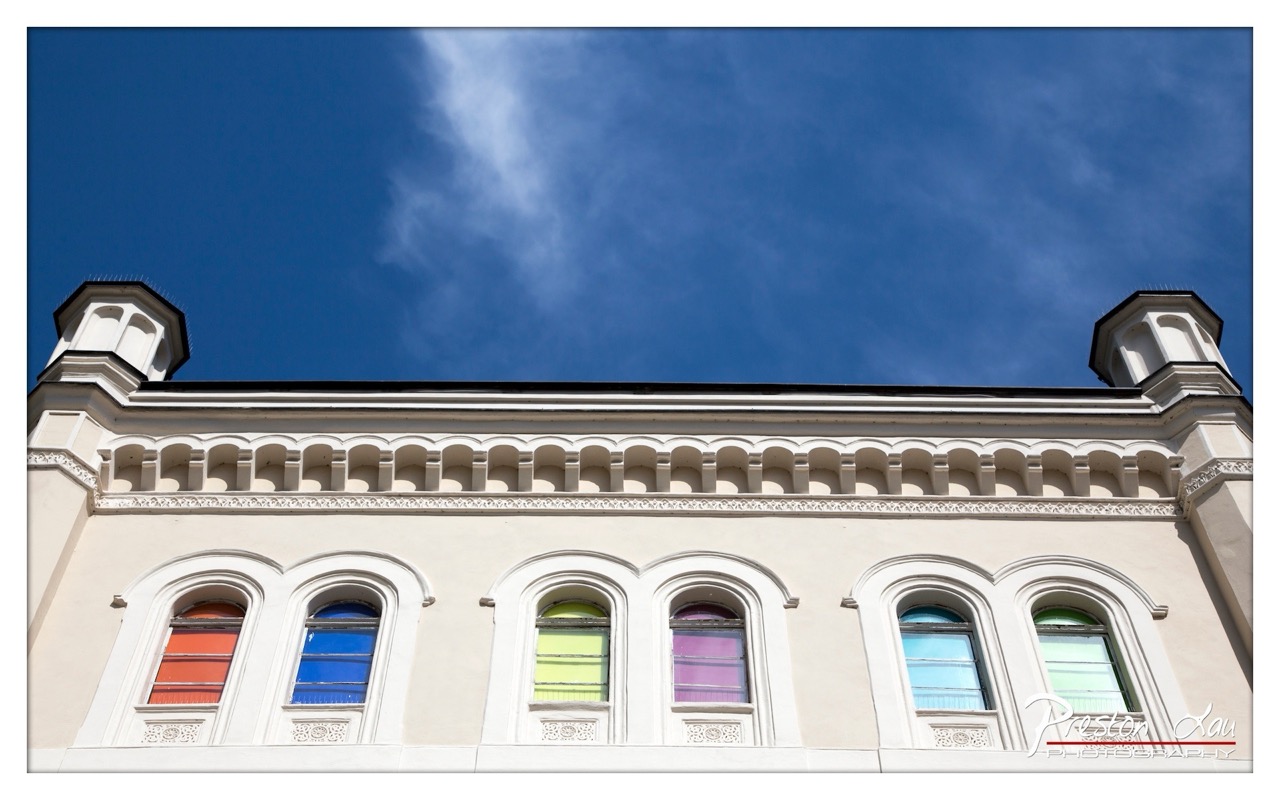

1. Overall Rating (0–10) — 8.0
This photograph captures a striking architectural detail against a vast, vibrant sky, where the interplay of color and form creates a visually arresting composition. The bold, stained-glass windows inject a sense of whimsy and warmth into the otherwise classical façade, while the deep blue sky provides a dramatic backdrop. Though the image is strong in mood and color, it is slightly restrained by a lack of dynamic perspective or narrative depth, keeping it more as a celebration of form than a profound statement.
2. Composition (0–10) — 8.0
The low-angle shot emphasizes the building’s grandeur, while the symmetrical arrangement of the arched windows creates visual rhythm and balance. The expansive sky dominates the upper half, providing negative space that enhances the structure’s elegance and draws the eye upward.
3. Lighting (0–10) — 9.0
Bright, direct sunlight enhances the vividness of the stained-glass colors and casts subtle shadows that define the architectural details. The clarity and intensity of the light give the image a crisp, celebratory feel, perfectly complementing the subject.
4. Color & Tone (0–10) — 9.0
The palette is rich and harmonious, with the saturated hues of the windows—red, blue, green, purple—contrasting beautifully against the warm beige of the building and the deep blue of the sky. The tonal range is well-balanced, with a strong visual impact that feels both playful and refined.
5. Creativity (0–10) — 8.0
The juxtaposition of vibrant, colorful windows within a traditionally restrained architectural style introduces an element of surprise and artistic playfulness. The photographer’s choice to highlight this contrast suggests an intent to explore the intersection of tradition and modern expression.
6. Technical Quality (0–10) — 9.0
The image is sharp and well-focused, with excellent detail in both the architectural elements and the sky. The exposure is clean and balanced, and the watermark is unobtrusive, indicating professional execution.
7. Emotional Impact (0–10) — 7.5
The photograph evokes a sense of joy and wonder, inviting the viewer to pause and appreciate the beauty in unexpected details. The brightness and color spark delight, though the emotional resonance is more fleeting than profound, leaning toward aesthetic pleasure rather than deep introspection.


1. Overall Rating (0–10) — 7.0
This photograph captures the vibrant energy of a European riverside city, where historic architecture and modern life converge in a harmonious rhythm. The layered composition draws the eye from the foreground bridge to the densely packed buildings rising up the hillside, creating a sense of depth and narrative. While the image is rich in detail and atmosphere, the slightly overexposed sky and uneven lighting slightly undermine its visual cohesion, holding it back from true mastery.
2. Composition (0–10) — 7.5
The bridge in the foreground provides a strong horizontal anchor, while the diagonal sweep of the river and the ascending buildings create dynamic movement. The couple walking across the bridge adds a human element without distracting from the architectural grandeur.
3. Lighting (0–10) — 6.0
Harsh midday sunlight creates strong contrasts and deep shadows, particularly on the buildings, which flattens some textures. The bright sky is slightly overexposed, reducing detail in the upper portion of the frame.
4. Color & Tone (0–10) — 6.5
The palette is warm and inviting, with earthy yellows and soft pastels dominating the buildings. However, the overall tone leans slightly cool due to the strong daylight, and some colors appear washed out, especially in the sky and foliage.
5. Creativity (0–10) — 7.0
The juxtaposition of lush palm trees against the classical European backdrop introduces an unexpected element, suggesting a unique cultural fusion. The photographer captures a moment that feels both authentic and picturesque, blending documentary realism with aesthetic intention.
6. Technical Quality (0–10) — 7.5
The image is sharp and detailed, particularly in the mid-ground architecture and the ornate railings. The focus is well-managed, and the depth of field effectively separates the foreground from the background.
7. Emotional Impact (0–10) — 6.5
The scene evokes a sense of peaceful urban life, inviting the viewer to wander through the streets and imagine the stories behind the facades. The presence of people adds warmth and scale, but the emotional resonance is somewhat muted by the lack of dramatic lighting or a more compelling focal point.
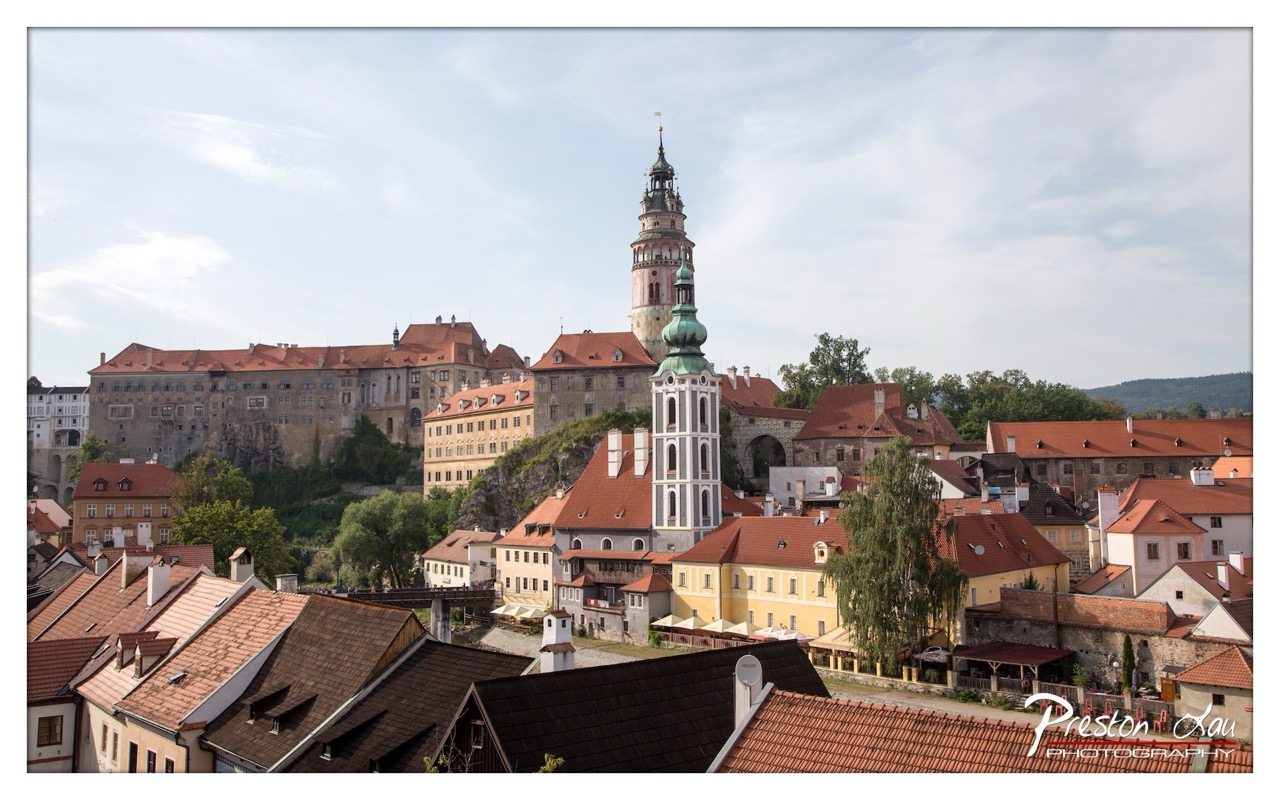

1. Overall Rating (0–10) — 7.5
This panoramic view of a historic European town captures a harmonious blend of architectural grandeur and everyday life, evoking a sense of timeless charm. The composition draws the eye naturally toward the towering church spire and the castle perched above, while the warm terracotta rooftops create a rhythmic visual pattern. While the scene is visually rich, the slightly overexposed sky and modest color saturation temper its emotional depth, keeping it grounded in realism rather than transcendence.
2. Composition (0–10) — 8.0
The layered arrangement of rooftops, trees, and buildings creates a strong sense of depth, with the church spire serving as a compelling focal point. The framing effectively balances foreground, midground, and background, guiding the viewer’s gaze upward toward the castle.
3. Lighting (0–10) — 7.0
Soft, diffused daylight enhances the textures of the stone and tile without creating harsh shadows. The slightly overcast sky lends a gentle quality to the light, though it slightly flattens the contrast and mood.
4. Color & Tone (0–10) — 7.5
The warm tones of the red and orange rooftops contrast beautifully with the pale stone and green spire, creating a balanced and inviting palette. The overall tone is natural and cohesive, with subtle saturation that enhances the scene’s authenticity.
5. Creativity (0–10) — 7.0
The image captures a classic architectural vista with a clear sense of place, but its strength lies in documentation rather than bold artistic interpretation. The framing and timing are skillful, but the approach remains conventional.
6. Technical Quality (0–10) — 8.5
Sharp focus across the frame, accurate exposure, and clean detail contribute to a technically strong image. The watermark is discreet and does not detract from the composition.
7. Emotional Impact (0–10) — 7.0
The photograph conveys a quiet nostalgia and reverence for history, inviting the viewer to imagine life in a centuries-old town. While not emotionally overwhelming, it succeeds in evoking a sense of peaceful continuity and cultural richness.


1. Overall Rating (0–10) — 7.5
This photograph captures a quiet, contemplative moment, where the aged bell and textured stone evoke a sense of history and stillness. The framing through the stone arch creates a natural vignette, drawing the eye to the central subject while the soft-focus tower in the background adds depth and context. While the image is strong in mood and composition, it feels slightly restrained in color and lighting, holding back from full emotional resonance.
2. Composition (0–10) — 8.0
The bell is perfectly centered within the arch, creating a balanced and harmonious frame. The use of leading lines from the stone columns and the diagonal support rods enhances focus and guides the viewer’s gaze naturally to the subject.
3. Lighting (0–10) — 6.5
Soft, diffused daylight evenly illuminates the scene, minimizing harsh shadows and highlighting the texture of the stone. The bright sky creates a subtle backlight, adding dimension to the bell, though the lack of strong directional light keeps the image from feeling dynamic.
4. Color & Tone (0–10) — 6.0
The palette is muted and natural, dominated by earthy tones of stone and dark metal. While the colors are accurate, they lack vibrancy and contrast, giving the image a somewhat flat appearance that detracts from its potential visual impact.
5. Creativity (0–10) — 7.0
The photographer uses the architectural elements creatively to frame the bell, turning a simple subject into a symbolic and layered image. The inclusion of the distant tower adds narrative depth, suggesting a place of tradition and continuity.
6. Technical Quality (0–10) — 8.0
The image is sharp and well-focused, with clear detail in the bell and stone textures. The exposure is balanced, and the watermark is discreet, preserving the integrity of the composition.
7. Emotional Impact (0–10) — 7.0
There’s a quiet dignity in the stillness of the scene—evoking nostalgia and reverence. The aged bell and weathered stone suggest the passage of time, inviting the viewer to reflect, though the emotional pull is subtle rather than powerful.


1. Overall Rating (0–10) — 7.0
This photograph captures the energy and camaraderie of a group navigating a river in an inflatable raft, with natural sunlight enhancing the sense of motion and adventure. The dynamic water and engaged expressions convey a moment of shared experience, though the slightly cluttered arrangement of subjects and gear detracts from visual clarity. The image succeeds as a lively document of outdoor activity, balancing action with authenticity.
2. Composition (0–10) — 6.5
The raft is centered but slightly low in the frame, creating an uneven balance with the surrounding water. The overlapping figures and oars create visual complexity, but the composition remains engaging due to the natural movement of the raft through the current.
3. Lighting (0–10) — 8.0
Bright, natural daylight illuminates the scene, enhancing the texture of the water and highlighting the expressions of the participants. The reflections on the ripples add depth and a sense of realism.
4. Color & Tone (0–10) — 7.5
The cool blue of the raft contrasts with the earthy brown of the river, creating a visually balanced palette. The vibrant colors of the participants’ clothing add pops of energy, while the overall tone remains natural and cohesive.
5. Creativity (0–10) — 7.0
The image captures a candid, action-filled moment with strong narrative potential. While the concept is straightforward, the photographer successfully conveys the excitement of whitewater rafting through timing and composition.
6. Technical Quality (0–10) — 8.0
Sharp focus on the subjects, with clear detail in the water and facial expressions. The high resolution and clean exposure contribute to a polished, professional appearance.
7. Emotional Impact (0–10) — 7.5
The image evokes a sense of adventure, teamwork, and joy, drawing the viewer into the experience. The smiles and focused expressions create a connection, making the moment feel both personal and universal.
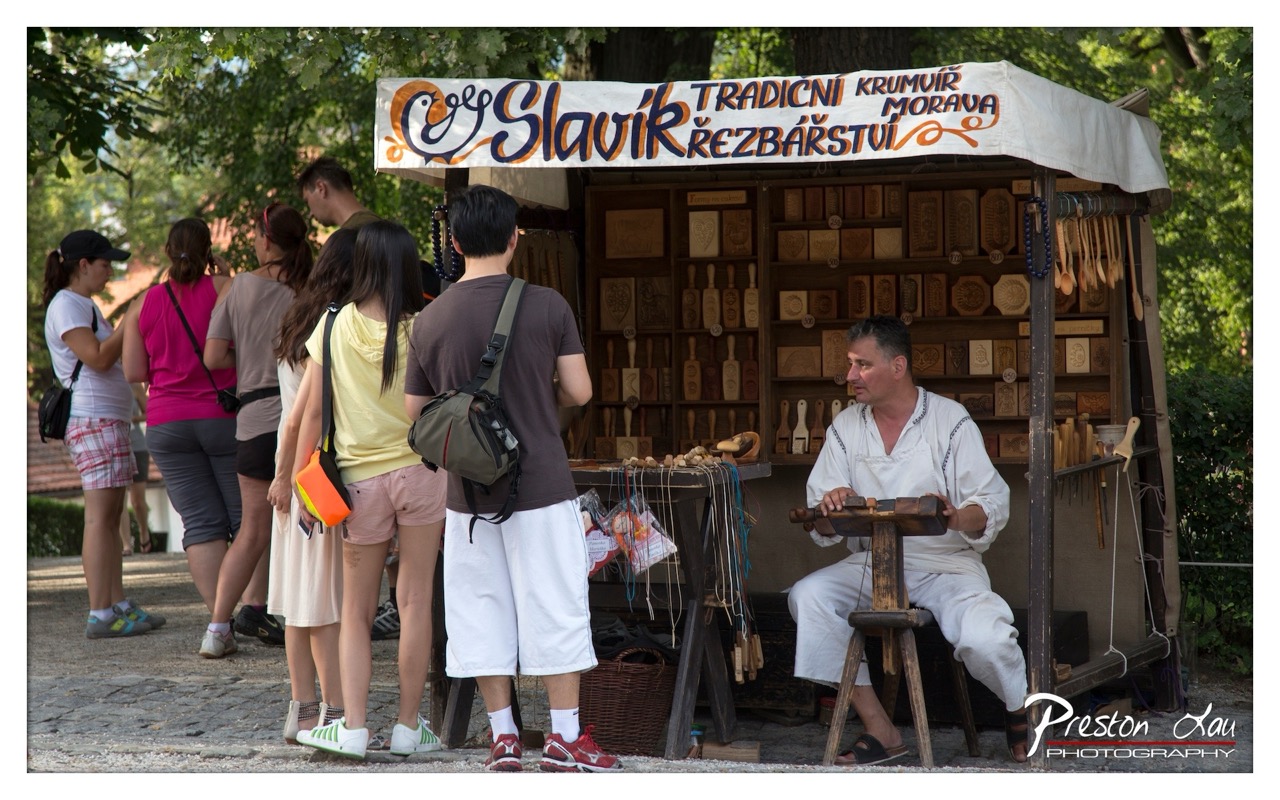

1. Overall Rating (0–10) — 7.5
This photograph captures a vibrant slice of cultural tradition, where the artisan’s quiet focus contrasts with the bustling curiosity of passersby. The scene is rich with narrative—craftsmanship, heritage, and modern tourism intersecting under a sun-dappled canopy. While the composition feels slightly busy, the authenticity of the moment and the warmth of the lighting lend it a compelling, documentary-like charm.
2. Composition (0–10) — 7.0
The framing balances the artisan at the right with the queue of visitors on the left, creating visual tension and narrative depth. The overhead sign provides a strong horizontal element, anchoring the image, though the foreground crowd slightly disrupts the viewer’s eye path.
3. Lighting (0–10) — 8.0
Natural daylight filters through the trees, casting soft, dappled light that enhances the textures of wood and fabric. The warm tone of the sunlight complements the earthy palette and adds a sense of liveliness to the scene.
4. Color & Tone (0–10) — 7.5
The warm, natural tones of the wooden crafts and the artisan’s white clothing stand out against the cooler greens and grays of the surroundings. The color palette feels cohesive and inviting, with a subtle richness that reflects the authenticity of the setting.
5. Creativity (0–10) — 7.0
The image tells a story of cultural preservation in a contemporary context, blending tradition and tourism with quiet poignancy. While not radically inventive, the photographer captures a moment that feels both spontaneous and meaningful.
6. Technical Quality (0–10) — 8.0
Sharp focus across the frame, clean exposure, and good detail in both the foreground and background elements indicate strong technical execution. The depth of field is well-managed, keeping the artisan and the crafts in focus.
7. Emotional Impact (0–10) — 7.0
There’s a quiet dignity in the artisan’s expression and posture, evoking respect for tradition. The curiosity of the onlookers adds a layer of human connection, inviting viewers to reflect on the value of cultural craftsmanship in a modern world.
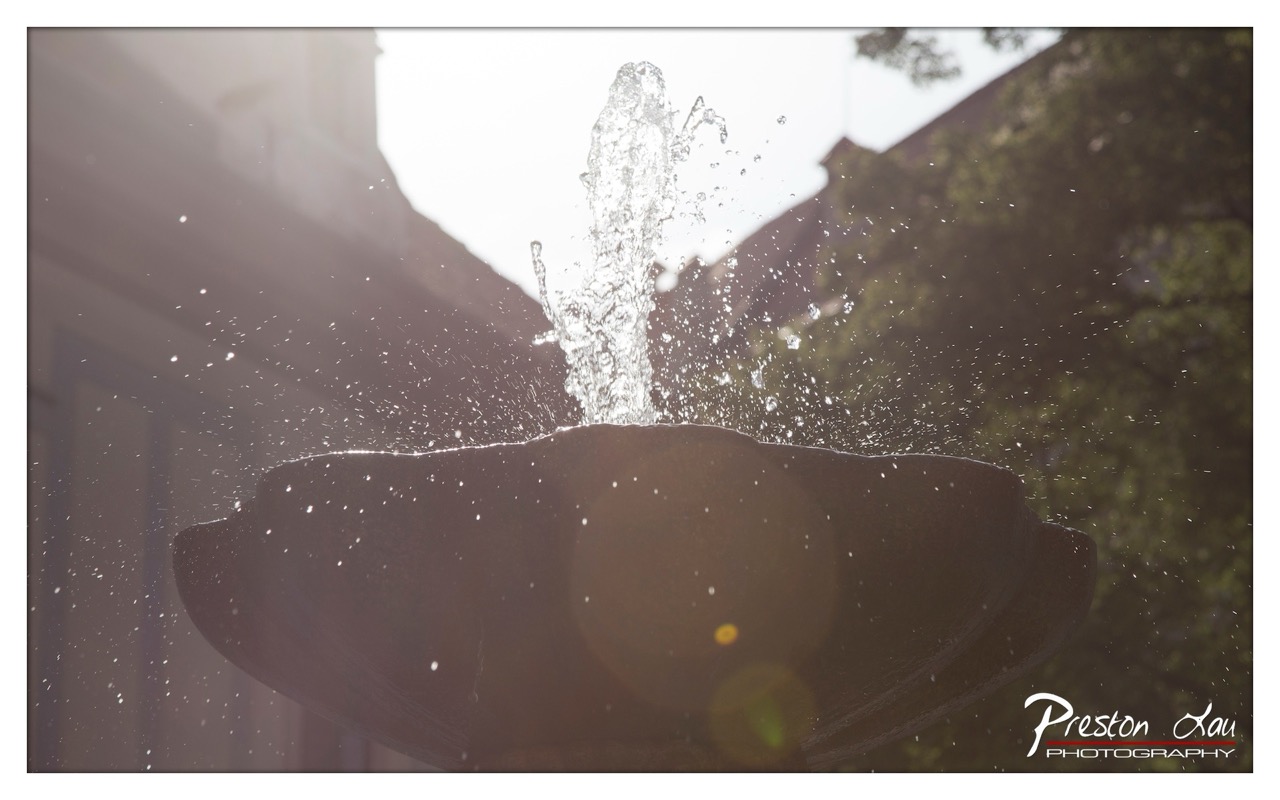

1. Overall Rating (0–10) — 7.5
This photograph captures the dynamic energy of a fountain in a sun-drenched moment, where water becomes both subject and medium for light. The interplay of backlighting and spray creates a luminous, almost ethereal effect, drawing the eye to the center of motion. While the image succeeds in conveying a sense of life and movement, the slightly overexposed sky and heavy lens flare temper its overall refinement.
2. Composition (0–10) — 7.0
The fountain’s basin anchors the frame at the lower third, creating a strong visual base, while the upward jet of water draws the eye toward the center. The off-center placement of the water jet adds asymmetry, enhancing the sense of spontaneity. However, the background elements—buildings and foliage—are slightly distracting, suggesting a tighter crop could improve focus.
3. Lighting (0–10) — 8.5
The strong backlighting is the image’s greatest strength, transforming water droplets into sparkling highlights and creating a glowing rim around the fountain’s edge. The lens flare, while prominent, adds a dreamy, atmospheric quality that aligns with the photograph’s mood. The exposure on the water is well-managed, though the sky is slightly overexposed.
4. Color & Tone (0–10) — 7.0
The palette is subdued, dominated by warm sepia tones and soft greens, lending the image a nostalgic, vintage feel. The lack of vibrant color keeps the focus on texture and light, though a subtle increase in contrast or saturation could enhance the water’s clarity and the overall visual depth.
5. Creativity (0–10) — 8.0
The photographer’s choice to shoot against the sun and embrace lens flare demonstrates a bold, artistic intent. This is not just a documentation of a fountain, but an interpretation of light and motion, capturing a fleeting moment with poetic sensitivity.
6. Technical Quality (0–10) — 7.5
Sharp focus on the water jet and the fountain’s edge is well-executed, with fine detail visible in the droplets. The exposure is generally balanced, though the overexposed sky suggests a slight challenge in dynamic range. The watermark is unobtrusive and professionally placed.
7. Emotional Impact (0–10) — 8.0
There is a quiet joy in the image—the feeling of a warm afternoon, sunlight dancing on water, a moment suspended in time. The viewer is invited to pause and appreciate the beauty in everyday motion, evoking a sense of calm and wonder.
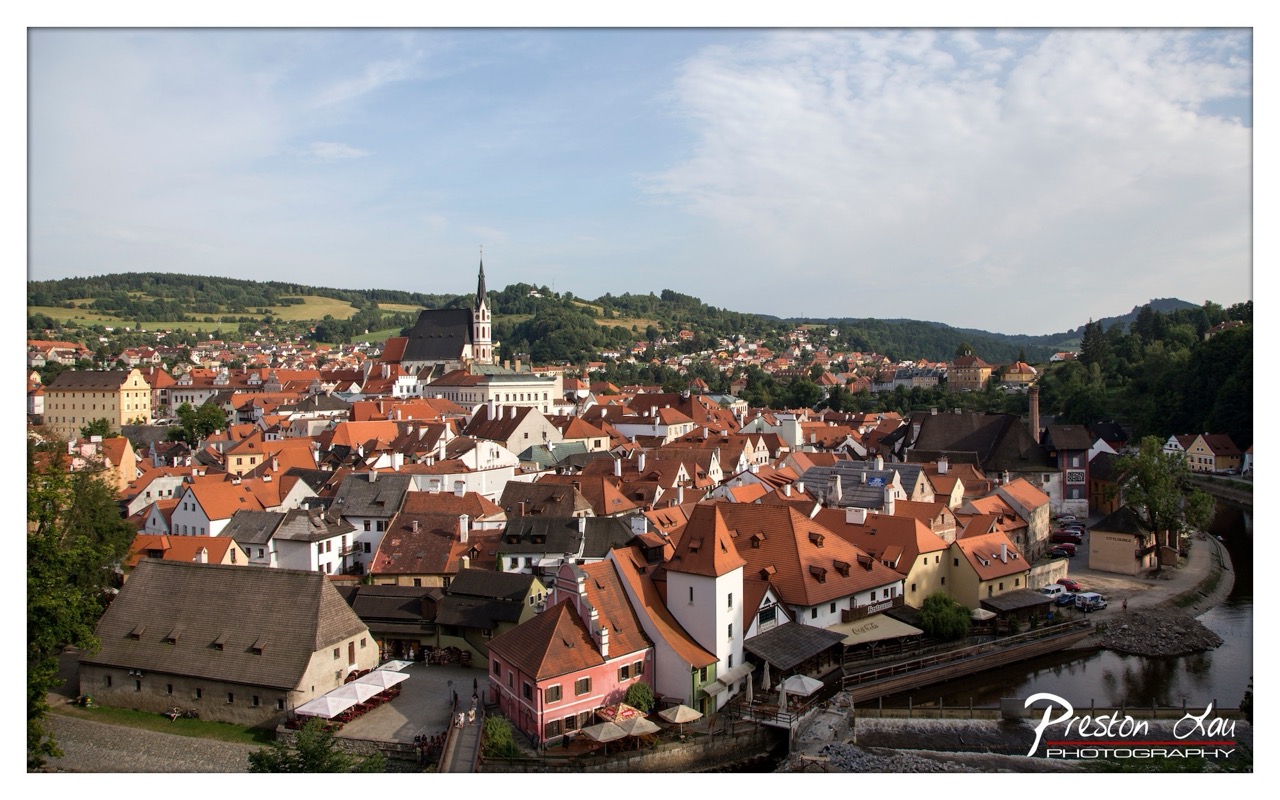

1. Overall Rating (0–10) — 7.5
This panoramic view of a European riverside town captures the harmony of history and nature with a quiet elegance. The warm terracotta roofs and the steepled church create a visually cohesive rhythm, while the soft light and rolling hills lend a timeless, almost nostalgic quality. While the image is beautifully composed, its emotional resonance is slightly tempered by a lack of dramatic contrast or narrative focus, making it more a picturesque record than a compelling story.
2. Composition (0–10) — 8.0
The wide-angle perspective offers a balanced and layered view, with the river and foreground structures leading the eye toward the central church and distant hills. The framing is strong, using natural elements to guide the gaze and create depth, though the slight asymmetry in the lower right edge introduces a minor visual imbalance.
3. Lighting (0–10) — 7.5
Soft, diffused daylight enhances the scene’s warmth and clarity, avoiding harsh shadows while still giving depth to the buildings and landscape. The light is consistent and flattering, suggesting either early morning or late afternoon, which supports the tranquil mood.
4. Color & Tone (0–10) — 8.0
The palette is rich yet harmonious, with earthy reds and oranges of the rooftops contrasting gently against the greens of the hills and the pale blue of the sky. The tonal range is well-balanced, with subtle gradients in the clouds adding atmospheric depth.
5. Creativity (0–10) — 7.0
The image succeeds as a traditional landscape photograph, capturing the essence of a historic town with clarity and reverence. While not overtly experimental, it demonstrates a strong sense of place and aesthetic intention, with a subtle emphasis on architectural and natural harmony.
6. Technical Quality (0–10) — 8.5
Sharp focus across the frame, excellent clarity, and clean detail in both the foreground and background indicate a high level of technical execution. The exposure is well-managed, with no blown highlights or lost shadows, and the watermark is unobtrusive.
7. Emotional Impact (0–10) — 7.5
The photograph evokes a sense of peace and timelessness, inviting contemplation of a place where life moves at a slower pace. While it doesn’t elicit intense emotion, its quiet beauty resonates with a quiet nostalgia and appreciation for enduring beauty.
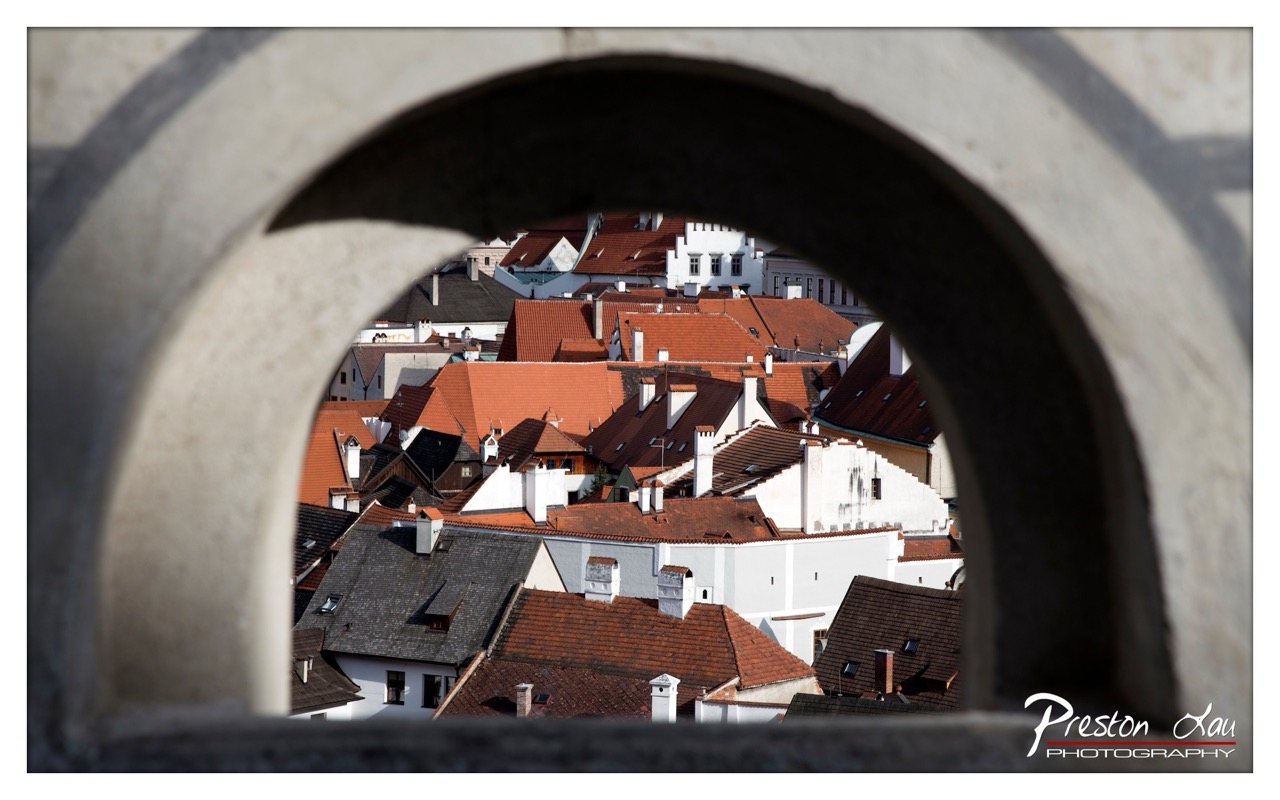

1. Overall Rating (0–10) — 7.5
This photograph masterfully uses a architectural frame to draw the viewer into a timeless European cityscape, where the interplay of light and shadow gives depth to the dense cluster of rooftops. The archway acts as a natural vignette, enhancing the sense of discovery and historical immersion. While the image is visually compelling, its emotional resonance is slightly tempered by the overexposed highlights on the white walls, which reduce tonal subtlety.
2. Composition (0–10) — 8.0
The circular arch frames the scene with deliberate symmetry, guiding the eye toward the center where the rooftops converge. The framing creates a strong sense of depth, while the diagonal arrangement of the buildings adds visual interest and balance.
3. Lighting (0–10) — 7.0
Bright, direct sunlight enhances the textures of the terracotta tiles and casts sharp shadows, creating contrast and dimension. However, some areas of the white facades are overexposed, losing detail and slightly flattening the overall tonal range.
4. Color & Tone (0–10) — 7.5
The warm, earthy tones of the red and brown tiles contrast beautifully with the crisp white walls and deep shadows, creating a rich, Mediterranean palette. The color balance is natural and harmonious, reinforcing the image’s historic charm.
5. Creativity (0–10) — 8.0
The use of the arch as a framing device is both clever and evocative, transforming a simple city view into a narrative moment. The perspective invites the viewer to imagine themselves in the location, adding a layer of storytelling that elevates the image beyond mere documentation.
6. Technical Quality (0–10) — 8.0
The image is sharp and well-focused, with fine detail visible in both the foreground arch and the distant buildings. The depth of field is appropriate, keeping the central scene clear while gently softening the edges.
7. Emotional Impact (0–10) — 7.0
The photograph evokes a sense of nostalgia and quiet contemplation, as if capturing a fleeting moment of peace in a bustling old town. The framing and lighting combine to create a feeling of intimacy and discovery, though the lack of human presence keeps the emotional connection subtle.
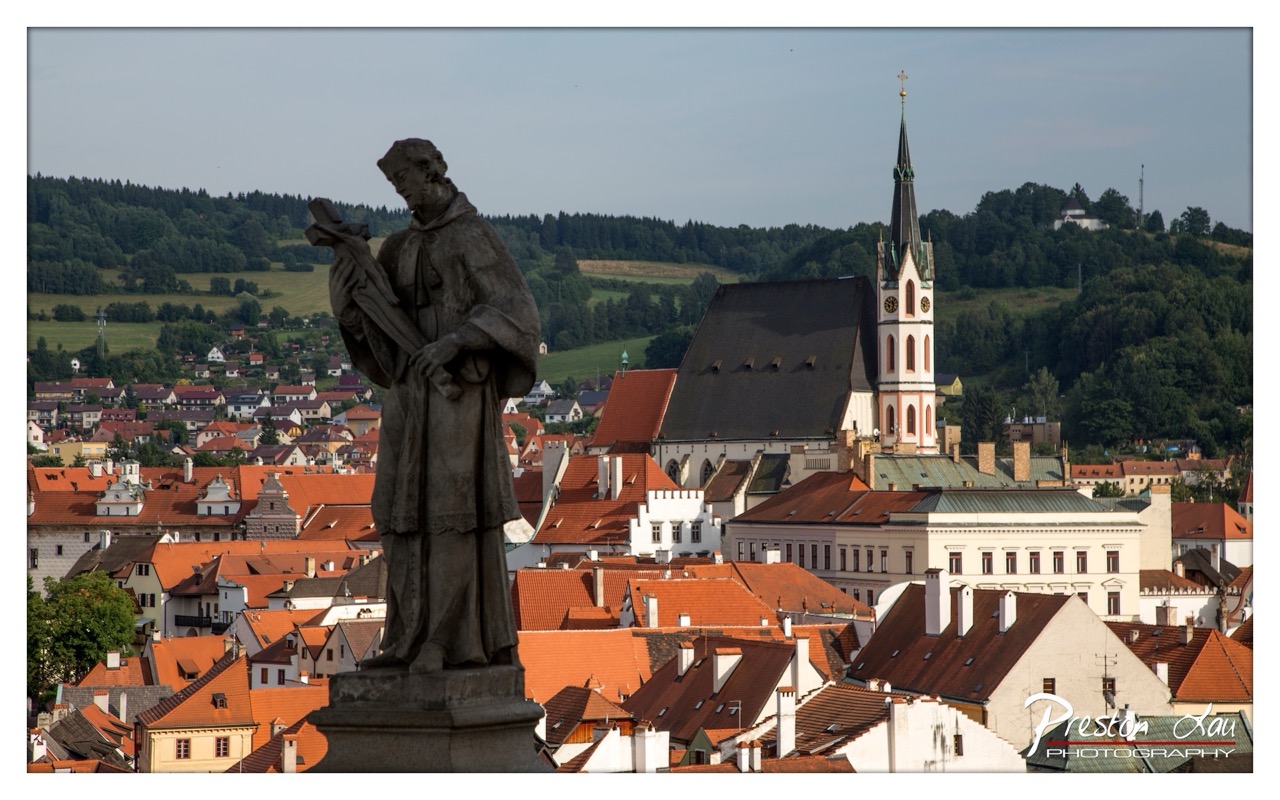

1. Overall Rating (0–10) — 7.5
This photograph captures the timeless charm of a European town, with a weathered statue standing as a silent guardian over a sea of terracotta rooftops. The interplay between the historic figure in the foreground and the church spire rising in the distance creates a sense of continuity and reverence. While the image is rich in detail and narrative potential, the muted sky and slightly overcast light temper its emotional punch, keeping it from achieving true grandeur.
2. Composition (0–10) — 8.0
The statue anchors the left side of the frame, creating a strong diagonal that leads the eye toward the church and the rolling hills beyond. The rooftops form a textured tapestry that fills the midground, balancing the composition and enhancing depth.
3. Lighting (0–10) — 6.5
Soft, diffused light from an overcast sky minimizes harsh shadows, allowing for even exposure across the scene. However, the lack of direct sunlight or golden-hour warmth reduces the atmospheric drama, giving the image a more documentary feel.
4. Color & Tone (0–10) — 7.0
The warm terracotta of the rooftops contrasts beautifully with the cool tones of the statue and the pale sky. The color palette is harmonious and historically evocative, though slightly desaturated, which softens the overall visual impact.
5. Creativity (0–10) — 7.5
The choice to frame the view through a statue adds narrative depth, transforming a standard cityscape into a contemplative moment. The juxtaposition of the sacred figure with the living town creates a subtle metaphor for time and faith.
6. Technical Quality (0–10) — 8.0
The image is sharp and detailed, with clean focus across the frame. The depth of field is well-managed, allowing both the foreground statue and distant architecture to remain crisp and clear.
7. Emotional Impact (0–10) — 7.0
The photograph evokes a sense of quiet reverence and historical continuity, inviting reflection on the passage of time. While not emotionally overwhelming, it resonates with a subtle, enduring calm.
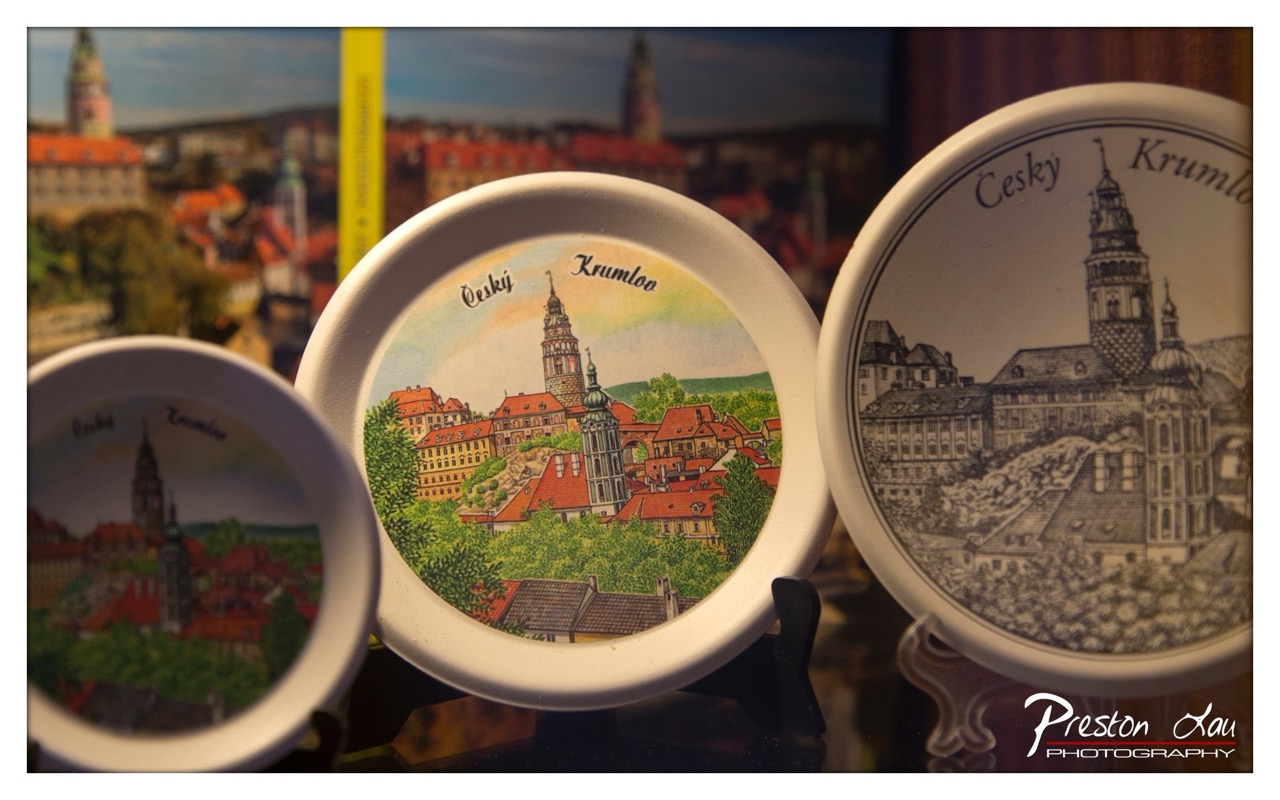

1. Overall Rating (0–10) — 7.0
This photograph captures the nostalgic charm of souvenir memorabilia, with three decorative plates showcasing different artistic interpretations of Český Krumlov’s historic skyline. The warm, ambient lighting enhances the vintage feel, while the layered composition creates a sense of depth and storytelling. The image succeeds in evoking a sense of place and memory, though the slightly cluttered arrangement and soft focus on the background reduce its overall visual cohesion.
2. Composition (0–10) — 6.5
The diagonal arrangement of the plates creates a dynamic flow, guiding the eye from left to right. However, the shallow depth of field and the blurred background distract slightly from the intended focus on the plates’ details, making the scene feel less balanced.
3. Lighting (0–10) — 7.0
Warm, directional lighting highlights the texture and design of the plates, creating a cozy, intimate atmosphere. The soft glow enhances the colors and shadows, giving the image a nostalgic, almost cinematic quality.
4. Color & Tone (0–10) — 7.5
The color palette is rich and warm, with the reds and greens of the central plate standing out against the muted tones of the background and the monochrome design of the rightmost plate. The contrast between color and black-and-white adds visual interest and emphasizes the diversity of the souvenirs.
5. Creativity (0–10) — 7.0
The juxtaposition of different artistic styles—color illustration, line drawing, and a blurred cityscape backdrop—creates a layered narrative about memory and representation. The image creatively blends personal mementos with a broader sense of cultural identity.
6. Technical Quality (0–10) — 7.5
Sharp focus on the central plate allows for clear detail, while the slight blur on the other elements adds depth. The exposure is well-balanced, and the watermark is discreet, preserving the image’s integrity.
7. Emotional Impact (0–10) — 7.0
The photograph evokes a sense of travel, nostalgia, and personal connection to place. The viewer is invited to reflect on the idea of souvenirs as tangible fragments of experience, making the image emotionally resonant despite its still-life subject.
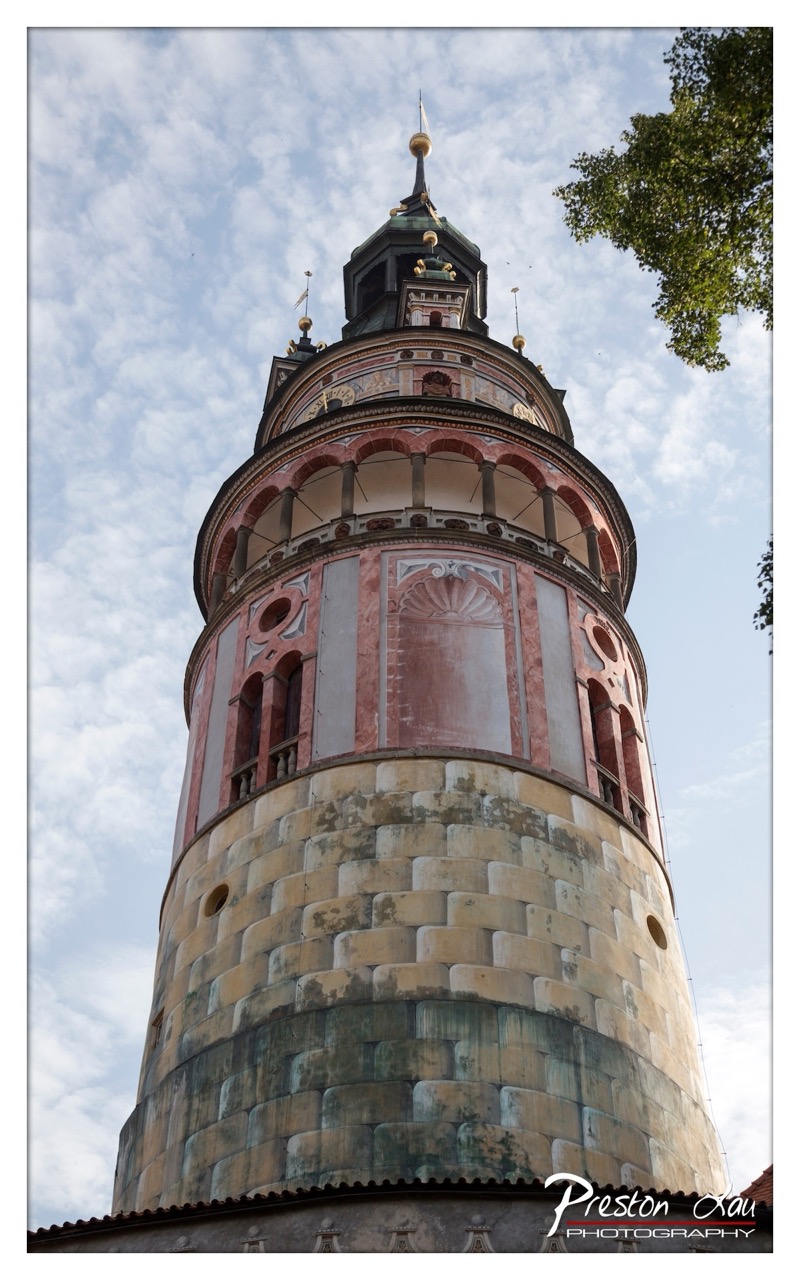

1. Overall Rating (0–10) — 8.0
This photograph captures the grandeur of a historic tower with a dramatic low-angle perspective that emphasizes its verticality and architectural complexity. The interplay of weathered stonework and ornate upper levels conveys a sense of time and craftsmanship, while the soft, scattered clouds add a subtle dynamism to the sky. The composition is strong, though a slightly tighter crop might enhance focus on the tower’s intricate details.
2. Composition (0–10) — 8.5
The low-angle shot creates a powerful sense of scale, drawing the eye upward along the tower’s form. The inclusion of the tree branch on the right adds a natural frame and balances the composition, though the left side feels slightly more open than the right.
3. Lighting (0–10) — 7.5
Natural daylight illuminates the tower evenly, highlighting texture and depth without harsh shadows. The soft light enhances the aged patina of the stone and the delicate colors of the upper structure, while the sky provides a luminous backdrop.
4. Color & Tone (0–10) — 7.0
The palette is composed of earthy tones—beige, ochre, and muted reds—contrasted against the pale blue sky and green foliage. The colors are harmonious but slightly desaturated, giving the image a subdued, timeless quality.
5. Creativity (0–10) — 8.0
The upward perspective and inclusion of natural elements like the tree branch demonstrate thoughtful composition. The choice to frame the tower against a textured sky adds narrative depth, suggesting both history and the passage of time.
6. Technical Quality (0–10) — 8.5
Sharp focus across the frame, clean detail in the stonework and architectural elements, and a well-managed exposure contribute to a technically strong image. The watermark is discreet and does not detract from the visual experience.
7. Emotional Impact (0–10) — 7.5
The image evokes a sense of awe and reverence for historical architecture, inviting contemplation of the past. The quiet dignity of the tower, set against the open sky, creates a meditative and slightly nostalgic mood.


1. Overall Rating (0–10) — 7.5
This photograph captures the majestic presence of a historic castle perched atop a rocky outcrop, with a solemn crucifix in the foreground creating a striking juxtaposition of faith and power. The low-angle perspective enhances the grandeur of the architecture and emphasizes the verticality of the scene. While the image is strong in composition and mood, the slightly overexposed sky and muted tones in the midground slightly detract from its visual impact.
2. Composition (0–10) — 8.0
The low-angle framing draws the eye upward toward the castle, while the crucifix in the foreground provides a strong anchor and adds narrative depth. The diagonal line of the hill guides the viewer’s gaze naturally through the image, creating a balanced and dynamic structure.
3. Lighting (0–10) — 6.5
The natural daylight is bright but diffused, softening shadows and allowing details in both the castle and the foreground to be visible. However, the sky is slightly overexposed, losing subtle cloud textures and reducing atmospheric depth.
4. Color & Tone (0–10) — 7.0
The palette features warm terracotta roofs and soft stone tones, complemented by the green of the trees and the pale blue sky. While the colors are harmonious, they lean slightly toward the cooler side, diminishing the warmth of the sunlit architecture.
5. Creativity (0–10) — 7.5
The inclusion of the crucifix introduces a powerful symbolic contrast—sacrifice and endurance against the backdrop of enduring historical power. This conceptual layer elevates the image beyond a mere architectural portrait, inviting contemplation.
6. Technical Quality (0–10) — 8.0
The image is sharp and well-focused, particularly on the crucifix and the castle facade. The depth of field is controlled effectively, with the foreground and background both retaining clarity, though the sky’s brightness slightly compromises exposure balance.
7. Emotional Impact (0–10) — 7.0
The photograph evokes a sense of reverence and timelessness, blending spiritual solemnity with historical grandeur. The viewer is drawn into a quiet reflection on legacy, faith, and the passage of time.
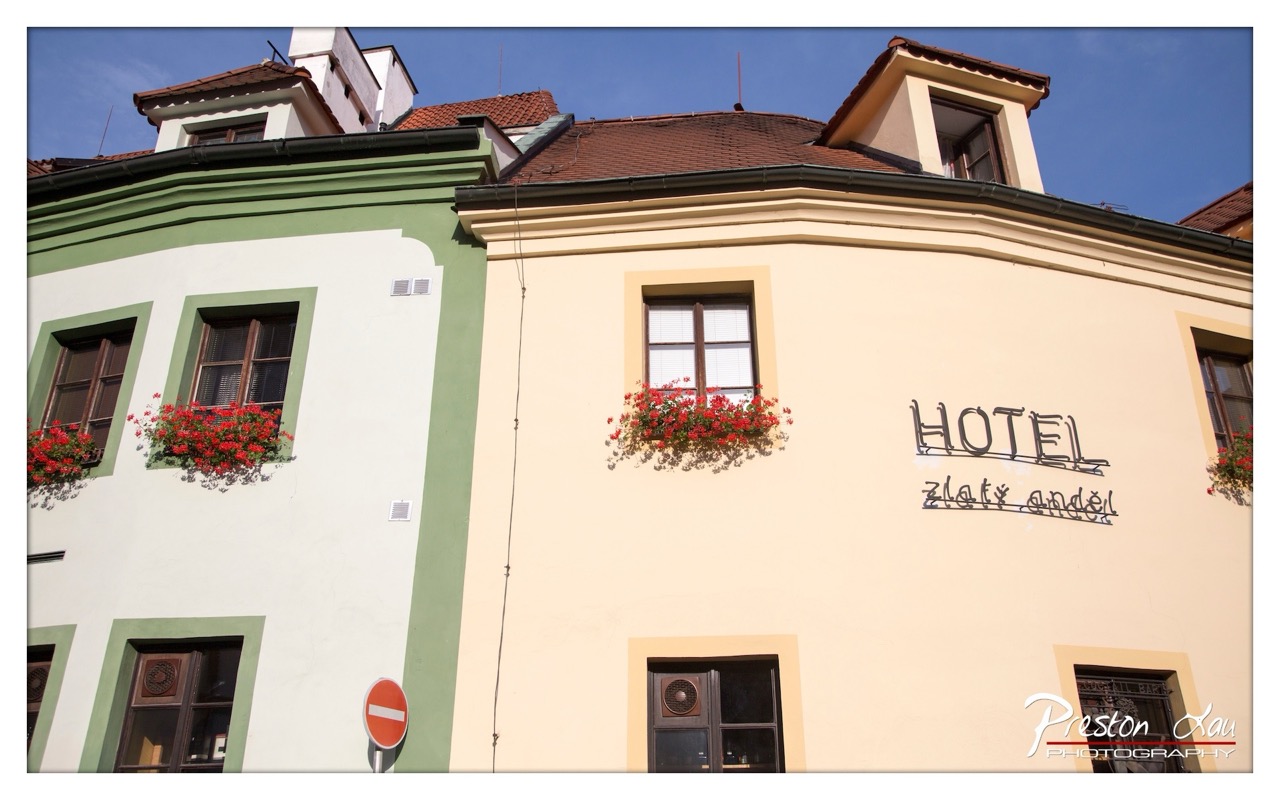

1. Overall Rating (0–10) — 7.0
This photograph captures the charm of a European street scene with a warm, inviting atmosphere, where architectural detail and vibrant color combine to evoke a sense of place. The bright red flowers and contrasting pastel facades create a visually engaging composition, though the low-angle perspective slightly distorts the building lines, lending a subtle imbalance. While the image celebrates everyday beauty, its narrative depth is limited by the lack of human presence or dynamic interaction.
2. Composition (0–10) — 6.5
The low-angle framing emphasizes the buildings' height and creates a sense of immersion, but the off-center alignment and asymmetrical placement of the "HOTEL" sign disrupt visual harmony. A more centered or balanced composition would enhance the image’s structural coherence.
3. Lighting (0–10) — 8.0
Bright, direct sunlight enhances the vividness of the colors and casts clean shadows that define the textures of the walls and roof. The clear blue sky provides a strong contrast, amplifying the warmth of the scene and reinforcing the sunny, cheerful mood.
4. Color & Tone (0–10) — 8.5
The palette is rich and harmonious, with the cream and sage green facades complemented by the bold red of the flowers and the deep blue sky. The tonal contrast between light and shadow adds depth, while the warm tones evoke a sense of nostalgia and comfort.
5. Creativity (0–10) — 7.0
The photographer captures a familiar scene with a fresh, vibrant eye, using color and perspective to elevate the mundane into something picturesque. The choice to include the handwritten hotel name adds a personal, human touch, suggesting a story behind the image.
6. Technical Quality (0–10) — 8.5
The image is sharp and well-exposed, with excellent clarity and detail in the textures of the walls, windows, and flower boxes. The watermark is subtly placed, not distracting from the composition.
7. Emotional Impact (0–10) — 7.5
The photograph evokes a sense of peaceful charm and quiet nostalgia, inviting the viewer to imagine strolling through a historic European town. The absence of people lends a tranquil, almost timeless quality, allowing the architecture and color to speak for themselves.
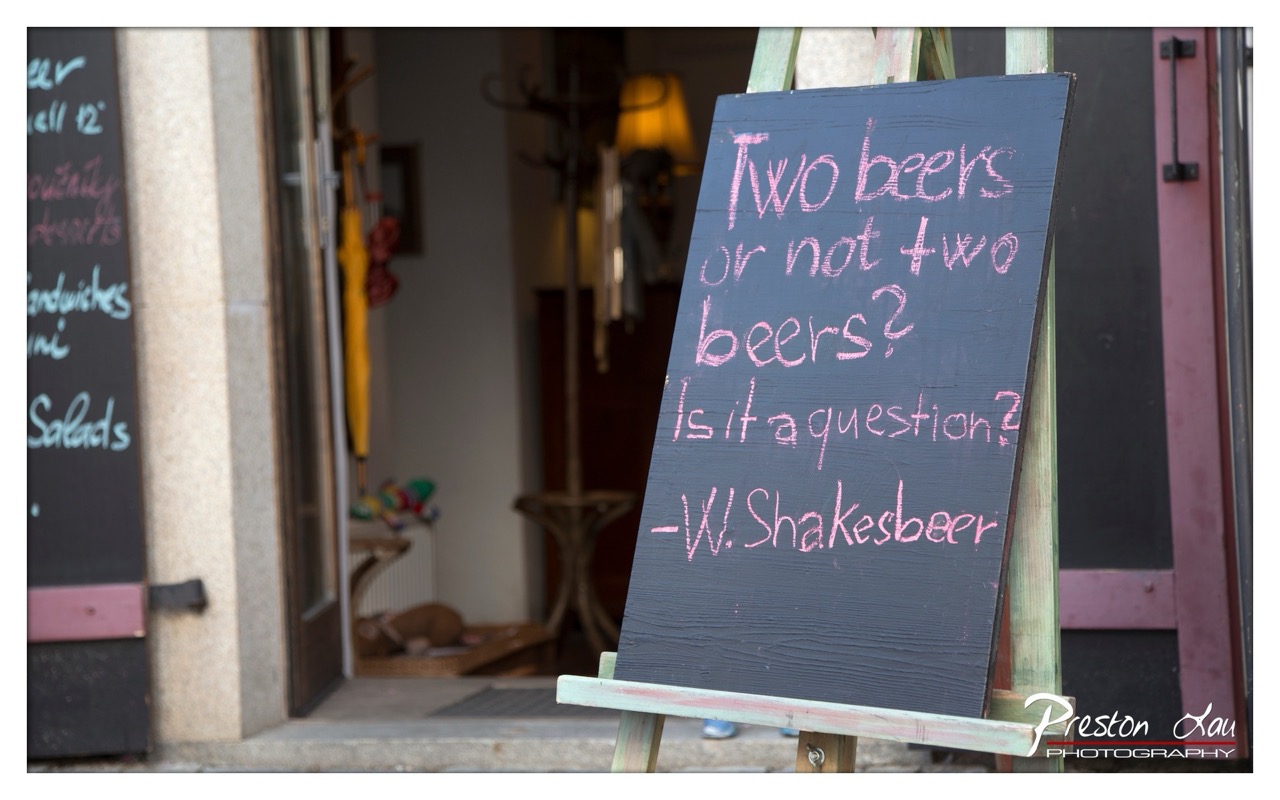

1. Overall Rating (0–10) — 7.0
This photograph captures a witty, thought-provoking moment with a clever twist on Shakespeare’s famous line, transforming a simple chalkboard sign into a philosophical joke. The humor is enhanced by the casual, unpolished handwriting and the rustic charm of the setting, which suggests a cozy, independent pub. While the image is visually engaging and conceptually strong, the slightly cluttered background and uneven lighting prevent it from feeling fully polished, though its authenticity and charm are compelling.
2. Composition (0–10) — 6.5
The sign is well-framed and slightly off-center, drawing the eye naturally while allowing context to inform the scene. The open doorway and secondary chalkboard on the left add depth, though the background clutter slightly distracts from the focal point.
3. Lighting (0–10) — 6.0
Natural daylight illuminates the sign clearly, but the interior remains dimly lit, creating a contrast that emphasizes the sign’s text. The soft, warm glow from inside adds a touch of intimacy, though the lighting is uneven and lacks dramatic control.
4. Color & Tone (0–10) — 6.5
The muted palette of gray, pink, and soft greens creates a subdued, organic feel that complements the casual setting. The pink chalk provides a gentle pop of color that draws attention to the text without overwhelming the scene.
5. Creativity (0–10) — 8.0
The image succeeds in blending humor, literature, and everyday life into a single, memorable frame. The play on words is original and thoughtfully presented, elevating a simple sign into a small piece of storytelling.
6. Technical Quality (0–10) — 7.5
The focus is sharp on the sign, with a shallow depth of field that blurs the background effectively. The image is clean and well-exposed, with no noticeable technical flaws.
7. Emotional Impact (0–10) — 7.0
The photograph evokes a sense of warmth, humor, and quiet wit. It invites the viewer to pause and reflect on the clever wordplay, creating a moment of amusement and connection with the scene.
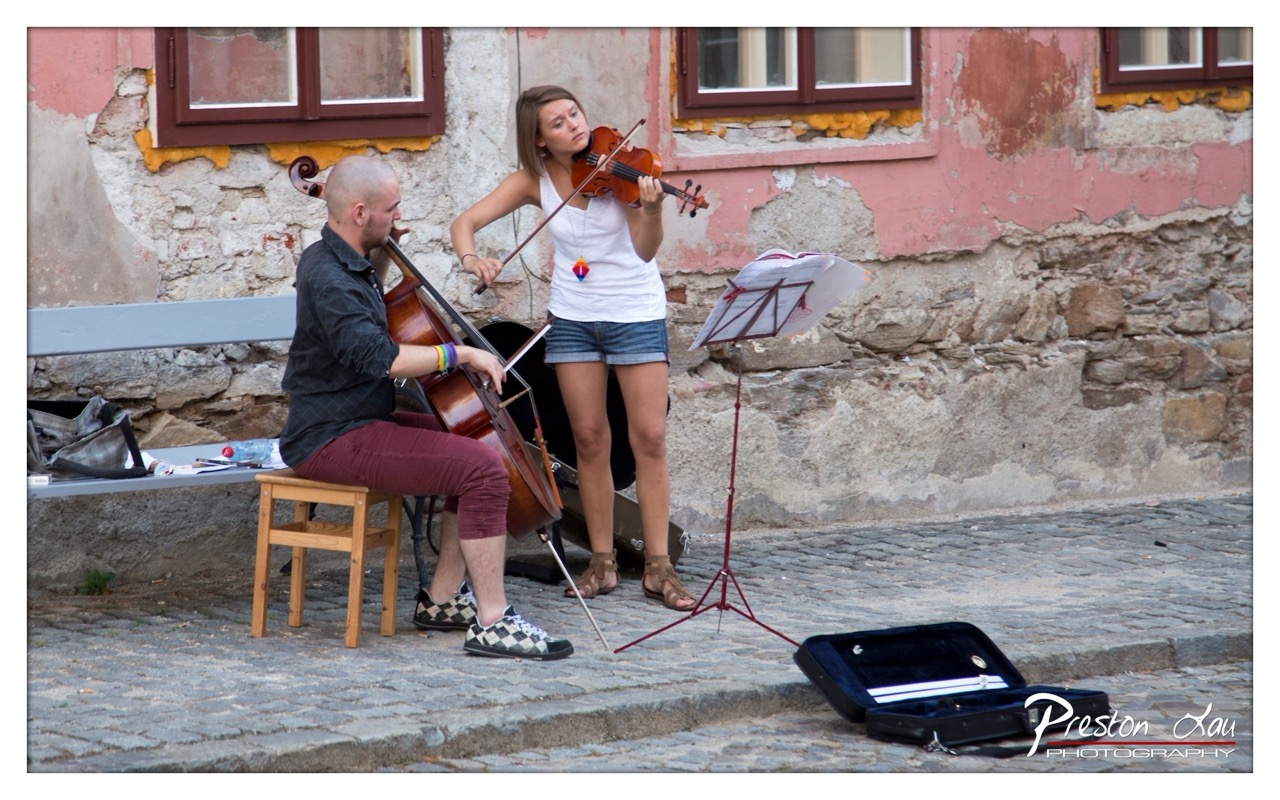

1. Overall Rating (0–10) — 7.0
This photograph captures a candid moment of street musicians performing in a weathered European alley, where the juxtaposition of art and decay creates a compelling narrative. The natural lighting and unposed expressions lend authenticity, while the aged stone wall and cobblestones enhance the scene’s rustic charm. While the composition is slightly unbalanced and the image could benefit from tighter framing, the emotional resonance of the performance and the authenticity of the setting elevate it beyond a simple snapshot.
2. Composition (0–10) — 6.0
The subjects are placed off-center, with the celloist slightly left and the violinist to the right, creating an asymmetrical balance. The music stand and open case draw the eye toward the bottom right, but the cluttered background and uneven framing weaken the visual flow.
3. Lighting (0–10) — 7.0
Natural daylight illuminates the scene evenly, highlighting the textures of the stone wall and the musicians’ expressions. The soft, diffused light avoids harsh shadows and enhances the candid mood.
4. Color & Tone (0–10) — 6.5
The palette features earthy tones—peeling pink, gray stone, and muted reds—contrasted with the white tank top and dark clothing. While the colors are natural and cohesive, they lack vibrancy, giving the image a slightly flat appearance.
5. Creativity (0–10) — 7.0
The image successfully captures a slice of street life with authenticity, blending music, architecture, and human expression. The contrast between the polished instruments and the crumbling backdrop adds narrative depth and visual interest.
6. Technical Quality (0–10) — 8.0
The focus is sharp on the musicians, with good detail in the instruments and facial expressions. The exposure is balanced, and the image is free from noticeable noise or distortion.
7. Emotional Impact (0–10) — 7.5
There is a quiet intimacy in the musicians’ concentration and the shared moment of performance, evoking a sense of dedication and connection. The setting enhances a feeling of timelessness and cultural authenticity, inviting the viewer to pause and listen.
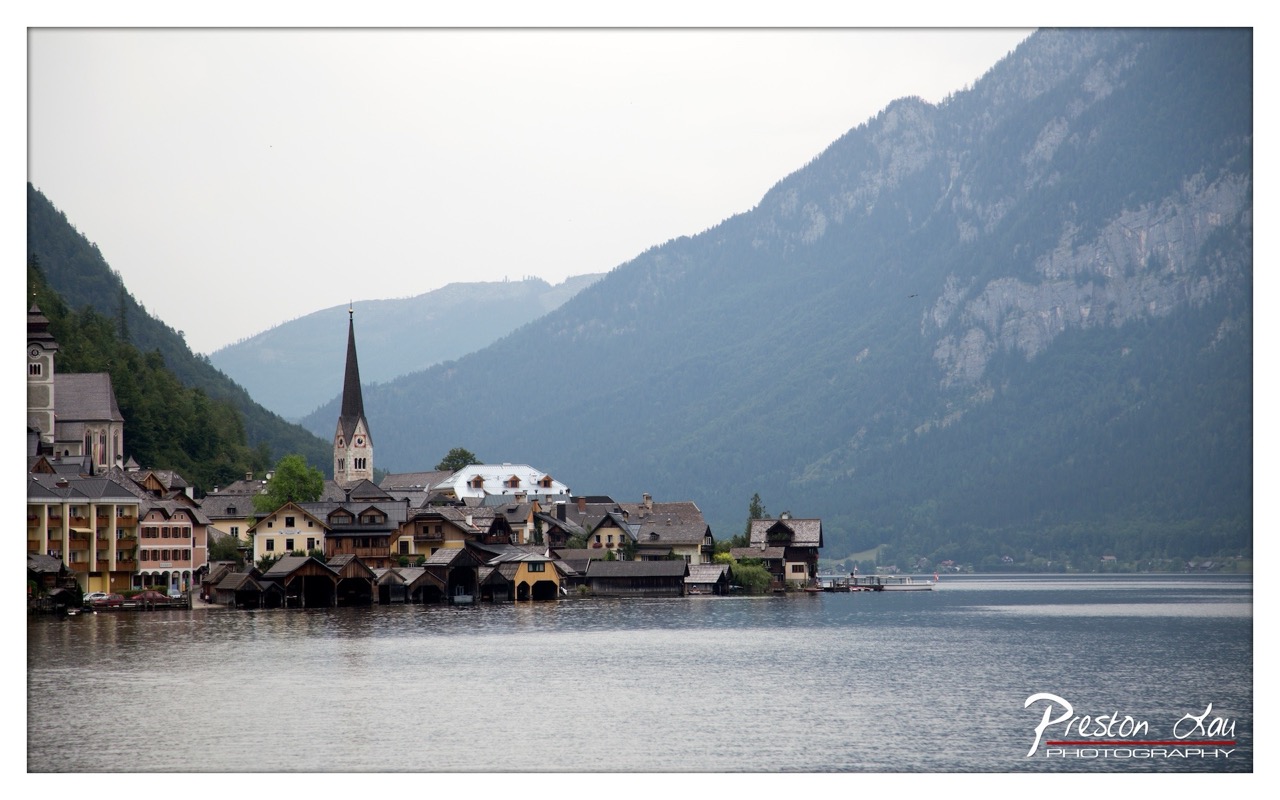

1. Overall Rating (0–10) — 7.0
This photograph captures the serene, timeless beauty of a lakeside alpine village, where architecture and nature merge in quiet harmony. The soft, overcast light lends a dreamy quality to the scene, enhancing its peaceful mood, though the slightly muted colors and flat lighting prevent it from feeling fully dynamic. The composition is strong, but the image’s emotional resonance is held back by a lack of visual contrast and a somewhat generic feel despite its picturesque subject.
2. Composition (0–10) — 7.5
The village is anchored by the church spire, which draws the eye upward and creates a natural focal point. The layered arrangement of buildings along the shore, the water in the foreground, and the mountains in the background provide depth and balance. The wide framing captures the full scope of the landscape, though the left edge feels slightly crowded.
3. Lighting (0–10) — 6.0
The diffuse, overcast lighting creates an even exposure across the scene, minimizing harsh shadows and preserving detail in both the sky and the mountains. While this soft light suits the contemplative mood, it also flattens textures and reduces the visual drama, giving the image a muted, almost melancholic tone.
4. Color & Tone (0–10) — 6.5
The palette is dominated by cool grays and soft greens, with subtle earth tones in the buildings providing gentle contrast. The overall tone is subdued, which works well for the atmospheric mood but limits vibrancy. A touch of warmth in the highlights or deeper saturation in the shadows could have added visual richness.
5. Creativity (0–10) — 7.0
The photographer has chosen a classic, well-known landscape and presented it with a respectful, observational approach. The image is not particularly experimental, but its strength lies in capturing the essence of the location with clarity and quiet elegance.
6. Technical Quality (0–10) — 8.0
The image is sharp and well-focused, with clean details visible in the buildings and water. The exposure is well-managed, with no blown-out highlights or lost shadows. The watermark is professionally placed and does not distract.
7. Emotional Impact (0–10) — 7.5
The photograph evokes a sense of calm and solitude, inviting the viewer to imagine life in this tranquil mountain village. The misty atmosphere and quiet water enhance the feeling of peaceful isolation, making the image emotionally resonant despite its lack of dramatic flair.
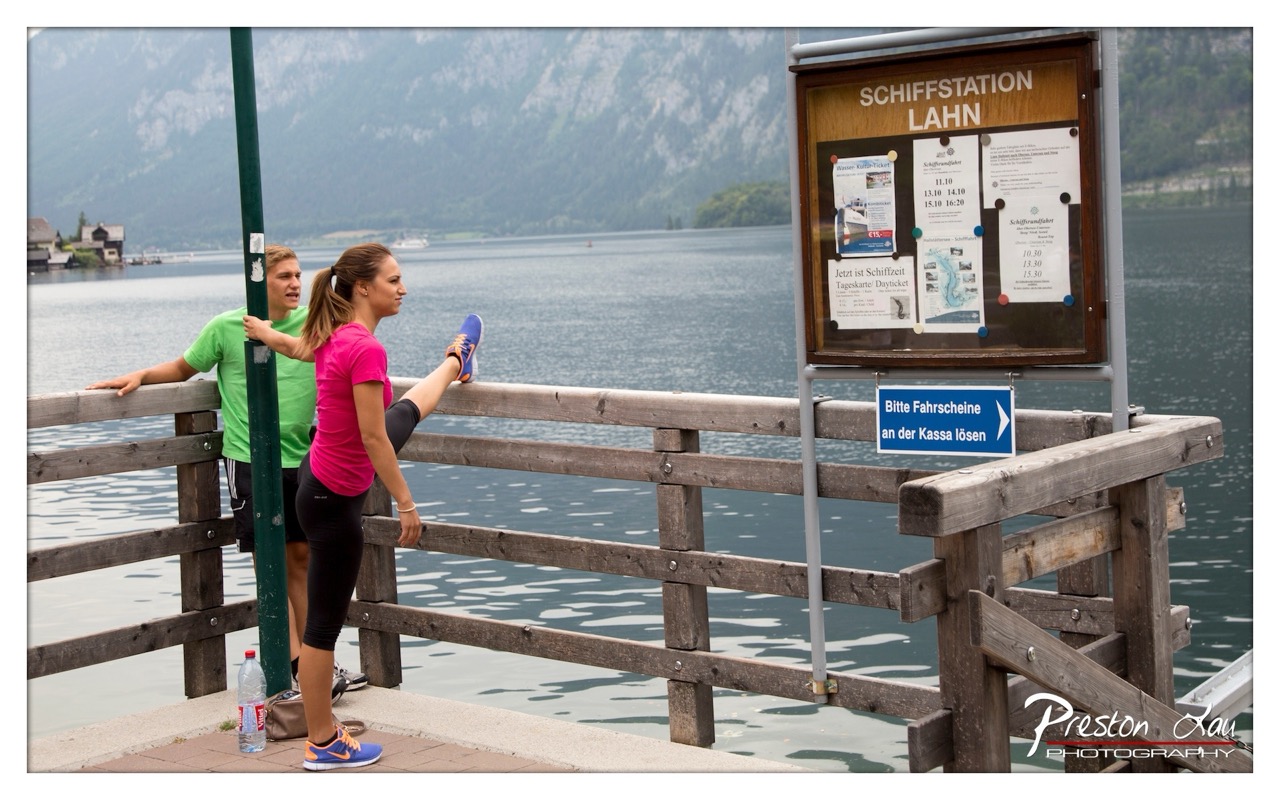

1. Overall Rating (0–10) — 7.0
This photograph captures a serene moment of preparation and anticipation at a lakeside ferry station, where human activity harmonizes with the grandeur of nature. The woman stretching in the foreground adds a dynamic, relatable element, while the misty mountains and calm waters evoke a sense of tranquility and adventure. Though the composition is slightly cluttered by signage, the image succeeds in conveying both place and mood with quiet authenticity.
2. Composition (0–10) — 6.5
The subjects are well-placed, with the woman in the foreground drawing immediate attention, while the man and distant landscape provide depth. The wooden railing and signpost create strong leading lines, but the clutter of information on the bulletin board slightly disrupts visual flow.
3. Lighting (0–10) — 6.0
Soft, diffused light suggests an overcast day, which evenly illuminates the scene and enhances the cool, tranquil mood. While the lighting is natural and appropriate for the setting, it lacks dramatic contrast or warmth, resulting in a somewhat flat appearance.
4. Color & Tone (0–10) — 6.5
The palette is dominated by cool blues and greens, reflecting the lake and mountains, while the woman’s bright pink shirt provides a striking focal point. The overall tone is cohesive but restrained, with a slight cool cast that enhances the quiet atmosphere.
5. Creativity (0–10) — 7.0
The image blends documentary realism with subtle storytelling—capturing a fleeting moment of travel and anticipation. The juxtaposition of everyday activity against a majestic landscape gives the photo a quiet narrative depth, making it more than just a snapshot.
6. Technical Quality (0–10) — 7.5
The image is sharp and well-focused, with clear details in both the foreground subjects and the distant mountains. The exposure is balanced, and the depth of field appropriately highlights the main subject while retaining background context.
7. Emotional Impact (0–10) — 7.0
There’s a quiet sense of wanderlust and calm introspection that resonates with viewers, evoking the feeling of standing at the edge of a journey. The human element, paired with the vast natural setting, creates a moment of connection between person and place.
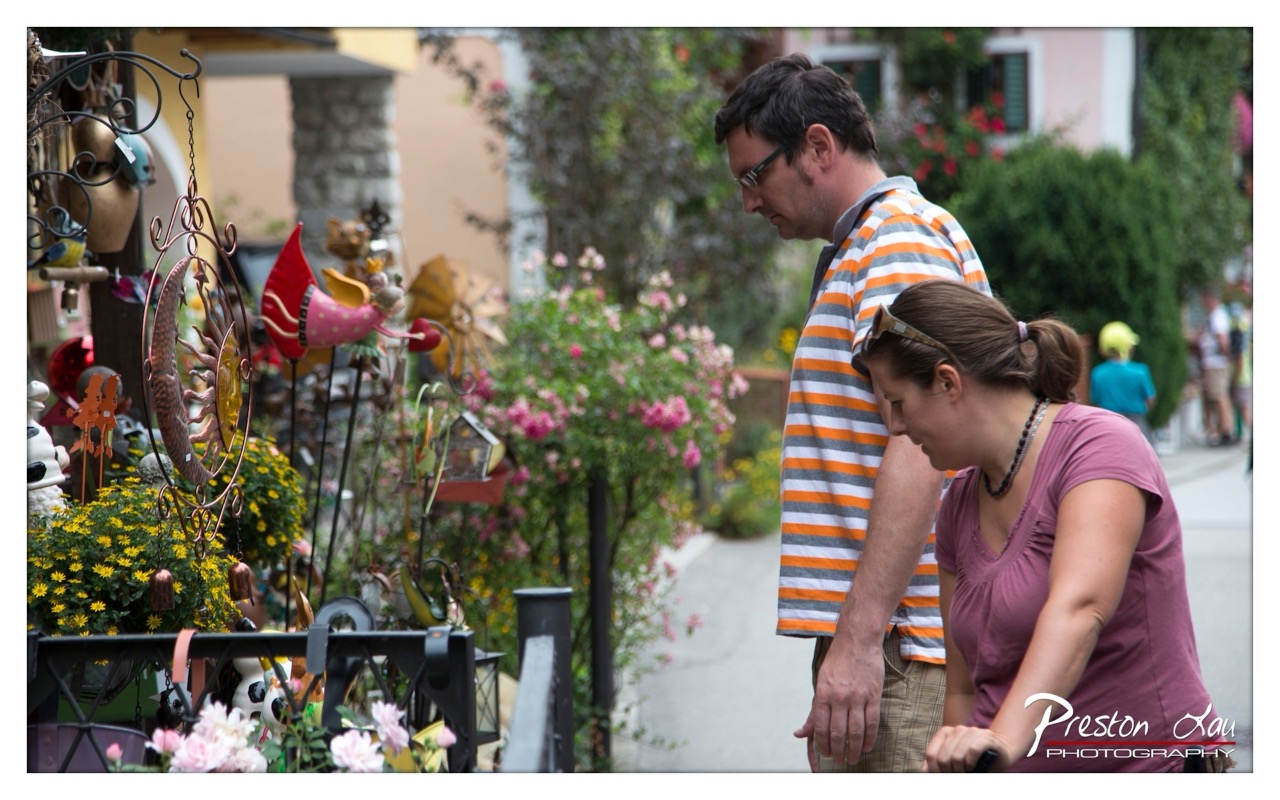

1. Overall Rating (0–10) — 7.0
This photograph captures a candid moment of quiet engagement between a man and a woman browsing a vibrant outdoor market stall, where whimsical garden ornaments and blooming flowers create a rich, textured backdrop. The scene feels authentic and immersive, with the couple’s focused attention drawing the viewer into their shared experience. While the image is visually compelling, the slightly cluttered composition and flat lighting prevent it from achieving a more refined aesthetic balance.
2. Composition (0–10) — 6.5
The subjects are positioned slightly off-center, creating a natural, documentary feel, but the left side is dominated by a dense arrangement of objects that compete for attention. A tighter crop would improve visual flow and emphasize the interaction.
3. Lighting (0–10) — 6.0
Natural daylight provides even illumination, but the lack of directional shadows and contrast gives the scene a flat, slightly overexposed quality, particularly in the background.
4. Color & Tone (0–10) — 7.0
The palette is lively and warm, with rich pinks, yellows, and earth tones that complement the garden setting. However, the colors feel slightly muted and lack depth due to the lighting.
5. Creativity (0–10) — 7.0
The image successfully captures a slice-of-life moment with a sense of narrative and charm. The juxtaposition of the couple’s quiet focus against the colorful chaos of the stall adds subtle storytelling depth.
6. Technical Quality (0–10) — 7.5
The focus is sharp on the subjects, and the detail in the foreground objects is clear. The overall clarity is strong, though slight overexposure in the background detracts from the image’s refinement.
7. Emotional Impact (0–10) — 7.5
There is a warm, intimate quality to the scene—two people sharing a quiet moment of discovery—that resonates with the viewer. The authenticity of the interaction invites empathy and a sense of shared experience.
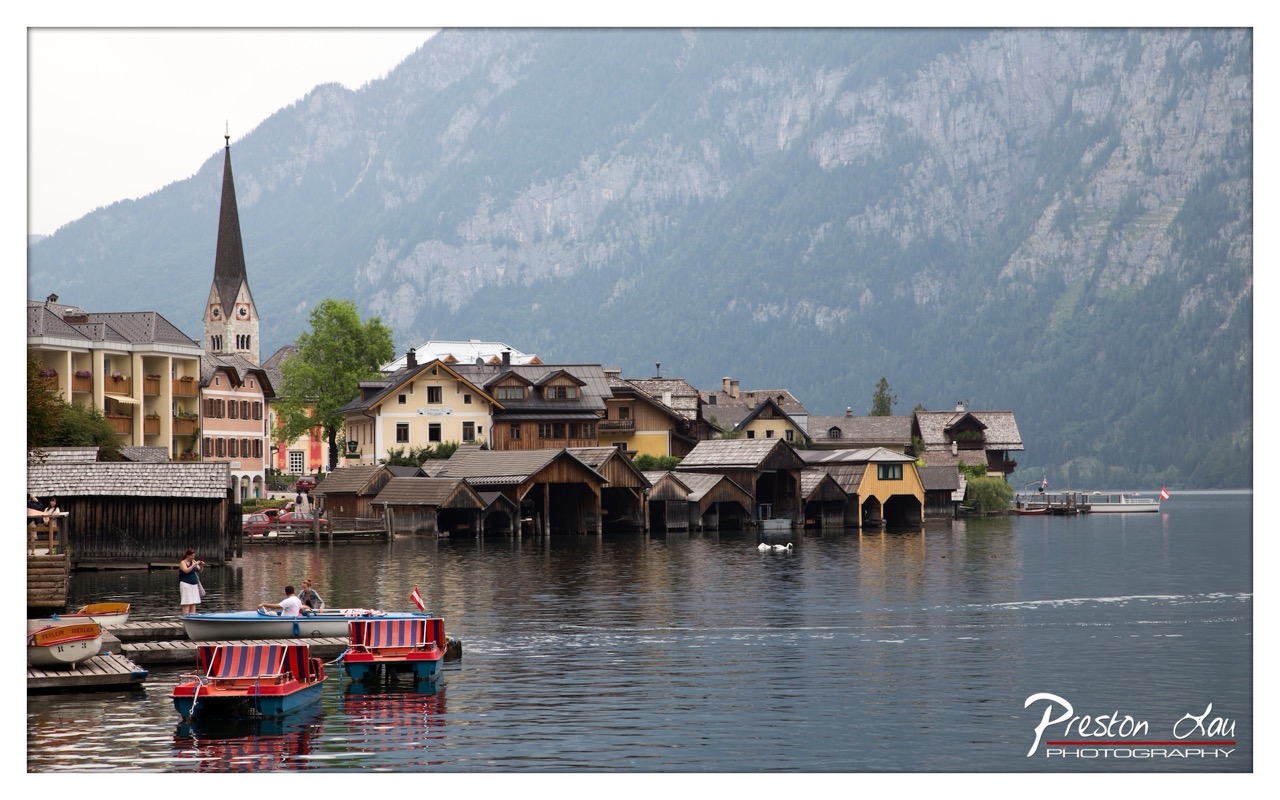

1. Overall Rating (0–10) — 7.5
This photograph captures the serene charm of a lakeside Alpine village, where tradition and nature coexist in quiet harmony. The composition draws the eye from the colorful boats in the foreground to the church spire and towering mountains beyond, creating a layered sense of place. While the overcast sky softens the scene’s vibrancy, the image succeeds in conveying the calm and timelessness of Hallstatt, with its wooden boathouses and misty backdrop offering a poetic stillness.
2. Composition (0–10) — 8.0
The framing balances foreground activity with background grandeur, using the boats and docks as leading lines toward the village and mountains. The church steeple serves as a natural focal point, anchoring the composition and guiding the viewer’s gaze upward.
3. Lighting (0–10) — 6.0
Diffused, overcast light creates a soft, even illumination that minimizes harsh shadows, enhancing the tranquil mood. However, the lack of direct sunlight reduces contrast and depth, giving the image a slightly muted quality.
4. Color & Tone (0–10) — 6.5
The palette is dominated by earthy browns, muted greens, and soft grays, which harmonize well with the natural setting. The red and blue of the boats provide subtle pops of color that draw attention without disrupting the scene’s peaceful tone.
5. Creativity (0–10) — 7.0
The photographer captures a familiar view with a sense of reverence and balance, emphasizing the relationship between architecture and landscape. The use of reflection and depth adds visual interest, though the scene is more documentary than experimental.
6. Technical Quality (0–10) — 8.0
Sharp focus across the frame, clean detail in the buildings and water, and a well-managed exposure contribute to a technically sound image. The watermark is unobtrusive and professionally placed.
7. Emotional Impact (0–10) — 7.5
The image evokes a sense of peace and nostalgia, inviting the viewer to imagine life in this picturesque village. The quiet presence of people and the stillness of the water foster a contemplative mood, making the scene feel both timeless and deeply personal.
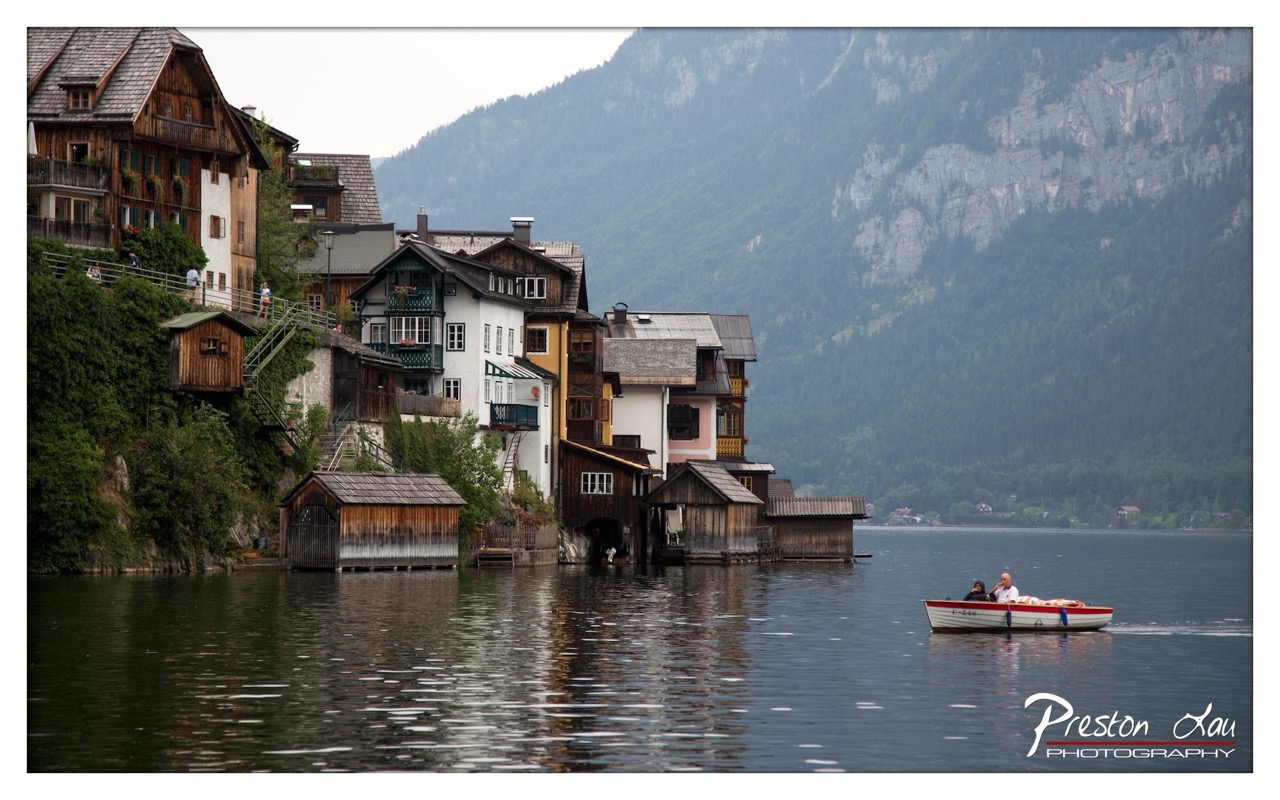

1. Overall Rating (0–10) — 7.5
This photograph captures the serene charm of a lakeside village nestled against a misty mountain backdrop, evoking a timeless, almost postcard-perfect alpine tranquility. The composition draws the eye from the rustic wooden houses on the left to the small boat gliding across the water, creating a narrative of quiet daily life. While the muted lighting and soft focus lend a dreamlike quality, the image could benefit from more contrast and vibrancy to fully convey the majesty of the setting.
2. Composition (0–10) — 7.0
The frame balances the verticality of the buildings with the horizontal sweep of the lake and mountains, creating a harmonious structure. The boat in the lower right provides a natural focal point, guiding the viewer’s gaze through the scene. However, the left side feels slightly crowded, and a tighter crop might enhance visual clarity.
3. Lighting (0–10) — 6.5
Soft, diffused light from an overcast sky creates even illumination, minimizing harsh shadows and lending a calm, contemplative mood. While the lighting is appropriate for the atmosphere, it also flattens the image slightly, reducing the sense of depth in the mountains and water.
4. Color & Tone (0–10) — 6.0
The palette is subdued, dominated by earthy browns, muted greens, and soft grays, which complement the tranquil mood. However, the colors lack richness and saturation, giving the image a slightly washed-out appearance that diminishes its visual impact.
5. Creativity (0–10) — 7.0
The photographer captures a classic landscape with a thoughtful eye for storytelling, using the boat and village as a narrative device. The choice to include the distant figures adds a human element, grounding the scene in reality while maintaining its picturesque quality.
6. Technical Quality (0–10) — 8.0
The image is sharp and well-focused, with clean detail in the buildings and reflections on the water. The exposure is balanced, with no blown highlights or lost shadows, indicating strong technical control.
7. Emotional Impact (0–10) — 7.5
The photograph evokes a sense of peace and nostalgia, inviting the viewer to imagine life in this quiet corner of the Alps. The combination of natural beauty and human presence creates a gentle emotional resonance, though the muted tones slightly temper its emotional punch.
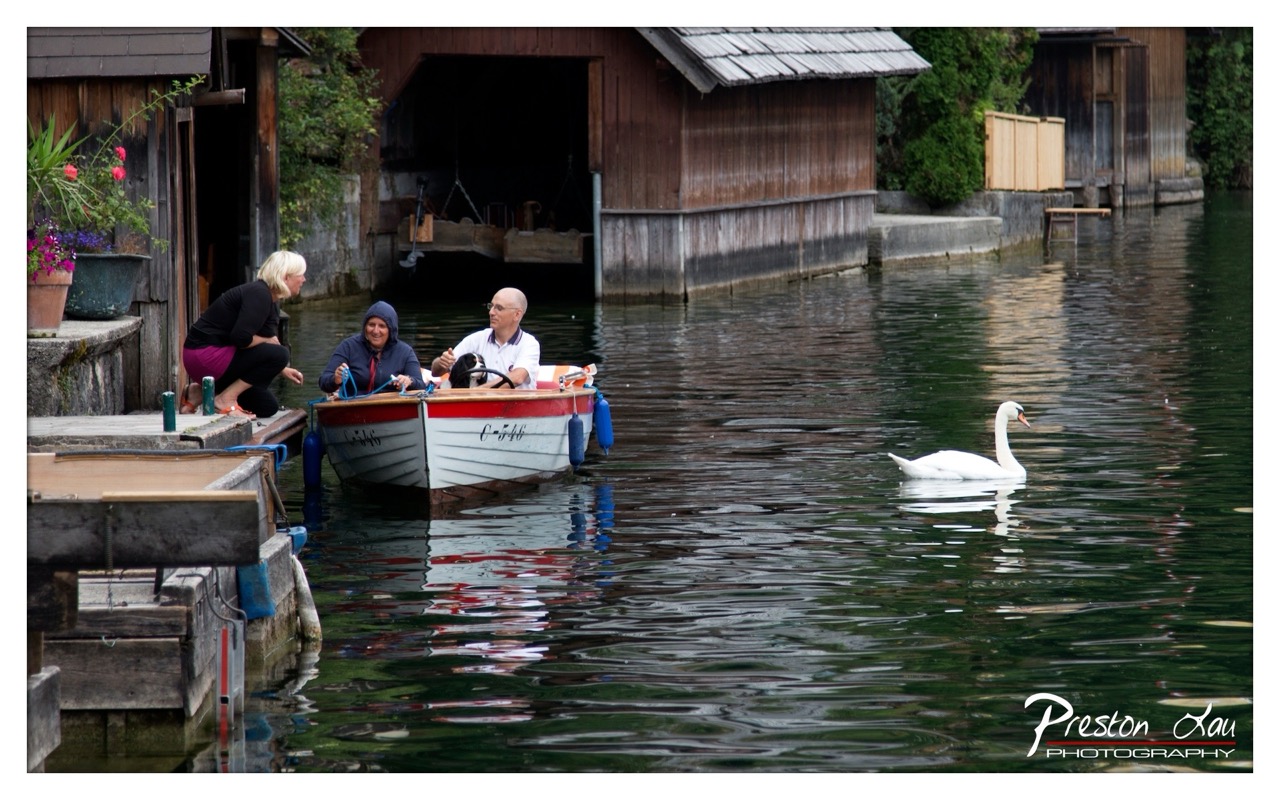

1. Overall Rating (0–10) — 7.0
This photograph captures a serene, slice-of-life moment on a quiet waterway, where human activity and nature coexist in gentle harmony. The interaction between the people in the boat and the woman on the dock conveys a sense of community and ease, while the swan adds a touch of grace and stillness. The image is grounded in authenticity, though it lacks a compelling focal tension to elevate it beyond a pleasant snapshot.
2. Composition (0–10) — 6.5
The framing centers the boat and its occupants, creating a natural focal point, while the swan balances the right side of the image. The foreground dock elements add depth, but the cluttered left edge slightly disrupts the visual flow, pulling attention away from the main subjects.
3. Lighting (0–10) — 6.0
Soft, diffused light suggests an overcast day, which evenly illuminates the scene but flattens shadows and reduces dimension. The reflections on the water add subtle texture, but the lack of strong directional light limits the image’s dramatic impact.
4. Color & Tone (0–10) — 6.5
The palette is restrained, with muted earth tones in the wooden structures and a cool green-blue in the water, contrasted by the bright white of the swan and the pop of color from the flowers. While harmonious, the colors lack vibrancy, giving the scene a subdued, almost documentary feel.
5. Creativity (0–10) — 6.0
The composition captures a quiet, authentic moment with narrative potential, but it relies heavily on the inherent charm of the scene rather than intentional artistic manipulation. The swan’s inclusion adds poetic contrast, but the overall approach is observational rather than expressive.
6. Technical Quality (0–10) — 7.5
The image is sharp and well-focused, with clean details in the boat, faces, and reflections. The depth of field is appropriate, keeping the main subjects clear while softly blurring the background. The watermark is unobtrusive and professionally placed.
7. Emotional Impact (0–10) — 6.5
The photograph evokes a sense of calm and quiet companionship, with the gentle interaction and the swan’s presence lending a peaceful, almost meditative quality. While it invites reflection, it doesn’t strongly stir emotion—its power lies in its quiet authenticity rather than its emotional resonance.
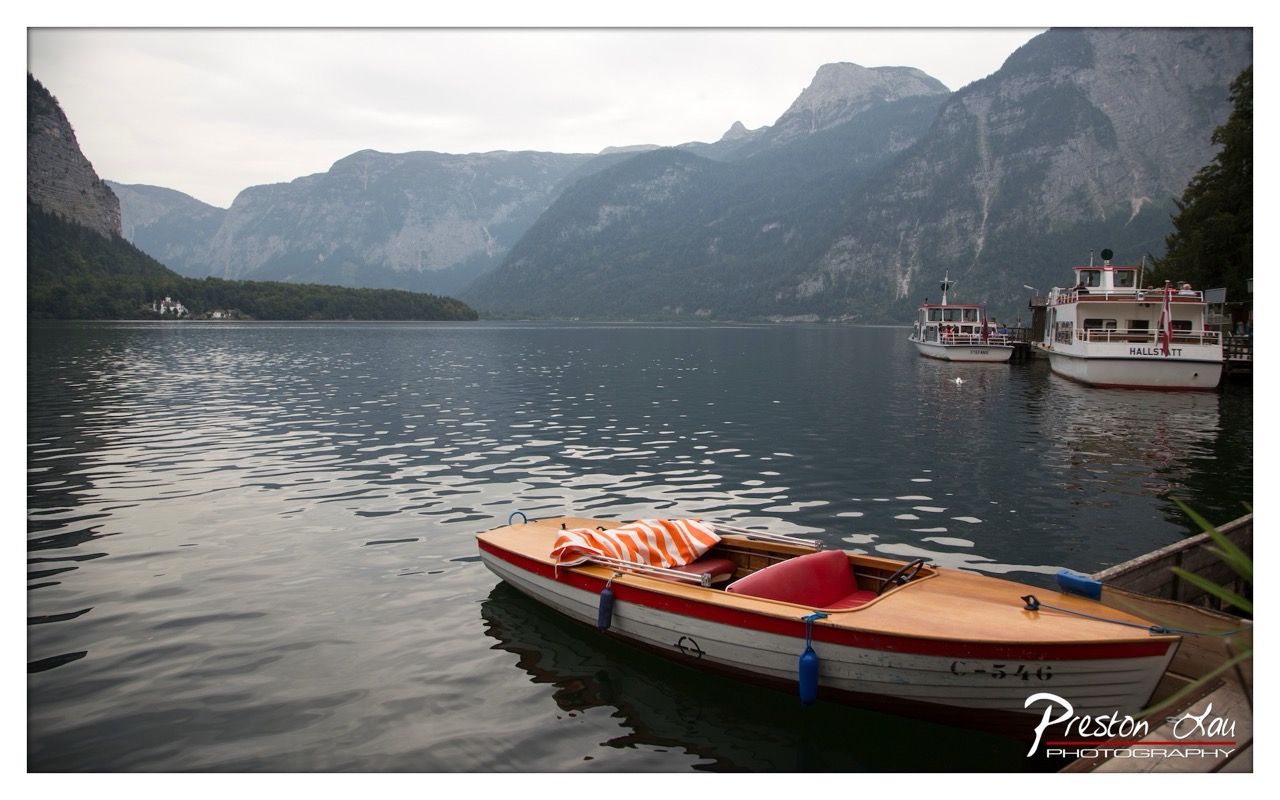

1. Overall Rating (0–10) — 7.5
This photograph captures the serene grandeur of a mountain lake, where the quiet presence of a small rowboat contrasts with the imposing scale of the surrounding peaks. The muted sky and reflective water create a contemplative mood, while the vibrant orange-and-white stripe on the boat provides a subtle pop of color that draws the eye. Though the scene is visually rich, the lack of strong light and dramatic contrast keeps it from feeling fully immersive, holding it just short of transcendent.
2. Composition (0–10) — 7.0
The boat in the foreground anchors the image, leading the viewer’s eye toward the distant shore and towering mountains. The diagonal placement of the rowboat creates a sense of movement, while the two larger vessels in the midground add depth and context. The framing is balanced, though the composition feels slightly weighted toward the right, creating a subtle imbalance.
3. Lighting (0–10) — 5.5
The overcast sky casts a soft, diffused light across the scene, minimizing harsh shadows and creating a muted, atmospheric quality. While this contributes to the calm mood, it also flattens the image’s depth and reduces the visual drama of the mountains and water.
4. Color & Tone (0–10) — 6.5
The palette is dominated by cool grays and blues, with the warm wood tones of the boat and the bold orange-and-white stripe offering gentle contrast. The colors are well-balanced but restrained, reflecting the subdued lighting and contributing to the image’s contemplative tone.
5. Creativity (0–10) — 7.0
The photograph captures a classic landscape moment with a thoughtful approach, using the small boat as a narrative device to evoke scale and solitude. The inclusion of the "HALLSTATT" signage grounds the image in a specific place, adding a subtle layer of storytelling.
6. Technical Quality (0–10) — 8.0
The image is sharp and clear, with fine detail visible in the boat’s surface and the water’s texture. The focus is well-placed on the foreground, and the exposure is balanced, preserving detail in both the highlights and shadows.
7. Emotional Impact (0–10) — 7.0
There is a quiet, meditative quality to the scene that invites reflection. The stillness of the water and the vastness of the mountains evoke a sense of peace and solitude, making the viewer feel both small and connected to the landscape.
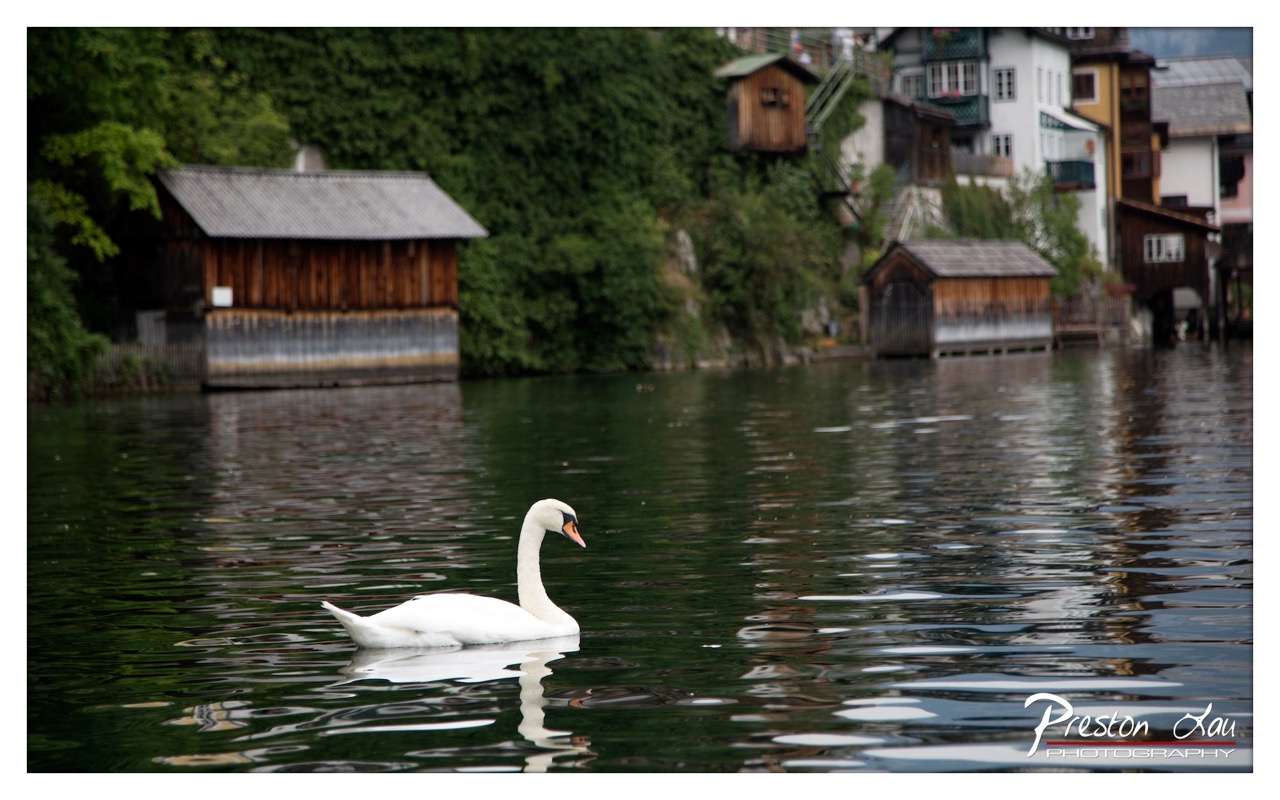

1. Overall Rating (0–10) — 7.5
This photograph captures a serene moment of a swan gliding across a calm lake, framed by the picturesque charm of a lakeside village. The contrast between the white swan and the dark, reflective water creates a striking focal point, while the blurred background of wooden boathouses and lush greenery adds depth and context. While the image successfully conveys tranquility, the slightly muted color palette and soft focus on the background slightly limit its visual impact.
2. Composition (0–10) — 7.0
The swan is positioned off-center, following the rule of thirds, which creates a balanced and natural feel. The layered background, with its boathouses and foliage, adds depth, though the composition is slightly dominated by the left-side structure, drawing attention away from the swan’s graceful movement.
3. Lighting (0–10) — 6.5
The soft, diffused light suggests an overcast day, which minimizes harsh shadows and creates a calm, even exposure. While this contributes to the peaceful mood, it also results in a lack of dynamic contrast and subtle detail in the shadows.
4. Color & Tone (0–10) — 6.0
The dominant greens and dark water create a moody, natural palette, with the white swan providing a strong contrast. However, the colors appear somewhat desaturated, giving the image a slightly flat appearance that dampens the vibrancy of the scene.
5. Creativity (0–10) — 7.0
The photographer captures a timeless, almost postcard-like moment, blending wildlife and architecture in a harmonious setting. The choice to emphasize the swan as the primary subject within a richly textured environment shows thoughtful intent and a narrative quality.
6. Technical Quality (0–10) — 7.5
The image is sharp on the swan, with clean focus and minimal noise. The depth of field effectively isolates the subject, and the water’s gentle ripples add texture and realism.
7. Emotional Impact (0–10) — 7.5
The image evokes a sense of peace and quiet contemplation, inviting the viewer to pause and reflect on the beauty of a simple, natural moment. The swan’s solitary glide across the water enhances the feeling of serenity and timelessness.


1. Overall Rating (0–10) — 7.5
This photograph captures the timeless charm of a lakeside Alpine village, where tradition and nature coexist in harmonious balance. The composition draws the eye upward through the cluster of wooden and whitewashed houses nestled against a lush green hillside, evoking a sense of peaceful permanence. While the image is rich in detail and atmosphere, the slightly overcast lighting tempers its visual drama, preventing it from fully transcending the realm of a beautiful snapshot into a truly striking work of art.
2. Composition (0–10) — 8.0
The arrangement of houses cascading down the slope creates a strong diagonal flow, guiding the viewer’s gaze from the foreground waterline to the upper village. The inclusion of the church steeple adds vertical emphasis and anchors the scene, while the calm water in the foreground provides a natural frame and reflective balance.
3. Lighting (0–10) — 6.0
The soft, diffused light from the overcast sky evenly illuminates the scene, minimizing harsh shadows and preserving detail in both highlights and shadows. While this creates a gentle, tranquil mood, it also reduces contrast and depth, lending the image a somewhat flat appearance.
4. Color & Tone (0–10) — 7.0
The palette is dominated by natural greens and earthy browns, with the white facades and dark wood accents creating a pleasing contrast. The muted tones reflect the subdued lighting, but the presence of colorful flower boxes adds subtle pops of life and warmth.
5. Creativity (0–10) — 7.0
The photographer captures a classic, picturesque subject with a clear sense of place and cultural identity. The image succeeds in storytelling through its composition and detail, though it follows a well-trodden visual path rather than offering a radically fresh perspective.
6. Technical Quality (0–10) — 8.0
The image is sharp and well-focused, with fine detail visible in the textures of the wood and stone. The exposure is balanced, and the overall clarity is strong, suggesting a high level of technical proficiency.
7. Emotional Impact (0–10) — 7.5
The scene evokes a deep sense of nostalgia and serenity, inviting the viewer to imagine a life of quiet rhythms and close-knit community. The stillness of the water and the timeless architecture combine to create a moment of quiet contemplation that resonates emotionally.
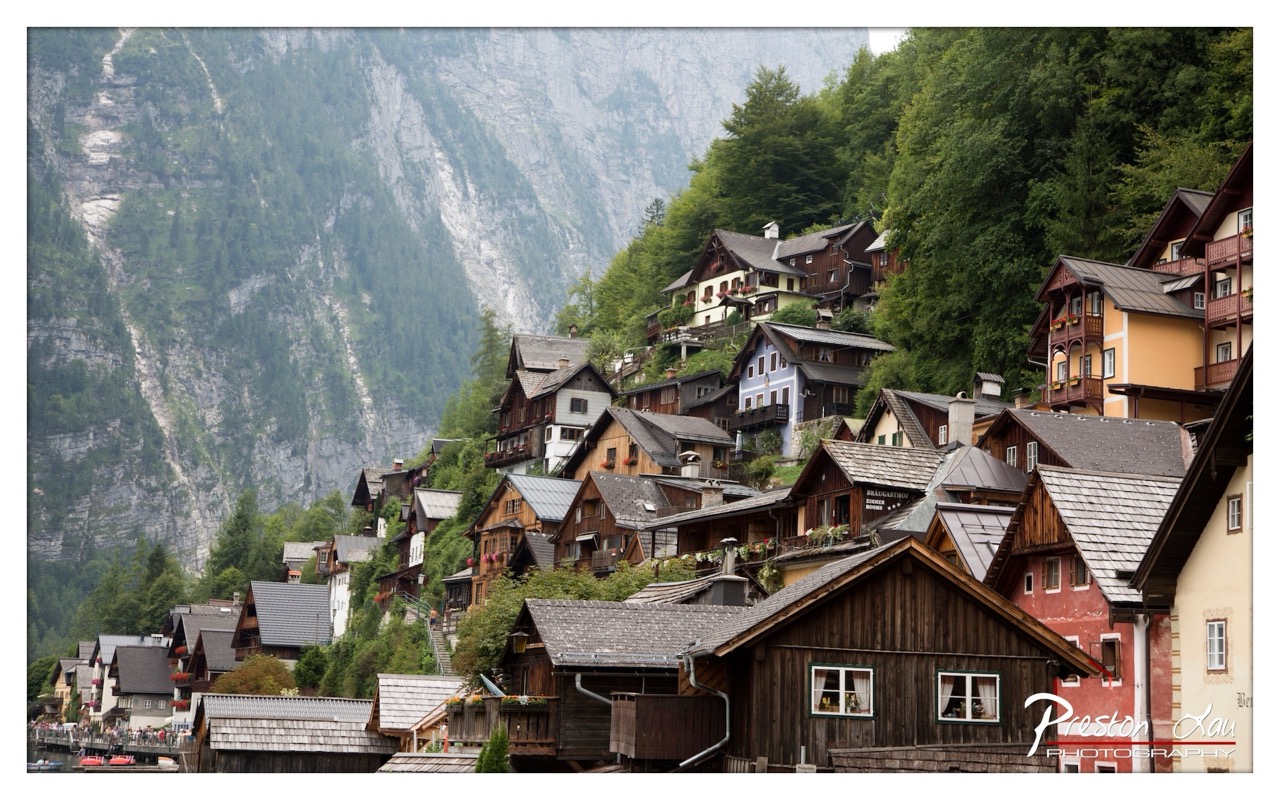

1. Overall Rating (0–10) — 8.0
This photograph captures the timeless charm of a mountain village clinging to a lush, forested slope, where rustic wooden homes cascade down toward a misty valley. The composition masterfully balances the organic sprawl of the settlement with the imposing presence of the towering cliff, creating a sense of harmony between human habitation and nature. While the image is rich in detail and atmosphere, a slightly more dynamic lighting moment or subtle tonal refinement could elevate its emotional resonance.
2. Composition (0–10) — 8.5
The diagonal flow of the village buildings guides the eye naturally from the foreground to the background, creating depth and movement. The framing effectively includes the full scope of the landscape, while the juxtaposition of the dense cluster of homes against the vast mountain face provides strong visual contrast and balance.
3. Lighting (0–10) — 7.0
Soft, diffused light from an overcast sky evenly illuminates the scene, minimizing harsh shadows and allowing rich textures in the wood and stone to emerge. While the lighting is natural and appropriate for the mood, it lacks the dramatic interplay of light and shadow that could add more dimension and drama.
4. Color & Tone (0–10) — 7.5
The palette is grounded in earthy browns, greens, and grays, creating a cohesive and naturalistic tone. The subtle pops of color from flower boxes and painted facades add warmth and life without disrupting the tranquil atmosphere. A slight increase in vibrancy could enhance the visual appeal without compromising authenticity.
5. Creativity (0–10) — 7.5
The photograph captures a well-known subject with a strong sense of place, but its creativity lies in the subtle storytelling of human adaptation to a challenging environment. The framing and perspective offer a fresh take on a classic scene, emphasizing the interplay between architecture and landscape.
6. Technical Quality (0–10) — 8.5
Sharp focus across the frame, accurate exposure, and clean detail throughout the image reflect strong technical execution. The depth of field is well-managed, allowing both foreground and background elements to remain clear and engaging.
7. Emotional Impact (0–10) — 8.0
The image evokes a sense of peace, timelessness, and quiet resilience. The viewer is drawn into a world where life unfolds slowly, nestled between the grandeur of the mountains and the warmth of the village, inspiring a deep appreciation for simplicity and natural beauty.
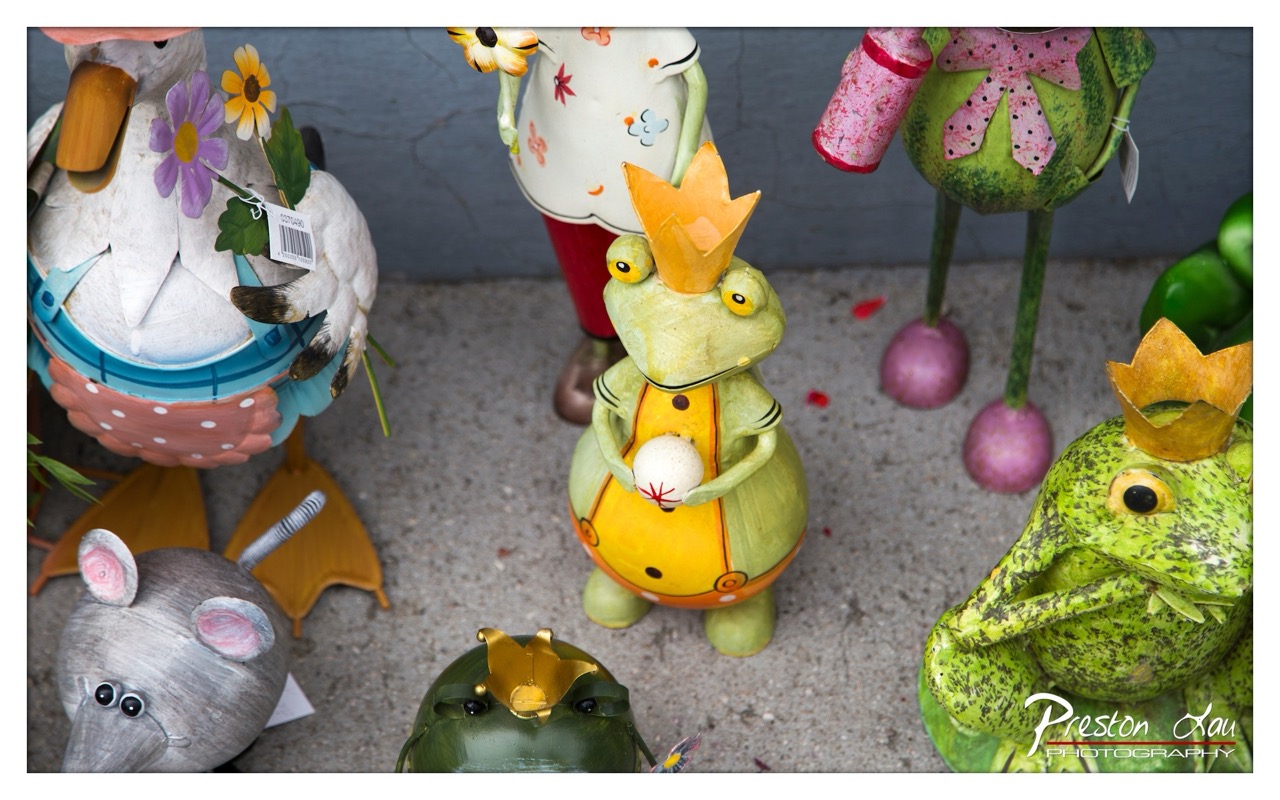

1. Overall Rating (0–10) — 7.0
This photograph captures a whimsical collection of hand-painted garden figurines, where playful detail and vibrant textures create a sense of childlike wonder. The variety of characters—frogs, a duck, a mouse—arranged in a casual, slightly cluttered display, feels like a peek into a charming outdoor shop or garden vignette. While the composition leans toward the busy, the image’s charm lies in its unpolished authenticity and the subtle narrative implied by the characters’ expressions and poses. A more deliberate framing could elevate the focus, but as it stands, the photograph exudes a warm, nostalgic appeal.
2. Composition (0–10) — 6.5
The arrangement feels naturally scattered, with figures placed at varying depths and angles. While this creates a sense of spontaneity, the lack of a clear focal point and the presence of distracting elements—like the tag on the duck and the cluttered foreground—reduce visual cohesion.
3. Lighting (0–10) — 6.0
Natural daylight illuminates the scene evenly, highlighting the textures and paintwork of the figurines. However, the lighting is somewhat flat and diffused, lacking strong directional shadows that might add depth or drama.
4. Color & Tone (0–10) — 7.5
The palette is rich and varied, with bright yellows, greens, and pinks standing out against the neutral gray background. The colors are saturated and lively, reinforcing the playful tone of the subject matter. Some tonal contrast between the figures and the ground enhances visibility.
5. Creativity (0–10) — 8.0
The photographer captures a unique, narrative-rich moment, turning ordinary garden decor into a storybook tableau. The use of whimsical characters and their expressive designs demonstrates a strong sense of artistic intent and originality.
6. Technical Quality (0–10) — 8.0
The image is sharp and well-focused, with clear details in the paint textures and individual elements. The depth of field is appropriate, keeping the central figures in focus while softly blurring the periphery.
7. Emotional Impact (0–10) — 7.0
The photograph evokes a sense of nostalgia and delight, inviting viewers to recall childhood stories or garden memories. The cheerful, handcrafted nature of the figures creates a warm, affectionate connection, though the emotional resonance is slightly tempered by the cluttered presentation.
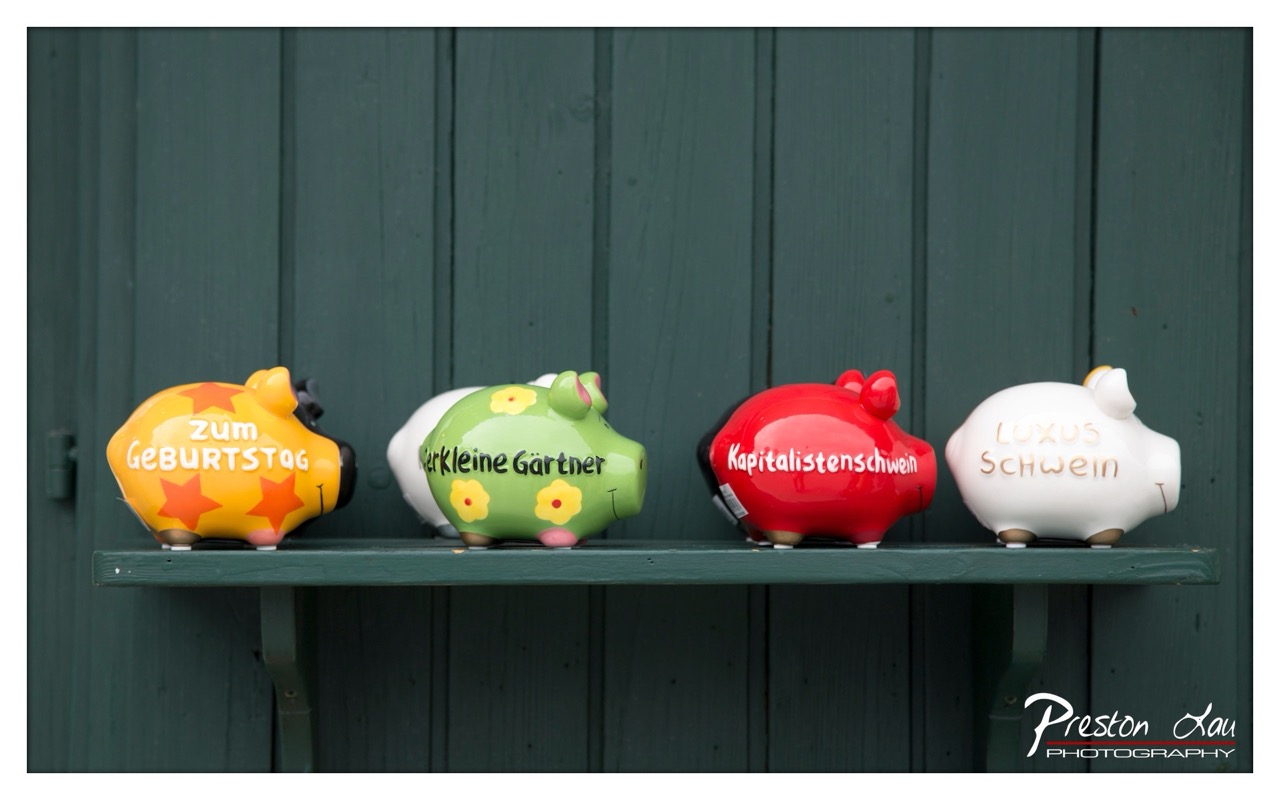

1. Overall Rating (0–10) — 7.0
This photograph presents a playful yet pointed commentary on German cultural and economic themes through a lineup of ceramic piggy banks, each inscribed with symbolic text. The arrangement on a simple wooden shelf against a dark green paneling creates a clean, visually cohesive tableau, while the varied colors and inscriptions add narrative depth. While the concept is clever and the image is well-composed, the execution leans slightly toward literalness, preventing it from achieving a more elevated artistic resonance.
2. Composition (0–10) — 7.5
The piggy banks are aligned horizontally with balanced spacing, creating a rhythmic visual flow. The shelf acts as a natural leading line, drawing the eye across the subjects. The dark background provides strong contrast, allowing the colorful piggy banks to stand out, though the slight overlap of the second piggy bank creates a minor compositional imbalance.
3. Lighting (0–10) — 7.0
The lighting is even and soft, likely natural daylight, which enhances the colors without creating harsh shadows. The diffuse light allows for clear visibility of the inscriptions and textures, while the subtle highlights on the glossy surfaces add a touch of visual richness.
4. Color & Tone (0–10) — 8.0
The palette is vibrant and varied, with the yellow, green, red, and white piggy banks creating a dynamic visual contrast against the muted green background. The color choices are deliberate and playful, reinforcing the thematic diversity. The tonal balance is solid, with sufficient contrast to distinguish each element clearly.
5. Creativity (0–10) — 8.5
The concept is highly original, using everyday objects—piggy banks—as vehicles for political and cultural satire. The German inscriptions ("Zum Geburtstag," "Der kleine Gärtner," "Kapitalistenschwein," "Luxus Schwein") layer humor and critique, transforming a simple still life into a commentary on capitalism, consumerism, and national identity. The creative intent is both clear and thought-provoking.
6. Technical Quality (0–10) — 8.0
The image is sharp and well-focused, with clean details on the piggy banks and readable text. The depth of field is appropriately controlled, keeping the foreground subjects crisp while softly blurring the background. The watermark is discreet and does not interfere with the composition.
7. Emotional Impact (0–10) — 6.5
The image elicits a sense of irony and subtle critique, inviting viewers to reflect on the contradictions of modern German society. While the humor and satire are effective, the emotional resonance is more intellectual than visceral—there is a quiet amusement rather than a deep emotional pull.
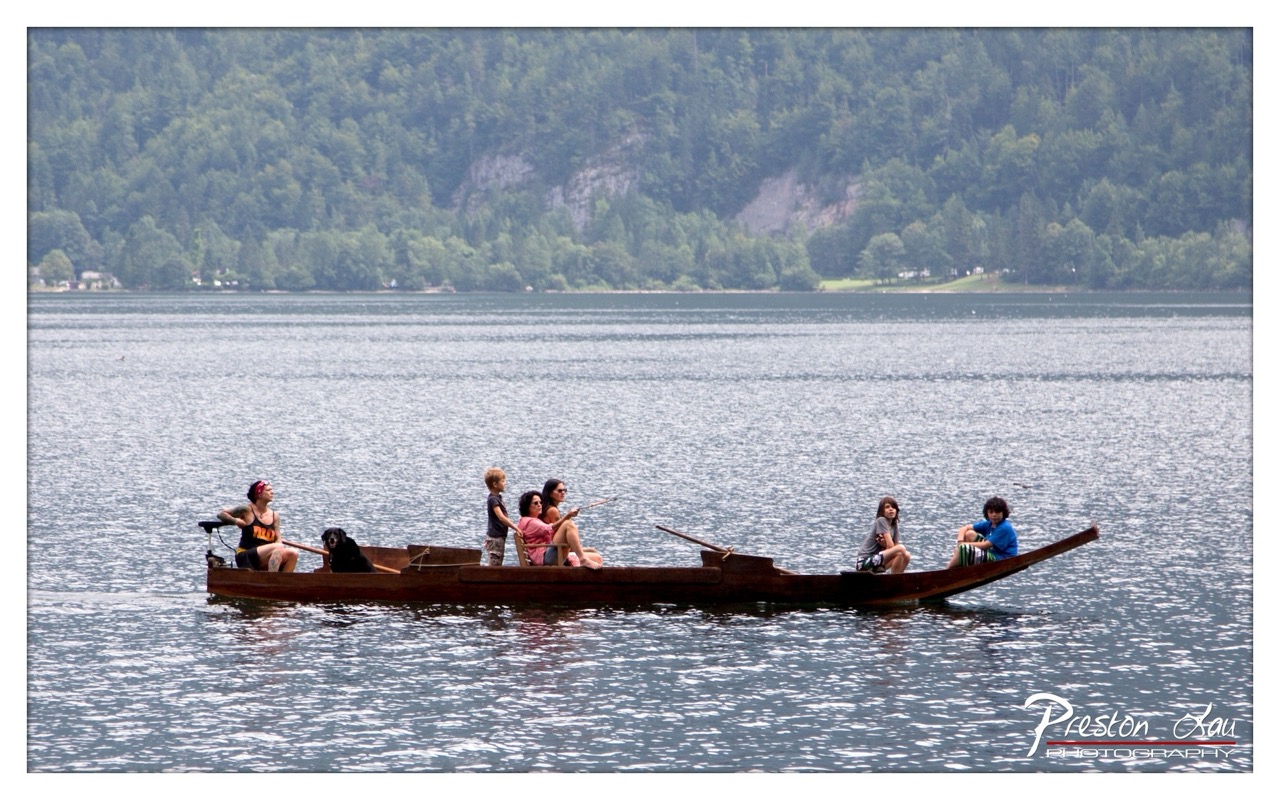

1. Overall Rating (0–10) — 7.0
This photograph captures a serene moment of shared adventure on a lake, where a diverse group of people and a dog glide across calm waters under a soft, overcast sky. The composition balances human presence with the vastness of nature, evoking a sense of quiet companionship and leisure. While the image lacks dramatic lighting or bold color, its authenticity and tranquil mood lend it quiet charm, though a more dynamic focal point might elevate its visual impact.
2. Composition (0–10) — 6.5
The long, horizontal boat creates a strong leading line across the frame, guiding the eye from left to right. The subjects are arranged in a natural, unposed way, but the central placement of the group slightly disrupts the balance, with the foreground and background feeling somewhat disconnected due to the wide spacing.
3. Lighting (0–10) — 6.0
The diffused, overcast light evenly illuminates the scene, minimizing harsh shadows and allowing for soft detail across the water and forested backdrop. While the lighting is even and flattering, it also contributes to a muted, somewhat flat atmosphere that limits depth and mood.
4. Color & Tone (0–10) — 6.5
The palette is dominated by cool blues and greens, creating a harmonious and calming effect. The dark wood of the boat provides a grounding contrast, while the subtle pops of color from the passengers' clothing add visual interest. However, the overall tone leans toward desaturation, slightly dampening the vibrancy of the scene.
5. Creativity (0–10) — 7.0
The image captures a candid, slice-of-life moment with a naturalistic approach. The inclusion of a dog and the variety of ages and postures lend narrative depth, suggesting a story of shared experience. While not radically original, the photograph succeeds in portraying a peaceful, inclusive journey.
6. Technical Quality (0–10) — 7.5
The image is sharp and well-focused, with clear detail in the water’s ripples and the texture of the boat. The exposure is balanced, and the white balance appears accurate for the overcast conditions. There are no visible technical flaws, though the slightly soft focus on the far background suggests a moderate depth of field.
7. Emotional Impact (0–10) — 7.0
The photograph evokes a sense of calm, connection, and quiet joy, drawing the viewer into a peaceful moment of togetherness. The stillness of the water and the relaxed postures of the people create a meditative quality, inviting reflection on simple, shared experiences.
Loading map...